August 31, 2019
Prom 55: Handel's Jephtha
Ruth Smith’s assessment of Handel’s last wholly new oratorio, Jephtha, has not been shared by all her fellow Handel scholars. Composed by the aging composer in 1751, during a time when the onset of blindness forced Handel to put the score aside for a while, Jephtha has been criticised mainly on account of what is perceived to be Thomas Morell’s weak libretto. The substitution of a lieto fine courtesy of a descending angel for the Old Testament’s brutal sacrifice of a military hero’s daughter was judged by Paul Lang to be ‘nearly fatal to the oratorio’, and by Winton Dean to lend ‘a morbid emphasis on virginity’.
Interestingly, the story of Jephtha, the leader of the Israelites who inadvertently and tragically vows the sacrifice of his daughter after a victory against the heathen Ammonites, drew the attention of Voltaire (in the Philosophical Dictionary) who viewed it as confirmation that his ‘Enlightened’ contemporaries should strive for a civilised humanism in contrast to such biblical brutalities and barbarism (and as an opportunity to attack the Jesuits). But, as Smith has observed, Morell was a poet, an Anglican priest and a Doctor of Divinity, and as such was, in contrast, concerned to use the oratorio form as a ‘contribution to the defence of Christianity’.
In this swift and sometimes rather stern Proms performance by the Scottish Chamber Orchestra and SCO Chorus, conducted by Richard Egarr, such moral and theological issues were essentially by-the-by; and, as Egarr strove for energy and momentum perhaps, too, some of the work’s human anguish was glossed over, and the emotional interaction between the protagonists in this tragedy-turned-triumph weakened. But, this was still a compelling account, characterised by superb choral singing and the direct communication of events by a well-matched and accomplished team of soloists.
I haven’t always found that Handel’s oratorios and operas ‘work’ well in the Royal Albert Hall: last year’s Theodora (also with a libretto by Morell), for example, was somewhat lacking in dramatic impact and propulsion. On this occasion, sensibly, what I described as the ‘exquisitely beautiful poise and sensitivity’ of the period-instrument Arcangelo was replaced by the more urgent, impulsive and vibrant sound of the Scottish Chamber Orchestra - a sound which carried with more vigour, with punchy accentuation, strong dynamic contrasts and strikingly dark colourings at times, though Egarr ensured that the strings’ bowing was idiomatically stylish, and the tone did not lack Baroque bite.
Many numbers were omitted (particularly choruses - even one reproduced in the Proms programme was excised) and da capos were frequently truncated or deprived of their contrasting B sections - but the swiftness bestowed a freshness and resolve fitting for this dramatic episode from the Book of Judges, in which Jephtha accepts the Elders’ entreaty that he lead Israel in war against the tyrannical Ammonites on condition that he remain Israel’s leader after the war, and vows that if he is victorious then the first thing that greets him on his return home will be Jehovah’s, offered as a burnt sacrifice. Morell created additional characters - Storgè and Zebul, Jephtha's wife and brother respectively, and Hamor, a young soldier in love with Iphis (Jephtha’s daughter, so-named by Morell).
It was a pity, though, that the SCO Chorus’ contribution was curtailed, so spirited were they as priests, virgins and commentators, so vivid are Handel’s choruses. The diction of the collective was superb - no mean feat in the RAH - and each time the choric voices entered there was a dramatic and emotive ‘uplift’: from their first optimistic denunciation of the Ammonites whose demise they brightly anticipate; to the imitative intensity - wonderfully sculpted by Egarr - of the end-of-Act 1 pugnacious eagerness - coloured richly by the horns; to the skilfully balanced vocal reflections on the Lord’s decrees which follow Jephtha’s acknowledgement that his vow must be fulfilled. Here, the strings’ tight dotted-rhythms accrued a tension which exploded with the tenors’ and sopranos’ culminating vehement blast, “Whatever is, is right”. Emphasising, through silence and disjointedness, the shocking bluntness of this cry, Egarr paradoxically and provokingly suggested doubt rather than moral or theological certainty.
Cody Quattlebaum’s firm bass-baritone was the first solo voice that we heard and, as Zebul, his eloquence and directness was an engaging invitation to the drama. In the title role, Allan Clayton’s relaxed legato line conveyed an assured authority without imperiousness, though perhaps he did not entirely convince as a ‘military hero’. Egarr, almost hyperactive in his multi-role as harpsichordist, conductor and energiser, ensured that the SCO contributed much to the emotional spirit of the arias, and one could appreciate this in Jephtha’s Act 2 ‘Open thy marble jaws, O tomb’, when he realises the nature of the sacrifice his vow will compel him to make; here, the tautness of the unison strings’ rhythms and the darkly driving cello and bass line in the B section of the da capo conveyed all of victorious warrior’s inner conflict between resistance and submission. Similarly, reflecting on the pain that pierces “a father’s bleeding heart” when confronted with Iphis’ acceptance of her fate, Jephtha’s plaguing guilt was evoked by the strings’ full, emphatic pulsing beneath Clayton’s resolute melody. In contrast, ‘Waft her, angels, through the skies’ - one of Handel’s supreme, time-stopping melodies - unfurled with exquisite beauty and lightness.
As Hamor, counter-tenor Tim Mead was as, if not more, impressive, singing with sweetness and strength of his unfulfilled passion for Iphis’, and finding a wealth of colour in his duet with his beloved. In the latter role, soprano Jeanine De Bique displayed a pleasing tone and a clear focus, communicating a fitting purity and innocence but lacked variety of colour and nuance. Her final aria, ‘Farewell, ye limpid springs and floods’ did not suggest the inner torment that Iphis surely must feel, despite her avowed anticipation of heavenly peace.
Both De Bique and Hilary Summers struggled a little to project to the far reaches of the Hall, but Summers was a composed and very expressive Storgè, whose maternal reflections on the injustice of her daughter’s fate were compelling - again, the emotional import was underscored by Egarr’s encouragement of the double basses’ dark throbbing.
The ensembles were urgent, the Act II quartet surging segue from Hamor’s aria in which he offers his own life to save Iphis, and the Act III quintet bursting with joy. (Donald Burrows suggest that this quintet ‘All that is in Hamor mine’ - not ‘is mine’ as misprinted in the programme - is of doubtful authorship and was added in 1756.) The angelus ex machina had intervened in the form of Rowan Pierce’s sparkling, soaring saviour, promising Jephtha that he can fulfil his vow without sacrificing his daughter … if he dedicates her to God in ‘Pure, angelic, virgin-state’, for ever. One might question the ‘happiness’ of this ending, especially on Hamor’s behalf, but here the jubilant voices of the SCO Chorus rang out, rejoicingly, “in blessings manifold”.
Claire Seymour
Handel: Jephtha
Jephtha - Allan Clayton, Iphis - Jeanine De Bique, Storgè - Hilary Summers, Hamor - Tim Mead, Zebul - Cody Quattlebaum, Angel - Rowan Pierce, Conductor - Richard Egarr, Scottish Chamber Orchestra Chorus and Scottish Chamber Orchestra.
Royal Albert Hall, South Kensington, London; Friday 30th August 2019.
image=http://www.operatoday.com/The%20Scottish%20Chamber%20Orchestra%2C%20SCO%20Chorus%2C%20conductor%20Richard%20Egarr%20and%20soloists.JPG image_description= product=yes product_title=Prom 55: The Scottish Chamber Orchestra, SCO Chorus, conductor Richard Egarr and soloists perform Handel’s Jephtha. product_by=A review by Claire Seymour product_id=Above: The Scottish Chamber Orchestra, SCO Chorus, conductor Richard Egarr and soloistsPhoto credit: BBC/Chris Christodoulou
August 29, 2019
Opera della Luna's HMS Pinafore sails the seas at Wilton's Music Hall
As company founder and director Jeff Clarke explains in the programme for the show’s current tour, the company’s first 60-minute version of HMS Pinafore was designed for performance on board the QE2, in 1997. Performances for the Covent Garden Festival in 2000 and 2001 restored 20 minutes of the previously omitted material. When a decision was made, in 2001, to prepare a ‘full-length’ version with interval, the company determined upon the original 1878 version and ‘put back all the cuts, to preserve our stream-lined version as the core and to add a new interpolated opening and closing sequence’.
The resulting palimpsest, complete with some ‘judicious re-arrangement of the chorus material’, has been pleasing audiences ever since, and the punters at Wilton’s Music Hall showed their obvious delight, appreciation and approval during and after this lively rendition.
Some might like their satire served up in modern manifestation, but (sadly) some things never change, and the English class system can furnish twenty-first century humourists with as much idiocy and injustice for lampooning as their historical predecessors enjoyed. After all, the current Leader of the Commons is more commonly known as the Honourable Member for the 18th century.
Moreover, with mendacity seemingly the default mode of many of today’s politicians and leaders, the gentlemanly Captain Corcoran’s vacillation between truth and falsehood - “What, never?” CAPT.: “No, never!” ALL: “What, never?” CAPT.: “Hardly ever!” - seems absolutely in tune with the times. And, with Brexiteers blustering and rhapsodising along the lines of “We are a great nation and a great people”, it’s rather wry, though somewhat depressing, to be reminded by W.S. Gilbert that there have long been those who have failed to see the absurdity of regarding one’s nationality as an ‘achievement’ to be celebrated, rather than an accident of birth: as the ship’s crew joyfully crow of Able Seaman Ralph Rackstraw, “And it’s greatly to his credit/ That he is an Englishman! … For he might have been a Roosian,/ A French, or Turk, or Proosian, … But in spite of all temptations/ To belong to other nations,/ He remains an Englishman!”
In fact, Clarke moves the action not forward, but back, to the days of Dickens, justifying this transposition by reference to numerous Dickensian resonances: ‘One of Dickens’ Sketches by Boz tells of a snobbish resident by the name of Mrs Joseph Porter. Another describes a marine-store dealer in Seven Dials and lists the contents of his store: handkerchiefs, ribbons, a small tray containing silver watches, snuff, tobaccy boxes - in fact the very inventory of Buttercup’s stock.’ No ‘justification’ is really needed though, for if anyone was concerned with the efforts, and accompanying risks, of the lower strata of the middle class to rise from being tradesmen and upper servants, and the gap between the practices of this new commercial middle class and the principles of morality, then Dickens was.
At Wilton’s, the small cast of eight - there’s some doubling up for Sir Joseph’s various sisters and aunts - expended great energy and sustained a terrific pace. A naval tattoo (Graham Dare, percussion) gets the show underway and as pianist/musical director Michael Waldron and his sailor-suited six-piece band ripped through the overture, so the scattered ropes and tarpaulin were gathered, the ship’s rigging hoisted, and Pinafore made ready to set forth from her mooring bay in Portsmouth harbour.
Matthew Siveter impressed as Captain Corcoran, with his suave baritone, smooth phrasing and self-serving expediency: ‘I am the Captain’ found Siveter in particularly fine voice, and ‘Never Mind the Why and Wherefore’ saw him joined by an effervescent Josephine (Georgina Stalbow) and Graeme Henderson’s outlandish Sir Joseph in a refrain-reprising rejoicing that, threatening to roll on infinitely, took on the slightly desperate but deliciously madcap air of an Eric Morecambe routine.
Elsewhere Stalbow’s diction sometimes dissatisfied and she didn’t always have the heft to carry over the lively band - although, admittedly, I was seated very close to Waldron’s vigorous vamping - but she had plenty of glossiness at the top and her Josephine was warm-hearted. Henderson pushed the camp to the brink, and at times beyond, and brought a dictionary’s-worth of new meanings to the humble wink of an eye.
Louise Crane and Carolyn Allen worked hard, with sterling results, as Little Buttercup and Sir Joseph’s cousin Hebe respectively, while Lawrence Olsworth-Peter brought a youthful tone and a healthy dose of self-irony to the role of Ralph.
So, in summing up all that there’s really left to say is, “Now give three cheers …” for Opera della Luna!
Claire Seymour
Sir Joseph Porter - Graeme Henderson, Captain Corcoran - Matthew Sivester, Josephine - Georgina Stalbow, Ralph Rackstraw - Lawrence Olsworth-Peter, Little Buttercup/Sir Joseph’s sister - Louise Crane, Cousin Hebe - Carolyn Allen, Bill Bobstay - Martin George, Dick Deadeye/Sir Joseph’s aunt - John Lofthouse; Director - Jeff Clarke, Musical Director - Matthew Waldron, Set Designer - Graham Wynne, Costume Designer - Nigel Howard, Lighting Designer - Ian Wilson, Choreographer - Jenny Arnold, The ‘massed band of the Pinafore’ (violin - Rachel Davies, cello - Rosalind Acton, flute/piccolo - Gavin Morrison, clarinet - Simon Briggs, bassoon - Sinéad Frost, percussion - Graham Dare).
Wilton’s Music Hall, London; Wednesday 28th August 2019.
image=http://www.operatoday.com/Matthew%20Siveter%20and%20Louise%20Crane.jpg image_description= product=yes product_title=HMS Pinafore: Opera della Luna at Wilton’s Music Hall product_by=A review by Claire Seymour product_id=Above: Matthew Siveter (Captain Corcoran) and Louise Crane (Little Buttercup)Spectra Ensemble present Treemonisha at Grimeborn
But, Joplin’s opera, for all its dramatic defects, is an important work, for musical and non-musical reasons, and it was good to see Spectra Ensemble bringing the work to the Grimeborn festival at the Arcola Theatre.
Initially labelled a ‘folk opera’, Treemonisha was subsequently described by its composer as ‘not ragtime … the score complete is grand opera’. In fact, the score mingles a quasi-Wagnerian palette with folk tunes, ballads, barbershop, gospel and even the music of the circus. Contemporary critics missed the point when they denigrated it as a poor imitation of European opera, for its hybridity might be seen as an attempt by ‘The King of Ragtime’ to forge a new, distinctly ‘American’ musical language, while its use of American themes, anticipates works such as Porgy and Bess, Oklahoma, and Carousel.
Written in 1911, set in Arkansas in the 1880s, and reflecting Joplin’s own experience as a young African American during the Reconstruction period, Treemonisha had to wait until more than fifty years after Joplin’s death for its premiere, at the Atlanta Memorial Arts Center on 28 th January 1972. It wasn’t the composer’s first opera: a single-act work comprising twelve ragtime tunes, A Guest of Honor, was completed in 1903 but Joplin’s publisher refused to publish it and there is no extant score. Joplin chose to publish Treemonisha himself and included a lengthy preface which provides details of the character and setting, and explains his ‘leitmotivic’ method.
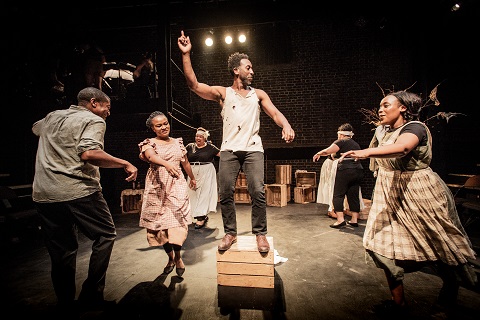 Devon Harrison, Caroline Modiba, Deborah Aloba, Andrew Clarke, Aivale Cole and Grace Nyandoro. Photo credit: Robert Workman.
Devon Harrison, Caroline Modiba, Deborah Aloba, Andrew Clarke, Aivale Cole and Grace Nyandoro. Photo credit: Robert Workman.
The opera is very much of its time, presenting a plantation community of freed slaves who fall prey to a ‘conjuror’, Zodzetrick, and his side-kick, Luddud, who exploit the simple folk’s gullibility and sell them ‘bags of luck’ to ward off evil spirits. The community is ‘saved’ by Treemonisha. Found under a tree, and adopted by a good-hearted couple - Ned, who manages the plantation for its white absentee landlord, and his wife Monisha - she has received an education from a white lady in town in exchange for her laundry services. She now sets about educating her fellow folk, challenging their superstitious beliefs. Fearful that Treemonisha’s enlightening effect will be bad for business, the conjurors first threaten and then abduct Treemonisha. She is rescued by one of her pupils, Remus, and, having urged her community to spare the kidnappers a brutal punishment, Treemonisha is then elected their leader.
The main studio at the Arcola Theatre is a challenging space within which to conjure a plantation deep in a forest in Arkansas. The brick walls of the former paint factory don’t lend themselves to a depiction of rural life, but director Cecilia Stinton and set/costume designer Raphaé Memon succeed in creating a credible, somewhat homey - and homely - community, by means of a few wooden crates and a paper tree-sculpture. But, figuratively, the ‘earth’ needs, I feel, to be a stronger presence: Stinton doesn’t draw out the community’s conflicting feelings, their joy at their new freedom being countered by a confusing love for the very land that once held them prisoner. Perhaps Ali Hunter’s lighting might have done more to evoke the colour and textures of the land?
With the musicians perched on the mezzanine above the thrust stage, Stinton makes effective use of the space beneath, and of the steps leading out of the auditorium, to suggest different locale, though briefly projected ‘titles’ might have been useful. Moreover, Joplin, who wrote both the score and libretto, distinguishes the characters by using dialect for the ‘uneducated’ folk, but whether the Spectra cast observed this distinction I could not tell, for the diction was not always clear.
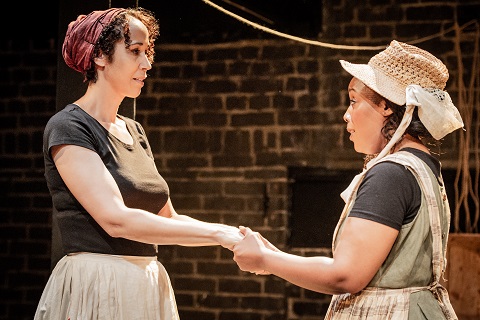 Samantha Houston (Monisha) and Grace Nyandoro (Treemonisha). Photo credit: Robert Workman.
Samantha Houston (Monisha) and Grace Nyandoro (Treemonisha). Photo credit: Robert Workman.
But, while some of the characters remained emblematic, others were given a dignity which raised them above stereotype. Grace Nyandoro’s soprano has a strength and a shine that conveyed Treemonisha’s integrity, vision and resilience, and her final acceptance of the leadership of the community was emotive and heart-warming. As Parson Alltalk, bass Rodney Earl Clarke delivered a powerful ‘sermon’, ‘Wrong is Never Right’, and doubled as a steadfast Ned, partnered by Samantha Houston as Monisha. The duet in which they tell Treemonisha of her origins was touching, though Houston did not, I felt, suggest the real melancholy that lingers in Joplin’s music. Zodzetrick was sung with power by Njabulo Madlada, his voice adding a touch of real menace that was largely missing from the production itself. Tenor Edwin Cotton struggled a little with the higher lying passages of Remus’s vocal lines, but acted spiritedly, while mezzo-soprano Caroline Modiba sang with fullness and smoothness as Lucy, Treemonisha’s friend.
There was a certain cautiousness about this first-night performance, though; the ensembles, in particular, were lacking in the sort of vigour that would have communicated the real spirit of the community, and the dances were somewhat conservative. ‘The Bag of Luck’ which introduces the main characters at the start of Act 1 should surely make a more vibrant impact. Perhaps it was just a case of opening night prudence: certainly, there was no hesitancy from the six musicians led by flautist/musical director Matthew Lynch, who played stylishly. Moreover, the light instrumentation (Joplin’s own orchestrated score is lost) created an intimacy complemented by the thrust stage.
Spectra Ensemble gave a good account of Joplin’s opera, but one which didn’t really explore or seek to reveal the African-American socio-political issues that Treemonisha addresses, as issues of race intersect with those of gender, class and sexuality. The opera celebrates education over ignorance and enlightenment over superstition, espousing American-Christian values, and many commentators have observed the broad associations between Treemonisha and the ‘uplift ideology’ of contemporaries such as Booker T. Washington and W.E.B. Du Bois. Joplin was an active member of at least one social-improvement organization, the Colored Vaudeville Benevolent Association, a charitable group founded in New York in 1909. And, after her husband’s death, Lottie Joplin eulogised that he ‘wanted to free his people from poverty, ignorance, and superstition, just like the heroine of his ragtime opera, Treemonisha’.
Stinton’s appealing but somewhat cosily sentimental production overlooked the undercurrents which give the opera - especially its closing chorus and dance, ‘A Real Slow Drag’ - its sad wistfulness. After all, as Rick Benjamin - conductor of New World Records’ centenary-celebrating recording in 2011, and a leading authority and interpreter of ragtime music - has observed, Treemonisha ‘is truly a rare artifact of a vanished culture: an opera about African-Americans of the Reconstruction era - created by a black man who actually lived through it’.
Claire Seymour
Scott Joplin: Treemonisha
Spectra Ensemble
Andy - Andrew Clarke, Ned/Parson Alltalk - Rodney Earl Clarke, Remus -
Edwin Cotton, Monisha -Samantha Houston, Zodzetrick - Njabulo Madlala,
Luddud - Denver Martin Smith, Lucy - Caroline Modiba, Treemonisha - Grace
Nyandoro, Chorus (Deborah Aloba, Aivale Cole, Devon Harrison); Director -
Cecilia Stinton, Music Director - Matthew Lynch, Designer - Raphaé Memon,
Lighting Designer - Ali Hunter, Choreographers - Caitlin Fretwell
Walsh/Ester Rudhart, Sarah Daramy-Williams/Elodie Chousmer-Howelles
(violin), Zara Hudson-Kozdoj (cello), Gwen Reed (double bass), Berginald
Rash (clarinet).
Grimeborn at the Arcola Theatre, London; Tuesday 27th August 2019.
image=http://www.operatoday.com/Grace%20Nyandoro%20%28Treemonisha%29.jpg image_description= product=yes product_title=Spectra Ensemble present Scott Joplin’s Treemonisha at Grimeborn product_by=A review by Claire Seymour product_id=Above: Grace Nyandoro (Treemonisha)Photo credit: Robert Workman
August 28, 2019
Fortieth Anniversary Gala of the Rossini Opera Festival in Pesaro
Few of these globetrotters come for Pesaro’s mediocre restaurants, beaches or tourist sites. Nor is the venue special. In contrast to Macerata’s romantic outdoor space, this gala took place in a bland auditorium constructed inside a suburban multi-purpose arena named after a local producer of commercial refrigerators.
Everyone came to hear great performances of works by Gioachino Rossini, whose birthplace Pesaro is. The last four decades have witnessed a revolution in Rossinian performance-practice, based largely on new critical editions of lesser-known works and fresh insights into vocal style. Many of these innovations were pioneered at the Rossini Festival. What better place to assess the state of the Rossinian art?
Singing Rossini is harder than it seems. His operas may seem on the surface to be naïve and uncomplicated. Yet underneath lies much craft, cunning, wit, depth – as well as formidable technical difficulty. To portray all this with effortless charm poses exceptional challenges and opportunities for singers – and universally loved experiences for audiences.
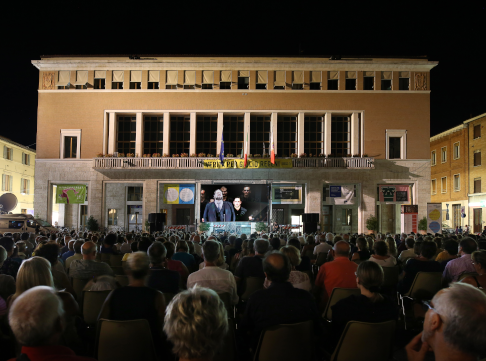
This gala contained excerpts from Rossini’s most famous operas. The first half drew on three madcap comedies (Il Barbiere di Siviglia, La Cenerentola, and L’Italiana in Algeri) for which he is best known. These works bring to life enduring stereotypes of Italian life dating back to commedia dell’arte: the foolish old man, the conniving servant, the blustering military officer, the honorable gentleman, the greedy man of means, and the romantic young lover. After intermission, the evening continued with selections from two serious operas (Ermione and his culminating work for the stage , Guillaume Tell), heroic works of genuine idealism that set the stage for the more overtly political and romantic operas of Giuseppe Verdi.
The program was promising. Yet throughout the evening in Pesaro, the spirit of Rossini remained surprisingly elusive.
The tone was set from the start, with the Sinfonia (overture) to the Barbiere of Seville. Unlike the famous overture to Guillaume Tell, given a slightly more satisfying performance in the second half, this is not a concert piece as much as a farcical buffo aria. Each of its sections – grand chords, a bucolic melody, a plaintive complaint, a raging storm, two long crescendos, and a dashing finale – come pell-mell on top of one another, with no real underlying logic. To capture this crackling spirit, the formal correctness of Rossini’s musical language must be balanced with a sense of zany improvisation.
The Orchestra Sinfonia della RAI played reasonably well and some woodwind solos and the precise articulation of the upper strings were superb. Yet veteran conductor Carlo Rizzi encouraged them to play like a symphony orchestra, not a pit band. Torpid and unvarying tempos (rests carefully counted out), an earnest emphasis on sonic beauty, and an even dynamic drained the piece of all its wit and sparkle.
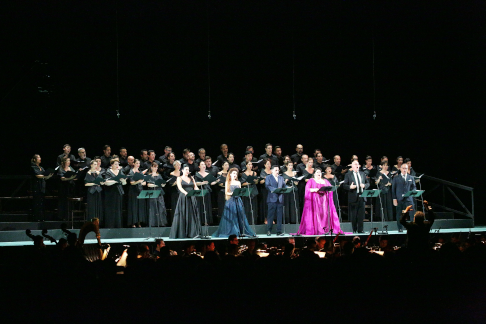
Much of the evening proceeded in this way, also on the vocal side. Singer after singer seemed unable to capture Rossini’s vivid and witty musical-dramatic caricatures. Franco Vassalio offered astonishingly dull versions – cautiously read from the music – of Rossini’s two greatest baritone arias: “Largo al factotum” (Barbiere) and “Sois immobile” (Guillaume Tell). The first lacked personality, the second pathos .
Paolo Bordogna’s account of Barolo’s archaic rant, “A un Dottor della mia sorte,” lacked appropriate vocal resonance (is he a bass at all?) or any inkling of how perfectly Rossini captured for all time the absurd futility of an angry dad lecturing a rebellious teenage girl. Bordogna suffered by comparison to veteran Michele Pertusi, who contributed only to the ensembles yet demonstrated clearly how resonant a genuine Italian bass should sound.
Russian mezzo Anna Goryachova and her tenor compatriot Ruzil Gatin (?), a last minute replacement, sang solidly but unremarkably: she produced resonant low tones and he harsh high ones.
Even American tenor Lawrence Brownlee, a wonderful singer at his best, seemed to be a bit off his game. One has to admire his courage in leading off with “Cessa di più resistere” from Barbiere – an aria so long and demanding that most tenors refuse ever to perform it. Yet Brownlee’s voice was pinched throughout and the opening segment off-pitch. In the slow romantic middle section, he recovered, phrasing with poignant delicacy, yet the vocal acrobatics in the finale were no more than solid.
It fell to the three remaining singers to save the evening.
Superstar Rossinian tenor Juan Diego Flórez contributed one showpiece to each half of the program, the elegant “Sì, ritrovarla io guiro” from Cenerentola and the heroic “Asile héréditaire” from Tell. Flórez is an assured vocal superstar: his rock-solid technique, accurate intonation, clear diction and, above all, ringing high “money notes.” In recent years, moreover, Flórez has enhanced his ability to sing softly with real musicality.
Yet whereas the first aria deserved the ringing ovation it received, the second disappointed. Flórez’s voice, impressive though it is within its natural domain, just seems too light for a role in which the orchestral sound and vocal demands verge on those of middle-period Verdi. Flórez seemed uncharacteristically cowed: at times he failed to penetrate the orchestra, his dynamics and tempi varied little, his pleas for Swiss patriots to “Suivez-moi” seem unpersuasive, and he cut short the final (interpolated) high C.
More impressive was Angela Meade, a leading bel canto soprano from the US state of Washington who has recently moved on to Verdi. With maturity, Meade’s voice has gained astonishing size and weight: in the inspirational final ensemble from Tell, her rich tone penetrated effortlessly to the back wall of the auditorium through five soloists, an orchestra and chorus, all at fortissimo. She sang each word and shaped each phrase (recitatives as much as arias and ensembles) with unabashed passion and musical-dramatic intelligence. Her scena from Ermione was marred only by a tendency to flat high notes.
Yet the highlight of the evening came at an unexpected moment midway through the first half. Sicilian baritone Nicola Alaimo, a Pesaro regular, strolled on stage and effortlessly performed the aria that opens Act II of Cenerentola. It is Rossini at his most wittily and cynically Italian: striving Don Magnifico dreams of marrying his daughter to an important man so he can live a life of cozy corruption, surrounded by supplicants who offer money (and more) in exchange for political favors.
For five minutes, Alaimo inhabited the scheming father with no inhibitions. I have heard versions with more accurate buffo patter and with high notes, but it did not matter. His gestures, almost conversational phrasing, and superb vocal acting captured the Rossinian spirit. Even a friend beside me who had never heard the aria and (given the lack of supertitles) did not comprehend a word, immediately felt the fleeting magic of the moment.
Overall, however, the 40th anniversary gala was uneven, giving as much cause for concern as celebration about the future of Rossini singing.
Andrew Moravcsik
image=http://www.operatoday.com/V12A8435.png image_description=Angela Meade [Photo by Studio Amati Bacciardi] product=yes product_title=Fortieth Anniversary Gala of the Rossini Opera Festival in Pesaro product_by=A review by Andrew Moravcsik product_id=Above: Angela MeadePhotos by Studio Amati Bacciardi
Berthold Goldschmidt: Beatrice Cenci, Bregenzer Festspiele
Sometime after Goldschmidt’s death, I found a trove of his recordings and those by other modern composers in a small local Oxfam. I bought as much as I could afford but told everyone. Suddenly, someone with more money than me swooped them all up. Later, talking to the composer Kalevi Aho, we deduced that the 200 or so CDs must have belonged to Goldschmidt himself since all the other composers were connected to his personal circle of associates. It may have been the clearance of his estate. Luckily, I did manage to grab what might have been Goldschmidt’s own copy of Beatrice Cenci, with Lothar Zagrosek conducting the Deutsches-symphonie Orchestra, Berlin, from the world premiere in August 1994, when Ian Bostridge sang the small part of the Page at the Villa Cenci orgy.
Goldschmidt’s Beatrice Cenci recounts a real-life scandal. Count Francesco Cenci, a renaissance nobleman, was fabulously rich, but violent. Because he was so powerful, he got away with raping his teenage daughter, Beatrice, who was eventually beheaded for killing him. Though Goldschmidt and his librettist based their version on a play by Percy Bysshe Shelley, the story is universal, and sadly, all too relevant to our times. Too much can be made of Goldschmidt’s connections with Weimar Germany, from which he emigrated aged only 33. He spent the next 60 years of his life in Britain. Beatrice Cenci is a work of its time, written for the 1951 Festival of Britain, when the concept of courage against injustice was recent memory. Goldschmidt maintained that his music was not programmatic but rooted in relationships with people and was particularly sensitive to the way that women were treated in patriarchal societies. “My works”, he wrote “have always come about as an interchange with the feminine in all its facets. That is the aura in which I compose”.
In Goldschmidt’s Beatrice Cenci, Count Cenci’s arrogant sense of entitlement is compounded by all around him, from his servants to the Courts and to the Papacy. The introduction is brief, but magnificent, but as anyone familiar with Schreker and Zemlinsky, Goldschmidt’s predecessors, will know, lush does not mean romantic. Almost immediately, sharp, tense chords intervene. Lucrezia’s (Dshamilja Kaiser) lines are shrill, rising high on the register, swooping downwards: an air of unsettled alarm. She’s Count Francesco’s second wife, not Beatrice’s mother, but she knows he’s a tyrant, and that wrong. Beatrice (sung by Gal James) at this stage has softer, less assertive tones. Bernardo (Cristina Bock), Beatrice’s full brother, is also cowed, burying his head on Beatrce’s lap. “Ours is an evil lot, and yet” sings Beatrice “let us make the most of it”. The cry of abused children, everywhere.
Enter Cardinal Camillo, (Per Bach Nissen) whose lines swagger, rolling figures built into the part, coiling like a snake. He’s covered up a murder for Cenci (sung by Christoph Pohl), both complicit in evil. Pohl’s baritone smoulders yet has a lethal edge: the character’s nasty business. Beatrice places her hopes in Orsino (Michael Laurenz) a young priest – forbidden territory! He’s in love with her, so offers to help her. At the Villa Cenci, princes and cardinals are replete after an orgy. Cenci sings “I too am flesh and blood and not a monster, as some would have me”. Yet he proudly announces that he’s killed all his sons. One was killed when a church collapsed on him, another knifed by a stranger, but Cenci’s not bothered. More wine, he calls, and blasphemes. Even Cardinal Camillo says Cenci’s insane, but Cenci threatens him, too. Now Beatrice takes courage, passionately begging the guests to save her from the palace. But Cenci isn’t scared. In a slithering tone he attempts to rape her again.
During the interlude, the open-air stage at Bregenz is filmed, darkness lit by sudden flashes of light – hiding yet alluding to the unspeakable. Lucrezia finds Beatrice, who has gone mad, cradling a doll. “I have endured a wrong so great that neither life nor death can give me rest – ask not what it is”. The voices of stepdaughter and stepmother intertwine, suggesting other unspoken horrors (Lucrezia’s quite young – the many adult children are not hers.) Beatrice talks Orsini into hiring hit men, to free Beatrice from her father. Count Cenci returns, but Lucrezia bars his way. On the Bregenz stage, Cenci wears a diamante penis, big enough that the audience far from the stage get an eyeful. Quietly, Lucrezia slips poison into his wine, and he falls asleep. The hit men come but their job is done, and they throw the body down a wall. Suddenly, Cardinal Camillo returns, surrounded by troops with a warrant for Cenci’s arrest. Concluding that Cenci was killed by Lucrezia and Beatrice, he has them taken off to prison.
Tolling bells introduce the final act. Bernardo and Beatrice are huddled together, Lucrezia with them. The henchmen Orsini hired give witness against Lucrezia, but Beatrice refuses to deny what has happened. “Say what you will, I shall deny no more”. From this point, Goldschmidt’s opera becomes more abstract, more “modern”, psychologically true rather than literal. A distant choir is heard. Cardinal Camillo says that the Pope has denied mercy. The sentence is death. Against the mysterious strains of an orchestral Nocturne, Lucrezia and Beatrice are seen, both crumpled like broken dolls. Beatrice now gets a chance to sing a “mad scene”, which is more poignant than deranged. “Sweet sleep were like death to me…O Welt, Lebewohl”, her words echoed by the orchestra.
A short but dramatic Zwischenspiel introduces the final scene. Carpenters are erecting a scaffold, the orchestra imitating their ferocious blows. An angry crowd gathers, and Lucrezia’s clothes get ripped off (she’s wearing a body suit, for the faint-hearted). Yet Beatrice is strangely calm. “Be constant to the faith that I though wrapped in the clouds of crime and shame lived forever holy and unstained”. Those who want blood and guts will be disappointed as the women just fall dead. But Cardinal Camillo is moved. “They have fulfilled their fate, guilty yet not guilty, thus do evil deed bring evil, crimes bring forth crimes”. He blesses them with a quiet Requiem Aeternum.
Bertold Goldschmidt’s opera is wonderfully taut, more chamber opera than regular opera, so I can imagine future productions that make the most of the claustrophobic atmosphere and the liberating release of death at the end, but this DVD – heard together with the often musically superior Lothar Zagrosek recording – should secure Beatrice Cenci its rightful place in modern repertoire.
Anne Ozorio
image=http://www.operatoday.com/Beatrice_Cenci_DVD.png image_description=C Major 751504 product=yes product_title=Berthold Goldschmidt: Beatrice Cenci (1950) product_by=Gal James, Christoph Pohl, Dshamilja Kaiser, Christina Bock, Prague Philharmonic Choir. Wiener Symphoniker. Johannes Debus, conducting. product_id=C Major 751504 [DVD] price=$31.99 product_url=https://amzn.to/2KZApWLAugust 27, 2019
Verdi Treasures from Milan’s Ricordi Archive make US debut
The exhibition traces the genesis and realization of Verdi’s last two operas, Otello and Falstaff, using original scores, libretti, selected correspondence, set and costume designs, and more. Giuseppe Verdi - alongside Giacomo Puccini, Gaetano Donizetti, Vincenzo Bellini, and Gioachino Rossini - is one of the five great names of 19th century Italian opera whose works were published by Casa Ricordi and documented in its Archivio Storico Ricordi. The Ricordi Archive is regarded as one of the world’s foremost privately owned music collections. The Morgan Library & Museum complements the exhibition with rarities from its own collection, including early editions of texts by William Shakespeare, whose dramaturgical material served as the basis for the operas Otello and Falstaff.
This combination of materials from the two great institutions under the guidance of curators Fran Barulich and Gabriele Dotto gives visitors a unique opportunity to gain first-hand insights into the European cultural scene of the late 19th century. The supporting program of the exhibition also includes a concert with Verdi arias, a screening of Franco Zeffirellis Otello, and a lecture with experts from the Ricordi Archive.
Colin B. Bailey, Director of the Morgan Library & Museum, said: “We are delighted to present these highlights from the Ricordi Archive, showing how Italy’s pre-eminent composer shaped what would become two of his crowning achievements, Otello and Falstaff. A collection of set designs, costumes from Milan’s Teatro alla Scala, autograph manuscripts, contracts, publications, publicity, video excerpts from recent productions, as well as objects from the Morgan’s collection enable visitors to experience the tremendous collaborative efforts behind an operatic production.”
Thomas Rabe, Chairman & CEO of Bertelsmann, said: “The name Ricordi stands for 200 years of Italian opera and music history. As the owners of the Ricordi Archive, we are very aware of the importance of this European cultural asset and take responsibility for its sustained preservation, care and development. Exhibitions like the one in New York, in partnership with the Morgan Library, are a great opportunity to keep the creative work of earlier generations alive and to reach audiences beyond the musicological community.”
The richly textured exhibition “Verdi: Creating Otello and Falstaff - Highlights from the Ricordi Archive” describes the creative process of the two world-famous operas - from initial deliberations about commissioning the celebrated composer to the premieres of Otello in 1887 and Falstaff in 1893. The idea for Otello first arose in 1879, when Verdi was 65, but he did not begin to work on the project in earnest for several more years, when he was in his 70s. There was almost a 16-year hiatus between the 1887 premiere of Otello and the 1871 premiere of Aida. His Milanese publisher Giulio Ricordi teamed up with the librettist Arrigo Boito to develop a diplomatic strategy for luring “the old bear” out of retirement at his country home in Sant’Agata. Their plan worked, and applying his mature compositional skills to two brilliant libretti by Boito, Verdi created two of the greatest operas ever composed. Giulio Ricordi was ultimately responsible for marketing and managing the two large-scale productions. The exhibition thus provides a deep insight into the work of three geniuses who formed a kind of “business community.”
The partnership with the Morgan Library & Museum offers additional material that enriches the Ricordi exhibition: Shakespeare’s First and Second Folios, rare editions of scores and libretti, contemporary publicity material, an autograph letter from Verdi’s wife, and autograph sketches for Otello.
The New York exhibition represents a new milestone in the presentation of the Ricordi Archive to the public: In Verdi Year 2013 - the composer’s bicentennial - the archive’s treasures were first presented in Germany as the curtain-raiser to a traveling exhibition that toured Europe. At the time, the “Enterprise of Opera: Verdi. Boito. Ricordi” exhibition was shown in Berlin and Gütersloh and subsequently in Brussels, Milan and Vincenza. It now forms the basis for the forthcoming exhibition in New York.
The Ricordi Archive houses a total of some 7,800 original scores from more than 600 operas and hundreds of other compositions; approximately 10,000 libretti; an extensive iconographic collection with precious original stage and costume designs; and a vast amount of historical business correspondence of Casa Ricordi. Founded in 1808 by Giovanni Ricordi in Milan, the Italian music publisher had a fundamental influence on the cultural history of Italy and Europe. Bertelsmann, the international media company which also includes the BMG music group and the New York-based trade publishing group Penguin Random House, bought Casa Ricordi in 1994, but sold the music company and Ricordi’s music rights in subsequent years. Only the associated Ricordi Archive remained within the group. Since then, Bertelsmann has had the archived items comprehensively indexed, digitized and, in many cases, restored. The company also organizes concerts and exhibitions to keep Casa Ricordi’s cultural heritage alive and make it accessible to as many people as possible.
Programs:
· Gallery Talks “Verdi: Creating Otello and Falstaff - Highlights from the Ricordi Archive” Friday, September 13, 6pm Friday, November 15, 1pm
· Films, “Otello” Friday, September 20, 7:00pm; “Tosca’s Kiss” Friday, October 18, 7:00 pm
· Family Program Curtain’s Up! Theatrical Design at the Morgan Saturday, September 21, 11:00 am Dance: Inspired by Verdi Saturday, November 9, 2:00pm
· Concerts George London Foundation Recitals Sunday, October 20, 4:00pm
· Lectures and Discussions “Verdi and the Ricordi Archive”: An Evening with Pierluigi Ledda and Gabrielle Dotto Wednesday, October 2, 6:30pm “Le Conversazioni: Films of My Life” Thursday December 5, 7:00pm
For more information about the exhibition, hours, and admission, visit www.themorgan.org.
For more information about the Ricordi Archive visit https://www.archivioricordi.com/en or https://www.bertelsmann.com.
image=http://www.operatoday.com/Ricordi_3141c%20%283%29.jpgAugust 26, 2019
Bel Canto Beauty at St George's Hanover Square: Bellini's Beatrice di Tenda
Same librettist, though. Sadly, circumstances and haste compelled Felice Romani to resort to self-recycling in a manner which deprived the characters of substance and development, and substituted contrivance for dramatic credibility. Struggling to fulfil his role as poet-in-residence at Teatro alla Scala, and with premieres also scheduled for La Parma and Florence, Romani began work on a libretto on Bellini’s initially preferred subject of Queen Christina of Sweden, only for the composer to change his mind. Bellini was influenced by Giuditta Pasta who proposed an opera on the tragic tale of Beatrice Lascaris di Tenda - the wife of Filippo Maria Visconti who succeeded his murdered brother to the Duchy of Milan and used his wife’s personal resources to extend his demesne, before becoming jealous of her first husband’s reputation as a noble soldier and hatching a plot to have Beatrice convicted of adultery and, alongside her supporters, executed.
Romani’s progress was dilatory; the premiere was delayed; a professional partnership and friendship was irreparably damaged. By the time Romani had provided Bellini with a text which essentially translated the amorous and political intrigues of the sixteenth-century Tudor court to fifteenth-century Milan, the public’s hackles were already sharpened and Beatrice di Tenda received a negative reception at its premiere. A public blame-game played by mud-slinging backers of Bellini and Romani followed, and although subsequently attitudes softened, and the opera was heard across Europe, in the US and in Latin America in the ensuing 20 years, thereafter it disappeared into the operatic hinterland.
Ironically, Beatrice di Tenda is well-suited both to a concert staging and for performance by young soloists well-schooled in the art of bel canto singing, as was the case at St George’s Church Hanover Square at the second of two performances which closed the 2019 London Bel Canto Festival. Under its Artistic Director, Ken Querns Langley , a singer, teacher and researcher of bel canto, the Festival serves an academy for young singers to learn bel canto technique and idiom, offers the public an opportunity to hear performances by bel canto trained voices, and supports the creation of new music. The soloists and members of the Chorus had enjoyed masterclasses with Bruce Ford, Nelly Miricioiu and Langley himself, and other events during the 20-day Festival included a ‘Come and Sing’, enabling the public to work on the choruses in Beatrice, a panel-discussion and a gala concert at the National Liberal Club in Whitehall.
The plot is straightforward and the denouement inevitable: Beatrice is married to Filippo who desires the younger Agnese del Maino; the latter is in love with the courtier Orombello, who in turn adores Beatrice. Fearful of a popular uprising in support of Beatrice, Filippo has Orombello and Beatrice imprisoned in the Castle of Binasco; under torture, Orombello confesses to adultery. A tribunal is convened, and despite the guilt with briefly troubles both Agnese and Filippo’s, the Duke’s fear that troops loyal to Beatrice will storm the castle walls leads him to sign her death warrant. She accepts her fate, forgives the repentant Agnese and declares herself ready for death.
The cast worked hard and with considerable success to establish character, dramatic shape and tension. Despite the spatial limitations of the venue, they made full use of St George’s aisles and balconies. It helped, too, that - excepting Brian Hotchkin (Filippo) - they all sang largely and confidently off-score. It was a pity that the music stands, rather redundant for much of the time, were spread so widely, for this discouraged the sort of interaction that, when the singers took things into their own hands and moved towards the centre, lifted the dramatic temperature considerably.
The role of Beatrice is dramatically limited, dignified victimhood being her default mode, but the vocal demands are considerable. Australian soprano Livia Brash has a richly upholstered and luxuriantly coloured lirico-dramtico soprano and she exhibited range, strength and nuance, rising with considerable power in the ensembles and showing stamina in arias whose tessitura is frequently high. Her control and accuracy were less consistent, however; some of the coloratura was a little blurry, especially in the double-aria finale - though she can be forgiven for tiring a little at the close - and the intonation was not always spot-on, with notes sometimes approached from beneath, or wavering when sustained. But, overall, Brash’s was an impressive performance of considerable commitment and accomplishment, and one from which she clearly derived enormous pleasure and fulfilment.
On 22nd July the title role had been taken by Danish soprano Simone Victor who, at the Gala concert the following evening, gave a beautiful performance - self-composed yet imbued with feeling - of Beatrice’s first aria, ‘Ma la sola’, in which the Queen laments Filippo’s waning affection.
Given that she is still a student (at Stephen F. Austin State University, where she is studying Music Education), American mezzo-soprano Taryn Surratt really impressed as Agnese. Romani doesn’t give the singer of this role much help: potentially Agnese is riven by complex emotions - blinded by love to act with selfish cruelty, but later beset by a remorse which compels her to confess - but after an initial aria and duet at the start of Act 1, she’s little more than one voice among many in the long Act 1 finale and Act 2’s trial scene, and there is - an opportunity missed, surely - no substantial confrontation between the two women at the close. Surratt made the utmost of what she was given though; her mezzo has lustre, focus and an ear-pleasing timbre, and she displayed a graceful turn of phrase, making the most of any melodic expansiveness. She had shown similar poise and control when singing the first performance of Clara Fiedler’s ‘Cards and Kisses’ at the Gala Concert, a setting of a light-hearted poem by the Elizabeth poet John Lyly for piano and countertenor/alto: an example of the Festival’s development of new works which enable singers to express bel canto vocal principles in modern settings.
Filippo is undoubtedly a nasty piece of work: the challenge is to make him more than just a black-hearted villain, and this requires a firm but agile baritone that can impose a steely authority, intimate cruelty, and convey both repressed feeling and inner doubt. Hotchkin’s performance had many merits, not least its intimation of Filippo’s stubborn tyranny in the face of real or imagined threats to his power - Hotchkin, removing his glasses, can deliver a mean stare. But, there’s a risk that Filippo can become rather monotonal and slip into a relentless rant, and this danger wasn’t entirely avoided here. As far as one can tell in a concert staging, Hotchkin is not a natural actor, added to which, when he needed to relax and sing through the legato line, his jaw seemed to tighten, resulting during Filippo’s bellowing in a rather flannelly tone. He also struggled with role’s upper-lying forays. That said, Hotchkin did conjure the Duke’s inner distress in the death-warrant scene and his long confessional aria was well-shaped.
Beatrice’s devoted Orombello isn’t rewarded with an aria of his own - the role was first taken by Alberico Curioni whose death, as Rossini's Otello, was greeted with shouts of ‘May he not rise again!’, which may account for Bellini’s reluctance to entrust him with a role of substance - but that didn’t stop Mexican-Canadian tenor Sergio Augusto from making Orombello’s involvement in duets and ensembles vigorous, convincing and impassioned. Augusto can turn from ardency to melancholy with ease, and his single excursion into the upper reaches was securely and confidently pulled off. The minor roles of Rizzardo (Agnese's brother) and Anichino (Orombello’s friend) do little more than fulfil the need for someone to say the lines that advance the plot, but they were well sung by Indian baritone Shakti Pherwani and Iranian-born tenor Sam Elmi, respectively.
Conducting a technically secure and musically alert London City Philharmonic Orchestra, Olsi Qinami’s no-nonsense approach built the scenes effectively, particularly the long trial scene leading to Filippo’s judgement. The strings were tidy and sweet-toned, despite the general darkness of the score, and the orchestra clearly boasts an impressive woodwind and horn section. But, it was a pity that Qinami did not quieten the massed forces at the dramatic climaxes: the twelve-strong Chorus struggled to carry across the instrumental maelstrom and soloists were forced to burst their lungs and vocal chords in an attempt to surf the orchestral crests. In the quieter passages, though, the Chorus’s contribution gave much pleasure and they made a good job of embodying a multitude of group personas which often play a considerable role in the plot machinations.
For all the flaws in dramatic structure and music-text alliance, this performance convinced me that there is not a single aria, duet or ensemble in Beatrice di Tenda in which Bellini’s powers were not operating smoothly. Perhaps companies such as Chelsea Opera Group might take note?
Claire Seymour
Beatrice - Livia Brash, Filippo - Brian Hotchkin, Agnese - Taryn Surratt, Orombello - Sergio Augusto, Anichino - Sam Elmi, Rizzardo - Shakti Pherwani, Conductor - Olsi Quinam, London City Philharmonic Orchestra.
St George’s Church, Hanover Square, London; Saturday 24th August 2019.
image=http://www.operatoday.com/London%20Bel%20Canto%20logo.jpgAugust 25, 2019
Semiramide at the Rossini Opera Festival
That’s four solid hours of music — six arias and four duets (plus an introduction and two finales). Rossini scholar Philip Gossett asserts that Rossini will have never heard this, his last tragedy, performed uncut. We owe the privilege of hearing every last note to the Rossini Opera Festival which is obviously obliged to perform the entirety of its critical editions.
It was a long evening, very long, and a surplus of pleasure, notably two splendid singers, Georgian soprano Salome Jicia as Semiramide and Armenian mezzo soprano Varduhi Abrahamyan. Both singers made big impressions in their Pesaro debuts, the 2016 La donna del lago, and they return now with even more confidence and fully mature techniques.
Adding to the evening’s glamour was Pesaro conductor Michele Mariotti, son of Gianfranco Mariotti founder of the Rossini Opera Festival. Though rarely on the podium at the Rossini Opera Festival, conductor Mariotti is often on the podiums of the world’s most prestigious opera houses and festivals. Mo. Mariotti brings impeccable taste to informed contemporary Rossini style, and a musical confidence that pervades every moment on the stage.
Unlike most Rossini operas Semiramide possesses an elaborate overture (double winds plus four horns and three trombones as well!) that is specific to its musical content. It unfolds in a sumptuous horn quartet duet with the two bassoons, it makes surprising effects with its piccolo solos and it well exploits Rossini’s love of playfully passing lines between the woodwinds. Mo. Mariotti’s overture deservedly earned one of the evening’s hugest ovations.
Semiramide is the shocking story of a queen who was an adulteress, a murderess and guilty of incest as well. Maybe back in 800 BC the story was historical fact, but nearly all subsequent Western civilizations have put their spin on its happenings, including Rossini’s librettist Gaetano Rossi who rendered it into the thirteen musical numbers that offer singers with spectacular techniques the chance to show-off.
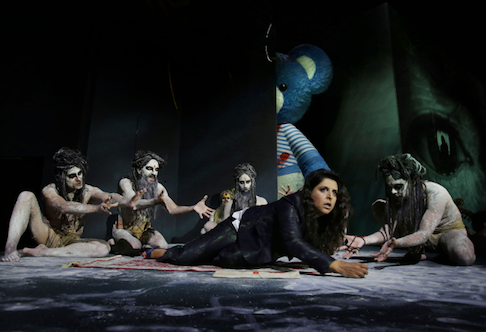 Varduhi Abrahamyan as Arsace, priests and partially hidden teddybear
Varduhi Abrahamyan as Arsace, priests and partially hidden teddybear
Just now in Pesaro stage director Graham Vick brought Rossini’s Semiramide into the twenty-first century playing heavily on contemporary sexual ambiguities, and teasing us with a huge, cartoon teddybear image to remind us that an innocent young child is mixed up in the story’s brutality. The entire four hours unfolded under or within the age-withered gaze of the man Semiramide murdered — her husband, the king Nino, the father of her son — and the reverse side of that huge image (the two stage wagons were turned around) where childish drawings were scribbled on the blank surfaces between the wagons’ structural supports.
The stage metaphor was of utmost simplicity, but reeked of theatrical complexity. We understood that Rossini’s musical language was transformed into a language of contemporary theater, and that it spoke to us not as a straightforward locale in which Rossini’s singers sing, but as the world we live in, where we feel and know but that we do not define.
Semiramide wore pants, high heels and a severe short haircut. She was a powerful woman who dominated men and their destinies. The young general Arsace wore a black pants suit with only a gold shoulder braid to indicate military rank, and with ample décolletage to boast a well endowed female breast. The sexual tension of forbidden desire rose to a nearly unbearable level as we watched and listened to these two young, powerful women negotiate their famed duet "Serbami ognor si fido il cor."
The high priest Oroe, bass Carlo Cigni, connects Graham Vick’s post modern world to a netherworld. He was some sort of high priest (guru) of a primitive culture having, supposedly, greater access to the earth’s truths. He had a number of similar undressed acolytes who made the fawning motions of clueless cult followers, mindlessness that echoed the innocence of the teddybear. Oroe’s dictums from the netherworld caused many, but hardly all of the problems.
Semiramide’s daughter Azema appeared in virginal white standing high at the side of the stage under a childish scribble of the sun. She was the contested prize (the prize includes becoming king of Assyria). She has little to sing in Semiramide’s ten arias and duets. The contenders for the throne are an Assyrian prince, Azzur, dressed like an early twentieth century Prussian prince, and an Indian king, Idreno, dressed as an exotic Indian king. Both of these men of course have a lot to sing about over then next few hours.
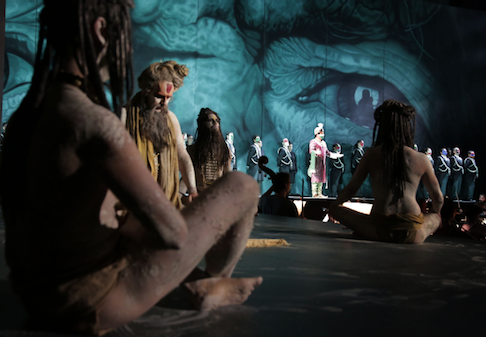 Antonino Siragusa as Idremo, priest supernumeraries in foreground
Antonino Siragusa as Idremo, priest supernumeraries in foreground
Here’s the catch: Rossini and his librettist established a basic four part model for all of Semiramide’s arias and duets, beginning with a cantabile (melodic) section followed by a chorus and recitative that changes the situation. Then there is the cabaletta (a livelier reaction to the situation), and finally a repetition of the cabaletta wherein the singer shows his stuff (added ornamentation). This is a long, drawn out process (and there were ten of them) that at best allowed us to know each of the characters and to know its singer. And at worst to tire us beyond caring.
The matricide that ends the opera packed a wallop. We did indeed know Semiramide and her son Ninia who had become the general Arsace. Even knowing Semiramide’s nefarious actions we still did care about this tragic queen, and we did feel the complexity of emotion that gripped Arsace in murdering his mother. The tragic irony that made him Assyria’s king hung heavily.
Far more than staging an evening of brilliant singing director Graham Vick created an event of monumental tragedy. It was effected by the brilliant singing and acting of Salome Jicia as Semiramide and Varduhi Abrahamyan as Arsace. Rossini’s melodramma tragico was in fact a quite successful sung tragedy.
The splendid cast included the Azzur of Argentine baritone Nahuel di Pierro and the Idreno of tenorino Antonino Siragusa as the rivals for the hand of Semiramide’s daughter Azema sung by Romanian mezzo-soprano Martiniana Antonie. Bass Carlo Cigni sang the high priest Oroe and Russian bass Sergey Artamonov sang the two brief interruptions of the ghost of the murdered king Nino. The captain of the royal guard, Mitrane, was sung by Alessandro Luciano.
Mr. Vick's associates in creating this production were his long time collaborators Stuart Nunn (sets and costumes) and Giuseppe di Iorio (lighting).
The performances took place in the Vitrifrigo Arena (Vitrifrigo is a Pesaro company that makes miniature refrigerators and freezers), formerly the Adriatic Arena. I attended the third of four performances on August 20, 2019.
Michael Milenski
image=http://www.operatoday.com/Semiramide_Pesaro1.png
product=yes
product_title=Semiramide in Pesaro
product_by=A review by Michael Milenski
product_id=Above: Varduhi Abraramyan as Arsace, Salome Jicia as Semiramide [All photos copyright Rossini Opera Festival, Pesaro]
August 23, 2019
L’equivoco stravagante in Pesaro
She loves her fiancé for his looks and her tutor for his learning. A well meaning servant spreads the rumor that she is really a castrato male posing as a female to avoid military service. Its two acts are essentially three or more easily imagined farces.
Rossini began working in opera houses at the tender age of nine, thus he absorbed an already formulated and very rich opera buffa tradition. Just now in Pesaro from the first notes of the overture conductor Carlo Rizzi discovered the unique Rossini beat and fanned hints of the famed Rossini crescendo [like, sort of, Ravel’s Bolero only infinitely faster], and unveiled the melodic inflections that presage the great Rossini. It was the same overture Rossini had used for his first farce, La cambiale di matrimonio (1810) and that he would use again for his opera seria Adelaide di Borgogna (1817).
With the exception of a fine quartet and then a truly delightful quintet in the first act, and Ernestina’s rondo in the second act the musical numbers are generic buffa. Of far greater interest is the libretto, by one Gaetano Gasbarri whose day job was as registrar of the Grand Duchy of Tuscany (the program booklet is very informative). First and foremost Sig. Gasbarri’s libretto is a spoof of exalted literary language, and second and foremost as well it is a compendium of sexual innuendo and double entendre. The censors axed the production after only three performances.
But not before the combination of musical genius and licentious scandal had brought Rossini his first fame.
For the occasion the Rossini Opera Festival added supertitles (that are not always provided), and for the very international audience even duplicated the supertitles in English, a first! Of course the words fly by at a speed that precludes getting your mind around verbal subtlety, but we did pick up enough to be greatly amused. The pleasure and reported displeasure of the audiences for those three 1811 performances in the more intimate spaces of Bologna’s Teatro del Corso can only be imagined. [This grand old theater was destroyed in 1944 by a WWII bomb — Bologna was a fascist stronghold.]
The Rossini Festival invested considerable artistic capital in the production besides conductor Rizzi, namely the French stage director team Moshe Leiser and Patrice Caurier, noted for their precise, conceptual minimalism. The single unit set was a wall making a symmetrically broken line, covered with a repeated, regal pattern upon which there was a grandiose painting of several cows (Ernestina’s father was a nouveau riche farmer). The first act was animated by tasteless, often obscene physical gestures. In the second act the set itself did some tricks that were amusing thus relieving somewhat the visual boredom and enlivening the farcical storytelling.
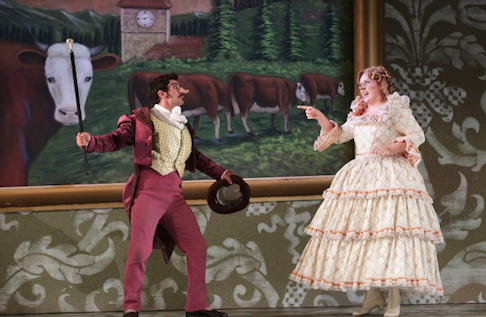 Ernestina and Buralicchio
Ernestina and Buralicchio
Of equal point were the costumes, most notably the additions of prosthetic noses added to all the faces, thus making sure that we accepted the personages as bizarre (we did indeed). To great effect was the artificially puffed out chest and thrust back butt (the rooster strut) of Ernestina's rich fiance Buralicchio well matching the three grandly laced tiers and frilly décolletage of Ernestina’s very big white dress. Enestina’s father Gamberotto was in a fat suit extolling the pleasures of his wealth, and Ermanno, her tutor was in the clearer colored, slimmer fitting clothes of the victorious suitor.
Buralicchio comes to believe that Ernestina is a male, though Ermanno has not yet heard the rumor and effects a bedroom tryst with Ernestina. We too began to see male characteristics in Ernestina, and in the duet we began to confuse the tenor voice with the mezzo (contralto) voice. The very informative program booklet tells us that the part of Ernestina was composed for a famous contralto named Maria Marcolini, of reported androgynous voice. In fact the tessitura in which Ernestina sings is often in virile territory — mezzos at that time were the descendants of castrati (and there were still plenty of real castrati around).
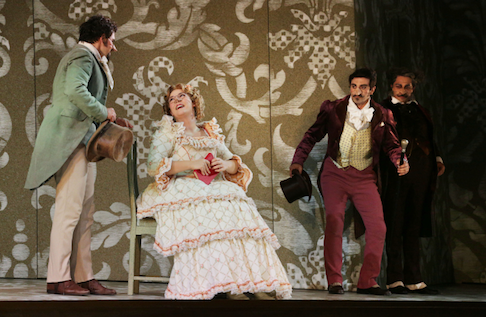 Ermanno, Ernestina, Buralicchio and Gamberotto
Ermanno, Ernestina, Buralicchio and Gamberotto
L’equivoco stravagante
was brilliantly cast. Mezzo soprano Teresa Iervolino could produce those virile tones, and as well move into the higher reaches where she managed effective mezzo-soprano fioratura. Her movements hinted at the clumsiness of a male impersonating a female. Bass baritone Paolo Bordogna was the indefatigable Gamberotto, a splendid basso buffo well known to Pesaro audiences. Though you might have expected the patter from Gamberotto, Rossini instead assigned it to the Buralicchio where it was well integrated into Davide Luciano's strutting. Russian tenor Pavel Kolgatin ably executed the florid lines of the tutor Ermanno.Not to forget the opera buffa’s two stock trouble makers, the servants Rosalia sung by Claudia Muschio and Frontino sung by Manuel Amati.
Michael Milenski
Production information:
Production information:The chorus of the Teatro Ventidio Basso (Ascoli Piceno); the Orchestra Sinfonica Nazionale Della RAI (Torino). Conductor: Carlo Rizzi; Stage Directors; Moshe Leiser and Patrice Caurier, Sets: Christian Fenouillat; Costimes: Agostino Cavalca; Lights: Christop;he Forey. Vitrifrigo Arena (formerly the Adriatic Arena), Pesaro, Italy. August 19, 2019.
image=http://www.operatoday.com/Equivoco_Pesaro1.png
product=yes
product_title=L'equivoco stravagante at the Rossini Opera Festival, Pesaro
product_by=A review by Michael Milenski
product_id=Above: Teresa Iervolino as Ernestina, Paolo Bordogna as Gamberotto [All photos copyright Rossini Opera Festival, Pesaro]
August 22, 2019
BBC Prom 44: Rattle conjures a blistering Belshazzar’s Feast
It was very much a ‘pictures in sound’ affair, an orchestral and choral jamboree variously capturing the atmosphere of tropical forest, city soundscape and Babylonian excess in three 20th century works, all given efficient direction by Sir Simon Rattle.
The evening began with Charles Koechlin’s rarely heard symphonic poem Les bandar-log, an evocative and eclectic orchestral realisation (a ‘monkey scherzo’) completed in 1940 and inspired by a French translation of Rudyard Kipling’s The Jungle Book which appeared at the turn of the century. Koechlin’s outsize orchestra is often used sparingly with numerous chamber sonorities (including one extraordinary passage for strings employing six different keys) and in his idiomatic portrayal of a troupe of monkeys the composer constructs a satire on newfangled modes and manners of contemporary music, travelling in time to mock French impressionism, serialism and neoclassicism (in the shape of a rather dull fugue). It’s an anarchic and virtuosic score brimming with invention that glows with febrile excitement and mystery, all conveyed with a wry wit from Rattle and a gleefully committed orchestra - the percussion section in their element.
Another seldom heard score followed with Edgard Varèse’s Amériques given here for the first time in its original 1921 version. Often referred to as an urban Rite of Spring, Amériques is an audaciously futuristic work (just as Charles Ives’s Central Park in the Dark was in 1906) which references both Stravinsky and Schoenberg. It’s a vast love poem to Varèse's adopted country, specifically New York where, from his apartment, he could hear “the whole wonderful river symphony which moved me more than anything ever had before”. There was no shortage of evocative shrieks and wailings from an 18-string percussion section, including two wind machines, which with other expanded instrumental groups collectively brought to life the city’s frenzied-sounding activity. But its twenty-five minutes seemed over long, the great sound masses, mechanistic power and loneliness of a distant trumpet (bringing to mind Edward Hopper’s Nighthawks) didn’t quite have the impact I’d anticipated - certainly no deafening onslaught, more a repetitious assemblage of newly-minted sonorities that ultimately outstayed their welcome despite orchestral playing of energy and precision.
This last quality was mostly realised in Walton’s Belshazzar’s Feast for which the composer devised a score of grand proportions (though not as wildly ambitious as Havergal Brian’s ‘Gothic’ Symphony from a few years earlier) including two (antiphonally placed) brass bands which had been rashly suggested by Sir Thomas Beecham prior to the work’s Leeds premiere in 1931. Next to Koechlin and Varèse’, Belshazzar’s Feast seemed almost rather ordinary, yet to pull off this extraordinary work with the necessary degree of conviction is no small ask. By and large it all worked, but even with the combined voices of the adult and youth choirs of Orfeó Català and the London Symphony Chorus their contribution felt occasionally underpowered and the brief semi-chorus passage was not quite as confidently delivered as it might have been. That said, the opening was strikingly assured, with plenty of heft from the men’s voices and the lament of the Jews had just the right degree of fervour. It was the singing of the more jubilant choral writing that never quite convinced, lacking absolute crispness that would otherwise have brought compelling rigour to the proceedings. It didn’t help that Rattle pushed a little too hard for the closing ‘Alleluias’. Yet there were some bewitching moments, not least the jazzy rhythms (finely sung) and ear-tickling percussion that accompanied the worship of the Gods and the haunting writing on the wall with an arrestingly choral “slain”.
Gerald Finley brought to the score his customary polish with his clear-toned baritone, and his ‘shopping list’ itemising the riches of Babylon was sung with emphatic relish. While the LSO provided deft and dancing support under Rattle’s vigorous baton, the performance never quite gripped as much as the music itself.
David Truslove
Gerald Finley (baritone), Sir Simon Rattle (conductor), Orfeó Català, Orfeó Català Youth Choir, London Symphony Chorus, London Symphony Orchestra
Royal Albert Hall, London; 20th August 2019.
image=http://www.operatoday.com/Gerald%20Finley.jpg image_description= product=yes product_title=Prom 44: Sir Simon Rattle conducts Orfeó Català, Orfeó Català Youth Choir and the London Symphony Orchestra and Chorus product_by=A review by David Truslove product_id=Above: Gerald FinleyPhoto credit: BBC/Chris Christodoulou
Prom 45: Mississippi Goddam - A Homage to Nina Simone
The very title of this Prom, ‘Mississippi Goddam’, taken from Simone’s 1964 album, Nina Simone in Concert, comes from her first civil rights song and was written in response to the 1963 murder of Medgar Evers, and the September 1963 bombing of a Baptist church in Birmingham, Alabama. The song was controversial at the time - especially below the Mason-Dixon Line, where ‘Goddam’ was expunged and boxes of records sent to record stations were returned broken in half; but, despite its almost show-tune feel it remains extraordinarily powerful half a century later. The protest songs are one part of Simone’s output, but what this magnificent Prom also amply demonstrated is that Simone’s legacy and outreach is one of astonishing breadth.
In many ways, Simone was considerably more radical - and more complex - than other American artists of the time such as Ella Fitzgerald or Dina Washington. She was just very different to them; and the voice was too. If you were looking for a parallel today, the singer who most resembles her is Diamanda Galas: Both invoke the power of their feminist credentials, both cross into multiple musical genres, and both are unafraid to confront unfashionable and overtly political causes. Simone’s music can clash with her personal life, just as Galas’s does - when Simone writes and sings in ‘Be My Husband’ the slavery she is referring to is the abuse of marriage, but while it might be framed as a very personal story it has a universal truth to countless other American women trapped in abusive marriages. Galas’s Plague Mass isn’t just about her brother’s fight against AIDS - it’s an angry, terrifying onslaught against all personal AIDS battles.
Nina Simone’s voice was a lot of things, often within the same song. It could be extraordinarily warm, almost thickened like treacle, but also have an adenoidal range to it. It was unusually intense, even in her studio recordings for Philips or RCA, though some of her live performances on disc have a magnetism that is quite unique: ‘Dambala’, which appeared in 1974, and which was heard in this Prom, is staggering for its intensity and radiance. Improvisation mattered a great deal; but what is also there is what you can’t really teach. At her greatest, there is a depth and spirituality to the voice, a poetry and soulfulness which touches the visceral. In part this must certainly have much to do with Simone the inner woman: Fiery, volatile and prone to bouts of rage. Only later was she to be diagnosed with bipolar disorder.
It’s perhaps not surprising, given all this, that it took two singers to do justice to the songs in this concert. Ledisi and Lisa Fischer have strikingly different voices, in both colour and range. What they share is an ability to dig deep - if some of this concert was clearly a display of vocal virtuosity of the highest order, other parts of it were about exploring the plight of black women in America, their place in wider Eurocentric cultures or about how beauty and identity relate to women of colour. Fischer generally sang these more emotionally demanding songs; the smoky, dark soulfulness of her voice mostly caught the complex place of womanhood in a divisive cultural world. Fischer’s performance of ‘Dambala’ was simply profound, taken at such a slow tempo the power of it became unbearable. I’m not sure any song during the evening was more emotionally draining or invoked the sheer horror of slavery more successfully. The deliberate tempo, not to say the way in which Fischer drew us in, made us complicit in the hopelessness of ever unshackling those in slavery.
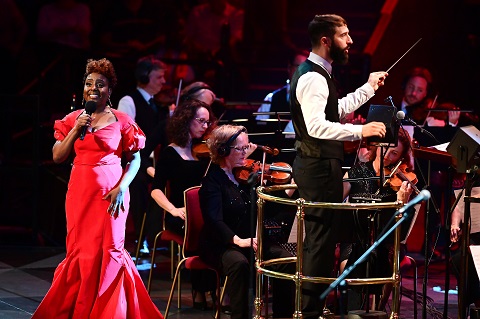 Ledisi and Jules Buckley. Photo credit: BBC/Mark Allan.
Ledisi and Jules Buckley. Photo credit: BBC/Mark Allan.
This was a marked contrast to Ledisi’s performance of ‘I Put a Spell on You’ which had been almost cannibalistic - somewhat different to how Simone takes the song on her classic Philips recordings from 1964-5. Simone’s willingness to draw back from this song’s rawest elements, even to be restrained in it until winding up towards the end in typical belt-it-out fashion, isn’t a vision that Ledisi shares. From the very start, this was a performance that never shrunk from being a tour de force: If spells are remotely menacing this one wasn’t that, but it was simply naked with passion, inflamed with intensity and staggering in its vocal control. Predictably, it brought the house down.
From the same album on which ‘I Put a Spell on You’ appeared, Ledisi also sang ‘Ne me quitte pas’, one of the many songs which Simone wrote in French after she moved to Europe. Diction issues aside, this gave Ledisi an opportunity to bring some depth to her singing - which she did admirably. ‘My Baby Just cares for Me’ (from her very first album in 1958) was probably better sung by Fischer than by Simone herself. This is to all intents and purposes a love song, but Simone’s general unwillingness to embrace this genre (for a time she even forgot she had recorded this song) demonstrates a side of Simone’s character that could so easily interfere with her ability to communicate to audiences. Simone’s tendency to deflect her passions onto others, into feminism, enfranchisement and protest, masked an often loveless and abusive personal life, one in which she neither received nor gave much emotional feeling to others. If there’s a detached, almost matter-of-fact tenor to Simone’s version of this song Fischer sees it otherwise. ‘Plain Gold Ring’ (also from 1958) is almost callous when set beside this love song - a ballad of unrequited love, unfaithfulness and exploitation. Fischer, her credentials so woven into the mysteries of emotions and love, found herself equally at home in the complex triangulation of a love that would never be.
Fischer had also been the vocalist in two pieces which came from two very different operas - one of which Simone did sing and record, the other which she did not. Her musical range was, of course, eclectic - indeed, in her formative years she had intended to study at the Curtis Institute in Philadelphia but was turned down, something which she spent the rest of the life insisting had been racially motivated. ‘I Loves You, Porgy’ from Act II of Gershwin’s opera (which she recorded in 1958) always showed Simone at her best: Tender, the voice at its most evocative and controlled. Fischer certainly had the range for it, if not quite the tenderness, but there was a feverishness to her singing which was entirely descriptive of the narrative. Much less successful - in fact a miss for me - was ‘Dido’s Lament’. Fischer’s somewhat quirky, rather gospel-inflected version of this was literally sectionalised into ups-and downs; at times it just sounded unsettling. The voice is unquestionably dark enough, it’s warm and tonally rich - I just couldn’t warm to this interpretation.
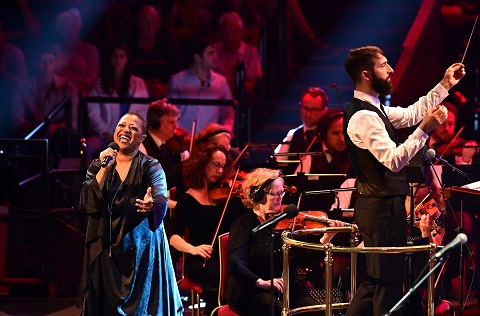 Lisa Fischer and Jules Buckley. Photo credit: BBC/Mark Allan.
Lisa Fischer and Jules Buckley. Photo credit: BBC/Mark Allan.
‘Mississippi Goddam’, sang so impeccably by Ledisi, was superb. Despite the protest elements of this song, its radical overtones, it is musically quite the opposite. Its jauntiness, elastic rhythms and incendiary beat cover a deeply invective narrative. Ledisi launched into it with an intensity that gripped one from the very beginning, but every word of this profoundly powerful song was sung from the heart. ‘Four Women’, from 1966, was sung by Ledisi, Fischer and two members of the backing group, LaSharVu. Although this song is about enslavement it is about something else: It is about identity, and especially how black women are stereotyped. Unquestionably, the version of the song here probably worked better than Simone’s own because the sense of identity shared by different women was better advocated for, by voices which were very different in colour themselves. There was a deep spiritualism to this song in this performance - but also a contrast to the African-American, or mixed-race stereotypes which so inspired Simone to write it in the first place.
It has to be said that Big Jazz playing is just one of the most exhilarating sounds imaginable. Many of the versions for these covers were written for these performers, and the sound was beyond lush. The Metropole Orkest was bewildering good. Individual solos, whether on the piano, saxophone, trombone or amplified guitar were electrifying - but the corporate sound of the orchestra was thrilling, beautifully conducted by Jules Buckley.
Of course, concerts never just end, and this one didn’t either. A roof-raising, unforgettable encore of ‘Feeling Good’ followed. Subtle it was not, less slow-burning than Nina Simone ever brought to it, but sung here to showcase two voices at the peak of their considerable powers and ranges. It brought a capacity house to their feet.
This concert is on BBC iPlayer for 30 days, will be broadcast on BBC Radio 2 on Friday 13th September and shown on BBC Four on 30 th August.
Marc Bridle
Ledisi - vocalist, Lisa Fischer - vocalist, LaSharVu - backing vocalists, Jules Buckley - conductor, Metropole Orkest.
Royal Albert Hall, London; Wednesday 21st August 2019.
image=http://www.operatoday.com/LaSharVu.png image_description= product=yes product_title=Prom 45: Mississippi Goddam - A Homage to Nina Simone product_by=A review by Marc Bridle product_id=Above: LaSharVu, Ledisi and Lisa FischerPhoto credit: BBC/Mark Allan
August 21, 2019
Sincerity, sentimentality and sorrow from Ian Bostridge and Julius Drake at Snape Maltings
A virtuoso linguist, a fecund neologist, facilely and exuberantly toying with form and metre, Rückert was and is seen by some as an affected and artificial versifier: a stylist rather than a poet. Not so the composers whom his work inspired: among them, Schubert, Robert and Clara Schumann, Brahms, Mahler, Richard Strauss, Zemlinsky, Bartók, Berg, Wolf, Hindemith and Henze.
One might feel, in fact, that the six Rückert settings by Schubert with which the recital commenced were chosen for their simplicity and directness, not for their affectation, though they were certainly not lacking in sensibility. ‘Die Wallfahrt’ (The pilgrimage) emerged only in 1968, when a copy of the song was discovered by Reinhard Van Hoorickx in the Cornaro family library. Barely 16 bars long, just over a minute in length, this song’s piano accompaniment supports the voice with broadly spaced spread chords, and the sombre vocal line falls dark and deep: it is hardly the sort of song with which one might expect a tenor to open a recital. Indeed, it was originally written for bass voice; but its combination of spirituality and humanity (the text was published in Rückert’s Östliche Rosen in the early 1820s) set the tone for the whole recital.
The opening piano chords of ‘Greisengesang’ (Old man’s song) were imposing, and the sparseness of the voice-piano unisons and homophony were chilling; but the old man’s memories of youth and love lingered and lived, as Bostridge’s tender, time-transporting head voice revealed. The winter has whitened his hair, but the flush of youthful passion glows in his cheeks. Did the poet-speaker’s voice, softening, shadowed, sink at the close into a deep forest of dreams or into the underworld? Were the piano’s three rich cadential chords a warm bed of rest or tolling bells? We could not know.
‘Lachen und Weinen’ (Laughter and tears) promised liveliness and joy, but paradoxically epitomised their very brevity. Pauses and silences before doubtful and questioning vocal utterances seemed to render the piano’s light-hearted ornaments dishonest. ‘Du bist die Ruh’ (You are repose) initially intimated the vocal transfiguration that Bostridge can so beguilingly and tenderly offer, but the intensity of the final stanza seemed riven with pain as much as with passion. Similarly, ‘Daß sie hier gewesen!’ (That she was here!) was quizzical rather than certain: shored up with belief and hope, torn down by doubt and fear, each word of the vocal line interrupted by a brief silence. In the final stanza, the duo pulled the rhythm this way and that to trouble us further, and the final repetition of the title line was desperate and fraught, rather than confirmatory.
Finally, ‘Sei mir gegrüßt’ (I greet you): slow, reflective, introspective. Bostridge seemed lost in reverie, head bowed, leaning on the piano. The visions of passion - ‘Sei mir gegrüßt, Sei mir geküßt’ - were not realised by repetition but pushed ever further into the hinterland of dreams. I’m not entirely certain, but I think that Bostridge mis-ordered the text of the final two stanzas, so that we concluded not with the poet’s imagined embrace - ‘I close you in my arms’ - but with the urgency of ‘my soul’s most ardent outpouring’. If so, then the sudden surge of erotic fulfilment was, ironically, welcome.
Bostridge’s interpretations of Mahler’s Des Knaben Wunderhorn are familiar from his recent recording and performances with Antonio Pappano . The grotesque, the ironic, the distorted, the empty: such abstracts were just as present here, but I felt that Drake’s encompassment of a spectrum of ‘orchestral’ colours, as well as his ability to play the same small motif with infinite variety of nuance and emphasis, made, paradoxically, the bitterness both more bracing and more bearable, the human breath more tangible, than on the occasion I heard Bostridge sing these songs in the Barbican Hall.
In ‘Revelge’ (Reveille) the piano growled but was never ponderous, despite the ferocity of some of the left hand’s leaping, martial fourths. The shocking image, ‘My comrades strewn so thick, Lie like mown grass on the ground’, unleased God’s thunder from the keyboard. Bostridge twisted through the torturous ‘tralalees’, brazenly facing the audience, daring us to flinch. He flagellated us with the image of the marchers passing the drummer’s sweetheart’s house, pounding us with her vision of his bones at the head of a human tombstone, ‘Daß sie ihn sehen kann’ (That she may see him there).
Bostridge’s energy then seemed spent, burnt up by anger. ‘Wo die schönene Trompeten blasen’ (Where the beautiful trumpets blow’) was searching, at times gently penetrative - as when the nightingale mourns the lovers’ future loss. But there was a sharp bite in the piano’s martial motifs and Bostridge’s piercing stare at the close - when the departing soldier speaks with love of the ‘home of green turf’ to which he will return’ - again dared us to look away. By this point, Drake’s grotesque trills in ‘Der Tamboursg’sell’ (The drummer boy) were almost too much to bear, and the anger spilled over into the pained vocal cries as the drummer walked towards the gallows: ‘Weil I weiß, daß I g’hör dran’ (For I know what you mean to me). As the marching motifs pushed the boy towards his death, so Drake’s languorous trills tugged him back: the tension was painful. At the close there was only death: ‘Gute Nacht’. In the silence and stillness of the Maltings, it seemed no one dared to breath … until Julius Drake stood, necessarily drawing us, and Bostridge, back to the land of the living.
A connection to the Schubert of the start of the recital was established when we heard four of Mahler’s Rückert settings. The carefree circular meanderings of Mahler’s wayfarer in ‘Ich atmet’ einen linden Duft’ (I breath a gentle fragrance!) bring him to the Lindenbaum - Bostridge’s voice seemed both to cleanse the air and bear aloft the scent of bracing lime - but this is a very different point of arrival to the turning-point which Schubert’s wanderer must confront in Winterreise. The re-ordering of Mahler’s cycle must have been intended to create a new narrative, but while I could not quite discern this, it did not matter: each song thrived on its own terms. ‘Blicke mir nicht in die Lieder!’ (Do not look into my song!) was urgent: a representation of creativity both fervent and feverish. With ‘Liebst du um Schönheit’ (If you love for beauty) we were restored to the paradoxically consoling restless sehnsucht of a Schubert lied. This is the painful beauty that Bostridge can evoke, for me, like no other singer. At the close he seemed overcome: ‘Liebe mich immer, dich lieb’ ich immerdar.’ (Love me forever, I’ll love you evermore.) He turned away from us, carried elsewhere, inwards.
‘Ich bin der Welt abhanden gekommen’. I am lost to the world. This is the first line of Mahler’s third Rückert song, which followed, unbearably poignant. Quite simply the vocal beauty, the enchantment of the melismas, the magic of Drake’s postlude carried me - and, I’m sure, many in the Maltings - far away too.
Between these two Romantic ‘pillars’ lay the ‘modern Romanticism’ of Hans Werner Henze. Bostridge and Drake first met Henze at Snape Maltings in 1996, when they were performing three of Henze’s settings of W.H. Auden in celebration of the composer’s 70th birthday. Bostridge described their first encounter in an article in The Guardian ten years later, explaining that following their performance Henze offered to write a new song cycle for him: the result was the 45-minute Sechs Gesänge aus dem Arabischen which the duo premiered at Wigmore Hall in 1999. The songs set Henze’s own texts, excepting the final invocation to the moon by the 14th-century Persian poet, Hafiz, as translated by Rückert.
These songs may be challenging for the listener unfamiliar with their sophisticated poetic, philosophical and musical arguments, and with Henze’s attention-demanding idiom, but they offer an immersive, entrancing depth and range of colour, emotion and dramatic mood. Bostridge and Drake gave us just two of the songs. The fourth, ‘Cäsarion’ (Caesarion), tells of the sailor Selim, whose sea journey has been a struggle of epic, Shakespearian dimensions as love and war, man and nature tussle for power and survival. Drake and Bostridge graphically, and grippingly, depicted the storm without and within, the vocal and pianistic rhetoric by turns grand and turbulent, tormented and resigned, as Selim, lured by the witches’ song and tossed by the waves, lands naked, stretched out on the shore, ‘a ladies’ man, laid low by the sea voyage’.
Delivering the virtuosic storm-painting with enviably calm control, Drake relished the piano’s startling contrasts, and technical and expressive demands. And, to counter the theatrical oratory - including yelps and growls - which Bostridge delivered with his back curved, shoulders hunched, his chin pressing onto his chest, there was tenderness. An unaccompanied vocal passage looked beyond the earth, star-ward, as the sailor-narrator’s thoughts followed the ‘lines inscribed by God in his network of veins’. Bostridge submerged himself in the mystical, recounted the narrative and lived the theatrical. At times the vocal line seemed improvisatory, elsewhere more declamatory; but always fervent, often incantatory. During the long piano postlude, the tenor stared into the depths of the piano’s body, as the powerful resonances of the final, towering, pressing chords faded into infinity, the overtones and harmonics slowly dissolving until the essential fifth and then single tone were all that remained as haunting impressions on the surface of the silence.
The final song, ‘Das Paradies’, offered peace, of a kind, with its repetitions and regularities and gentler idiom. But, the insistent refrain, ‘reich mir die Hand’ (give me your hand), possesses its own conflicts - ‘Komm,dass ich dich fasse, reich mir deine Hand’: my and your, desperation and deliverance - just as the unornate vocal line is hectored by the piano’s rhapsodising. Bostridge managed to conjure a serenity that was paradoxically riven with sadness: not so much a Wagnerian anti-resolution, as a Mahlerian denial of despair through a redemption by love.
And so, there was a purposefulness at the close, a reaching for the sublime - both within grasp and unattainable - as Bostridge issued a quasi-falsetto plea to the moon: ‘I clamber up to your castle, fair moon,/let me pale before you. Come, come, give me your hand.’ In the aforementioned Guardian article, Bostridge describes this final song as ‘a sort of letting-go … the song itself has an extraordinary air of transcendence’. As I drove home from Snape Maltings, through the unlit roads of Suffolk, the waning moon hung low - a sagging, watery pendant in the black sky, a shimmering pink blush. Otherworldly and divine.
Claire Seymour
Ian Bostridge (tenor), Julius Drake (piano)
Schubert - song settings of poetry by Rückert; Henze - ‘Cäsarion’ and ‘Das Paradies’ from Sechs Gesänge aus dem Arabischen; Mahler - songs from Des Knaben Wunderhorn and Rückert Lieder
Snape Proms, Snape Maltings, Suffolk; Tuesday 20th August 2019.
image=http://www.operatoday.com/Ian%20Bostridge%20%C2%A9%20Sim%20Canetty-Clarke%203.jpg image_description= product=yes product_title=Snape Proms: Ian Bostridge and Julius Drake product_by=A review by Claire Seymour product_id=Above: Ian BostridgePhoto credit: Sim Canetty-Clarke
Glimmerglass’ Showboat Sails to Glory
There have been many iterations of this musical over the years, but the version currently on stage at the Alice Busch Theatre is easily the most effective I have encountered. Thanks to director Francesca Zambello’s sure hand and past experience with the piece, the staging is exceptionally sure-footed and cogent.
Showboat is really the only revivable Broadway show of the 1920’s, an era more known for dated froth and lavish revues. The reason for Showboat’s enduring appeal is partly owing to Kern’s evergreen score, partly to Hammerstein’s expert adaptation of Edna Ferber’s novel of the same name, and partly to the stirring, daring exploration of themes of race relations and miscegenation. It was a daring move to present an integrated cast on a Broadway stage in 1927. In the festival at hand, Showboat also contrasted memorably with Blue, another opera on the schedule that dealt powerfully with the issue of race in America. It is sobering to note how some things have not changed much since Showboat’s premiere.
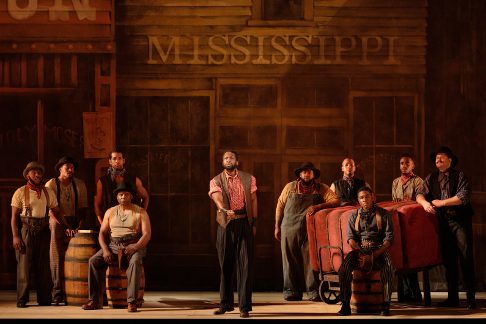 Justin Hopkins as Joe with members of the ensemble [Photo by Karli Cadel/The Glimmerglass Festival]
Justin Hopkins as Joe with members of the ensemble [Photo by Karli Cadel/The Glimmerglass Festival]
Peter J. Davison’s modular set design was all one could wish, and his ingenious use of flying drops, rolling wagons, and the enormous titular boat was colorfully effective. Of the many scenic effects, Mr. Davison’s red-trimmed, white, two-tiered Cotton Blossom, complete with paddle wheel, was especially impressive. It could come apart to be slightly re-configured to several different looks, and it proved sturdy enough to accommodate a large number of cast members who scampered all over it to great effect.
The action takes place over a 40-year period and much of the success of conveying that passage of time is owing to the remarkably varied costume design by Paul Tazewell. Between the dozens and dozens of costumes, and the voluminous set pieces, and the large cast of performers, I am not sure where it all lives offstage. The stage manager(s) could surely qualify to be an air traffic controller at JFK. The flawless flow of the ever-changing changing scenery was a highly commendable achievement.
Mark McCullough’s splashy lighting design was another fine component, including miniature lights that were cleverly built into some of the showier set pieces. Samantha M. Wootten contributed another exhaustively varied, perfectly realized hair and make-up design. Choreographer Eric Sean Fogel crafted a series of enjoyable production numbers, that were well-executed by the large group of actors, including Katherine Kozak’s admirable chorus, who performed exquisitely through the festival. It is to the great credit of Ms. Zambello and Mr. Fogel that the story was always well focused, that the movement was well paced, and that, no matter how full the stage was, it never once looked crowded.
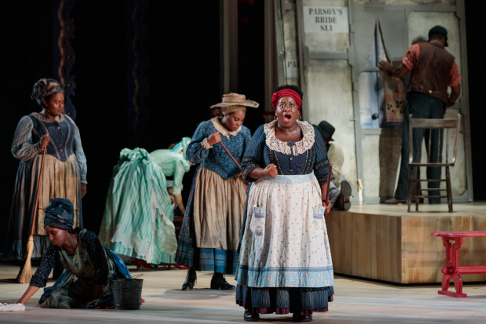 Judith Skinner as Queenie and members of the ensemble [Photo by Connor Lange/The Glimmerglass Festival]
Judith Skinner as Queenie and members of the ensemble [Photo by Connor Lange/The Glimmerglass Festival]
Jim Lowe presided in the pit and he brought out every lick of color and pizzazz that is present in this classic orchestration. The lyric beauty of this varied score, which contains some of the greatest pieces in the American songbook, was lovingly rendered with well-considered pacing and balance. It is always a pleasure to hear unamplified voices in this repertoire and the soloists did not disappoint.
Lauren Snouffer proved to be an ideal Magnolia, diminutive and appealing, and with a shining voice kissed by the angels. Her freely produced soprano has an immediacy and polish that were very endearing and she ably communicated the progression from naïve teenaged girl to an older but wiser woman. Her total stylistic command of this music was always abundantly evident.
Pairing her as Gaylord, Michael Adams not only cut a dashing figure but also deployed a creamy, gleaming baritone that gave significant pleasure. Mr. Adams made it entirely believable that a rather ne’er-do-well character could charm and seduce. His reconciliation with his adult daughter was very touchingly managed.
Broadway hoofer Lara Teeter was effortlessly endearing as Captain Andy, his loose-limbed strutting and prancing suggesting an over-caffeinated Dick Van Dyke. Whenever his character had focus, Mr. Teeter commanded the stage. As his wife Parthy, Klea Blackhurst was a harridan with a heart of gold, and admirably managed to find more variety in the part than the script contains.
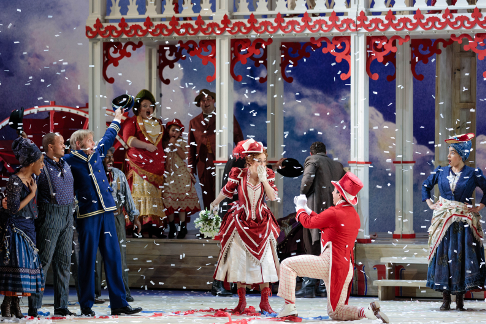 Abigail Paschke as Ellie Mae Chipley, Schyler Vargas as Frank Schultz and members of the ensemble [Photo by Karli Cadel/The Glimmerglass Festival]
Abigail Paschke as Ellie Mae Chipley, Schyler Vargas as Frank Schultz and members of the ensemble [Photo by Karli Cadel/The Glimmerglass Festival]
The stylish actress Alyson Cambridge made for a memorable Julie. It is hard to believe how little stage time the character actually has, when someone like Ms. Cambridge illuminates every moment with such heart and soul. Her rendition of Bill contained just the right mix of nostalgia and despair. Justin Hopkins is a powerful Joe, nearly stealing the show with his soulful reading of Old Man River. Mr. Hopkins’ refined bass rolls along just like the river, with a steady current of orotund, burnished phrases. Judith Skinner has just the right amount of brassiness, sassiness and sense of fun as Queenie, whose powerful contralto delivered several star turns that numbered among the show’s highlights.
Having heard Abigail Paschke’s silvery soprano excel with Depuis le jour in the Apprentice Artists auditions a few days prior, I was not prepared for the complete turnabout in her assured assumption of Ellie May. Ms. Paschke’s well-controlled belting and sure-footed dancing provided excellent comic relief from the show’s somber themes. Grant Wenaus matched her note for note and step for step in the role of her song and dance partner Frank. Charles Eaton had several shining moments as Julie’s husband Frank.
In this sterling production of Showboat, every opportunity was seized to make it the memorable success it is. Bravi tutti!
James Sohre
Showboat
Music by Jerome Kern
Book and Lyrics by Oscar Hammerstein II
Based on the novel by Edna Ferber
Magnolia Hawks: Lauren Snouffer; Gaylord Ravenal: Michael Adams; Cap’n Andy: Lara Teeter; Parthy Ann Hawks: Klea Blackhurst; Queenie: Judith Skinner; Joe: Justin Hopkins; Julie LaVerne: Alyson Cambridge; Frank Schultz: Schyler Vargas; Ellie May Chipley: Abigail Paschke; Jake: Grant Wenaus; Young Kim: Bella Crowe; Conductor: James Lowe; Director: Francesca Zambello; Co-Director: E. Loren Meeker; Choreographer: Eric Sean Fogel; Music Supervisor: John DeMain; Set Design: Peter J. Davison; Costume Design: Paul Tazewell; Associate Costume Designer: Loren Shaw; Lighting Design: Mark McCullough; Hair and Make-up Design: Samantha M. Wootten; Chorus Master: Katherine Kozak; Children’s Chorus Master: Aurelia Andrews.
image=http://www.operatoday.com/KarliCadel-GGF19-ShowBoat-GenDress-1410.png image_description=(From left) Lauren Snouffer as Magnolia Hawks, Alyson Cambridge as Julie La Verne and Klea Blackhurst as Parthy Ann Hawks [Photo by Connor Lange/The Glimmerglass Festival] product=yes product_title=Glimmerglass’ Showboat Sails to Glory product_by=A review by James Sohre product_id=Above: (From left) Lauren Snouffer as Magnolia Hawks, Alyson Cambridge as Julie La Verne and Klea Blackhurst as Parthy Ann Hawks [Photo by Connor Lange/The Glimmerglass Festival]August 20, 2019
Proms at ... Cadogan Hall 5: Louise Alder and Gary Matthewman
Alder’s programme had me reflecting on the challenges of devising a sequence of song for a fairly short mid-day recital. Does one take a theme and offer the audience contrasting responses from a variety of composers? Is homogeneity of idiom and period preferable to diversity? At first glance, this programme looked fairly conventional: a chronological progression from Schubert, through the Mendelssohn siblings, and on to Liszt and Chopin - complemented by a geographical movement from central Europe, then further eastwards, though with a nod towards Paris.
But closer inspection revealed a slight idiosyncrasy in the programme, for two of the three Schubert songs and the five songs by Liszt were to be performed in ‘versions’ less well known to audiences. And to Alder herself: during a brief word after the recital, the soprano commented that there had been a lot of ‘new’ music to learn, and that it was a challenge to sing the ‘variants’ of songs whose more familiar incarnation was so present in one’s musical memory.
Not that there was any sign of this ‘challenge’ during a performance that was characterised by relaxed affability, even playfulness at times, and confident, easeful musicianship. Alder is a natural ‘actor’, and she brought the varied contexts and protagonists of the lieder immediately to life, aided by Matthewman’s discrete but superlatively attentive accompaniments. The clarity of Matthewman’s voicing, the gentleness and precision of the quietest episodes, the fine definition of motive and pattern, the lively coloristic touches: all such made for an impressively sensitive complement to Alder’s vocal line.
Matthewman’s mastery of both tiny motif and broader canvas, and the relationship between the two, was exemplified in the opening song, ‘Gretchen am Spinnrade’, in which the piano’s murmuring wheel gained almost imperceptible momentum as the abandoned Gretchen’s yearning grew and the visions of her lover intensified, resuming its spinning with wonderful hesitancy then determination after the climactic memory of his kiss, a peak that Alder’s passion pushed a little off kilter - a rare, small lapse, but entirely forgivable at such an early stage in the recital as she settled into her stride. The second version of ‘Nacht und Träume’ (published in 1823 as Op.43 No.2) followed. Matthewman’s soft pedalling conjured a sleepy mood, the piano sinking low, and Alder’s soprano acquired a floaty dreaminess as she longed for the spirit of the night to return. My first impression was that the tempo was rather slow, weakening the ‘pull’ of some of the harmonic progressions. But a subsequent glance at the two versions revealed that in 1823 Schubert did indeed add ‘sehr’ to the ‘langsam’ instruction of the first version! The performers had been true to his intended languid reflectiveness after all.
Alder closed the Schubert sequence with ‘Die Forelle’, in its fifth version (1821). She performed this song during the Song Prize Final of the BBC Cardiff Singer of the World, and the beguiling vivacity and drama that she brought to her Cadogan Hall performance made it clear why she won the Dame Joan Sutherland Audience Prize in 2017 and prompted Gerald Finley to remark “she is born for that stage”!
Three songs by Felix Mendelssohn preceded three by his sister Fanny, and here Alder’s soprano seemed freer, more fluid in the upper register and more focused in the middle. Matthewman’s rippling arpeggios sparkled in ‘Auf Flügeln des Gesanges’, while after the delicacy of the roses’ delicate scented whispers, Alder allowed the blissful dreams to bloom at the close. The rocking syncopations of the brief ‘Der Mond’ throbbed with a passion which burst vibrantly forth in the second stanza, with the poet’s plea to the shining moon for a single glance brimming with heavenly peace, while ‘Neue Liebe’ found Mendelssohn in ‘fairy mode’ and the duo tripping precisely, fleetly and with a feverish frisson through the racing night journey.
Fanny Hensel’s ‘Bergeslust’ seems to offer a joyful vision of nature, with the woods and mountains stretching up to the heaven, but Alder and Matthewman used the brief modulation to the minor mode to subtly intimate graver thoughts. Lovely rubatos imbued ‘Warum sind denn die Rosen so blass?’ with a tender wistfulness; in contrast, ‘Nach Süden’ was as exuberant and purposeful as the birds flying southwards, ‘into the eternal blossoming’, that the poet-speaker eulogises.
It was the five songs by Liszt, though, that were both most substantial and most impressive. The major-minor dialectic of the piano’s introduction pulsed through ‘Freudvoll und Leidvoll’, which trembled with anguish and surged with love. Alder was fully in tune with the poetic sentiments which she and Matthewman communicated with genuineness and creative inflection. ‘S’il est un charmant gazon’ was delightfully fresh, joyous and spontaneous; ‘Oh! Quand je dors’ billowed wonderfully, with Alder drawing every nuance from the text - the lover’s passing breath and the transformation of woman into angel made tangible by the coaxing vocal delivery. Best of all was ‘O lieb, so lang du lieben kannst’, in which natural simplicity gave way to more artful expression, as Alder’s beautiful soprano soared through the ever more impassioned arcs. Matthewman’s harmonies roved, breaking beyond the ordered confines of the opening of the song and pushing the voice towards impassioned declamation which overflowed with feeling, until, with wonderful control, soprano and pianist drew the emotions which had so richly flamed back within their hearts.
After such heights of Romantic sensibility, a relaxation into a more folky spirit was welcome, and Chopin’s lilting ‘Życzenie’ (The Maiden’s Wish) swept us into a more carefree world. Alder may have required the score for these Polish songs, but - while I’m not in a position to judge the authenticity of her Polish - she didn’t seem to glance down at it very often! ‘Śliczny chłopiec’ (Handsome lad) was similarly winsome and full of playfulness, preparing us for the smouldering and teasing of Rossini’s ‘Canzonetta spagnuola’ which accelerated with gleeful confidence and devil-may-care abandon, as Alder raced through the vocal ripples.
As they accepted the spirited applause of the capacity Cadogan Hall audience, Alder thanked Matthewman with a warm hug. The performers obviously enjoyed themselves as much as we did.
This recital is available on BBC Radio 3 iPlayer for 28 days.
Claire Seymour
Proms at … Cadogan Hall 5: Louise Alder (soprano), Gary Matthewman (piano)
Schubert - ‘Gretchen am Spinnrade’, ‘Nacht und Träume’, ‘Die Forelle’; Mendelssohn - ‘Auf Flügeln des Gesanges’, ‘Der Mond’, ‘Neue Liebe’; Fanny Hensel - ‘Bergeslust’, ‘Warum sind denn die Rosen so blass’, ‘Nach Süden’; Liszt - ‘Freudvoll und leidvoll’, ‘O lieb, so lang du lieben kannst’, ‘S'il est un charmant gazon’, ‘Ah! quand je dors’, ‘Comment, disaient-ils’; Chopin - ‘Życzenie’, ‘Śliczny chłopiec’; Rossini - ‘Canzonetta spagnuola’.
Cadogan Hall, London; Monday 19th August 2019.
image=http://www.operatoday.com/Louise-Alder-Credit-Gerard-Collett-NEW-684x1024.jpg image_description= product=yes product_title=Proms at … Cadogan Hall 5 product_by=A review by Claire Seymour product_id=Above: Louise AlderPhoto credit: Gerard Collett
Glowing Verdi at Glimmerglass
This is owing in no small measure to the inspired baton of Joseph Colaneri, who reinvented this timeless classic with fresh ears. Maestro Colaneri has cleansed the performance of some time honored performance indulgences, and if some standard rubati and fermati were missing, the result was liberating. The sprightly passages of Verdi’s masterpiece fairly crackled, while the poignant stretches were heightened by contrasting, intense introspection. The instrumentalists responded with a cleanly detailed, stylistically apt reading that was arguably their best work in the pit, in a season marked by fine playing. The cast was assuredly up to the demands of Verdi’s middle period masterpiece.
Violetta Valery is one of the pinnacles of operatic soprano roles and Amanda Woodbury met its challenges head on. Ms. Woodbury has a pliable, sizable lyric instrument that is completely able to meet the well-known challenges of this complex and lengthy role. She has the goods to dispatch Act I’s flighty coloratura with consummate ease; she has good command of the mid-range conversational passages of Act II and hurls out the spinto outpourings of Amami Alfredo with thrilling commitment; and she is in total control of the weighted pathos and limpid lyricism of Acts II and IV.
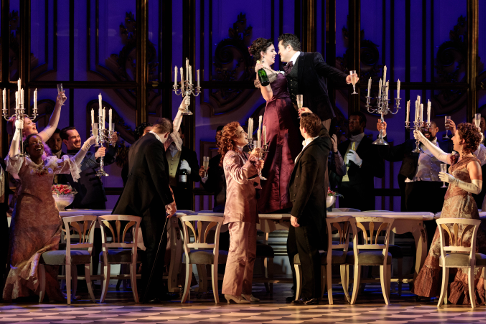 (Center) Amanda Woodbury as Violetta, Kang Wang as Alfredo and members of the ensemble
(Center) Amanda Woodbury as Violetta, Kang Wang as Alfredo and members of the ensemble
I have written before that Violetta, like Carmen, is a complex persona, sometimes enigmatic, often unpredictable, and endlessly malleable to the interpreter’s individual gifts. Amanda has at her command a surefire technique, a captivating vocal quality, and a heart-rending way with the many plangent sacrificial phrases. She is a wonderfully engaged actress who communicates the text with deep understanding, and vocalizes the part with a technique that is even and secure from top to bottom. The diva is also possessed of a lovely stage presence, making her Violetta assured and affecting.
As Alfredo, tenor Kang Wang reveled in the role, lavishing it with an assured lyric tenor of ample power and even production. Mr. Wang was able to encompass all of the sways of emotion the lad experiences, from unrestrained puppy love to discarded inamorato to penitent mourner. His confident singing wholly embraced Verdian styling, even though his instrument may lack just that final measure of Italianate squillo.
Adrian Timpau scored a huge success as Giorgio Germont, his large, incisive baritone filling the Alice Busch theatre to the rafters. Mr. Timpau nails both the ferocity and the compassion of the paterfamilias, and he invests his phrases with utmost meaning and clarity. His musical and theatrical journey with Ms. Woodbury in the great Act II duet was remarkably nuanced and gorgeously sung.
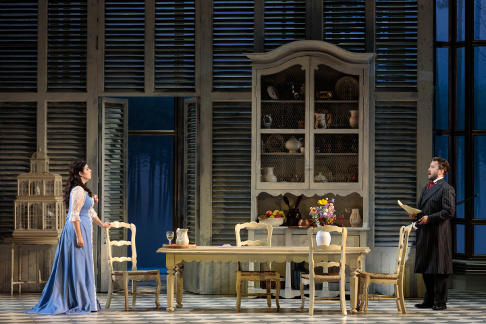 Amanda Woodbury as Violetta and Adrian Timpau as Germont
Amanda Woodbury as Violetta and Adrian Timpau as Germont
The minor roles were cast from strength with Apprentice Artists. Kameron Lopreore lent his sweetly solid tenor to Gastone, and Jonathan Bryan’s substantial, burnished baritone made much of Baron Douphol’s brief appearances. Schyler Vargas’ bright baritone was a welcome fit for the Marchese, with Wm. Clay Thompson’s refined bass true luxury casting as Doctor Grenvil. Bryn Holdsworth was an exceptionally affecting Annina thanks to her appealing lyric soprano and sympathetic presence. Lindsay Metzger’s solid, crisp mezzo and animated demeanor commanded attention as Flora.
The production was all one could wish, handsomely elegant, atmospheric, and grounded in a highly effective concept. Director Francesca Zambello begins the piece in a tubercular sanatorium, where Violetta (and others) was abandoned to die alone. Peter J. Davison’s monumental set design fills the upstage with a foreboding, clinical looking framework. Violetta is in a humble iron bed swathed in a white sheet against the chill. And lo, when the Act I party begins, she strips away the sheet to be revealed in a ravishing deep violet gown, as she is joined by revelers in similarly dazzling party wear. The splendid array of costumes was designed by Jess Goldstein, while Samantha M. Wootten contributed a magnificent hair and make-up design.
Set-wise, we soon learn that the “wall” behind the metal framework is actually a row of periaktois that now turn to create a sumptuous Parisian salon, as the hospital bed disappears and two extremely long tables get pushed together to create a “Grand Opera” setting with great economy of means. Mr. Davison also gifts us with an inviting country kitchen porch for Act II, and a hot-blooded, red-hued casino in Act III complete with over-sized gaming tables. Mark McCullough has lit the whole affair with a knowing sense of mood and color, contrasting the spirited nature of the public gatherings with the impending tragedy that comes to the fore in private spaces.
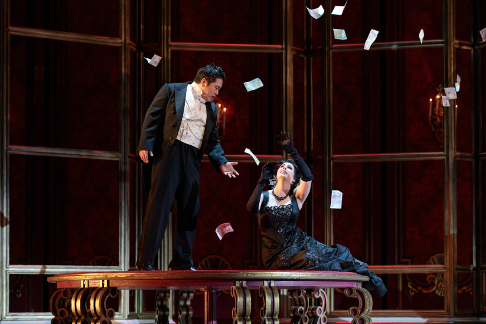 Kang Wang as Alfredo and Amanda Woodbury as Violetta
Kang Wang as Alfredo and Amanda Woodbury as Violetta
In spite of the expanse of the settings, Ms. Zambello has managed to create a very intimate experience through well-motivated blocking, carefully judged character relationship, and highly inventive stage business. I loved the way Violetta and Alfredo jumped on the long tables during the Brindisi walking to meet each other center above the heads of the other guests. And I loved that Alfredo mirrored that by jumping on a gaming table to denounce Violetta from above in Act III. There was wonderful use of a vase of flowers in Act II, which also had country farmhands parade across the back of the stage with a live chicken and dog. And then there was the spooky return to the sanatorium at the end of Act I. And, and, and. There were simply too many entertaining, illuminating, honest, heart-tugging moments to document here.
While Andrea Beasom contributed some clever choreography to enliven Flora’s party scene, it was emphatically Ms. Zambello’s creative staging combined with the sterling music-making and effective design that made this a La Traviata to treasure and cheer.
James Sohre
La Traviata
Music by Giuseppe Verdi
Libretto by Francesco Maria Piave
Violetta Valéry: Amanda Woodbury; Alfredo Germont: Kang Wang; Giorgio Geront: Adrian Timpau; Gastone de Letorières: Kameron Lopreore; Baron Douphol: Jonathan Bryan; Marchese d’Obign: Schyler Vargas; Doctor Grenvil: Wm. Clay Thompson; Flora Bervoix: Lindsay Metzger; Annina: Bryn Holdsworth; Giuseppe: Aaron Crouch; Messenger: Allen Michael Jones; Flora’s Servant: Peter Morgan; Conductor: Joseph Colaneri; Director: Francesca Zambello; Set Design: Peter J. Davison; Costume Design: Jess Goldstein; Lighting Design: Mark McCullough; Choreographer: Andrea Beasom; Original Choreographer: Parker Esse; Hair and Make-up Design: Samantha M. Wootten; Chorus Master: Katherine Kozak.
image=http://www.operatoday.com/KarliCadel-GGF19-Traviata-GenDress-3528.png image_description=Amanda Woodbury as Violetta [Photo by Karli Cadel/The Glimmerglass Festival] product=yes product_title=La Traviata at Glimmerglass product_by=A review by James Sohre product_id=Above: Amanda Woodbury as ViolettaAll photos by Karli Cadel/The Glimmerglass Festival
Médée in Salzburg
Médée has been greatly admired by following generations of composers especially for its orchestral interludes (and by a particular singer, Maria Callas, as a brilliant showpiece for soprano). With the Vienna Philharmonic in the pit the Salzburg Festival evidently invites us to consider Médée as viable dramatic music for now, not as an interesting relic for period instruments.
The spoken opéra comique origins of Medée built a dramatic context for its several scenes and choruses, its three arias (Dircé, Créon, Néris), the grandiose duet (Jason and Médée) that concludes Act I, and Médée’s famed final scene — the murder of her two children. With spoken dialogues in opera long out of fashion Australian theater director Simon Stone turned to film aka movies, to televised news, to phone calls and to phone messages to absolutely overwhelm us with context.
Stripped of any of the trappings of French classical tragedy Cherubini’s Médée is a very small if a very smart piece of music. The Grosses Festspielhaus is very big. Stage director Stone’s movie (video) told a parallel story to Cherubini’s operatic sketch in huge black and white full stage screen images. The singers became film actors (and very good ones!) and went through the motions of a Salzburg couple’s marriage breaking up. The husband was unfaithful, and the ugly origins of the marriage (Médée's betrayal of her father and murder of her brother) were never mentioned. Stage director Stone's Médée was but an innocent victim.
As well there were huge black outs when all we heard in the total silence were the highly amplified, desperate phone messages left by the abandoned woman.
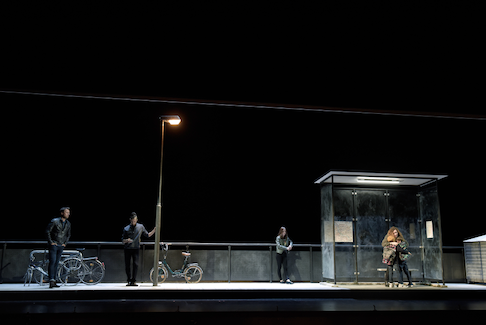 The bus stop where Janson entrusts the children to Médée
The bus stop where Janson entrusts the children to Médée
When the stage was not a giant movie screen stage director Stone made his stage set hyper realistic — a bridal shop, a night club with pole dancing, a hotel lobby, a hotel room with a giant TV screen and an a vista shower, a hotel banquet room with its restroom, a shabby internet cafe, an international airport, a bus stop and a gas station. Yes, it was a huge production.
Although at the end Médée shot gasoline all over the stage she failed to ignite it, depriving us of the spectacular conflagration that could have wiped all this excess out. The immolation was but a slight bit of theatrical fog and dim red light inside a shiny silver car, hardly the precise detail of the balance of the production.
There was infinite costuming detail, there was even a reference to cheap Turkish Airlines flights.The production seemed more Eastern European than Eastern Mediterranean. It is a co-production with Polish National Opéra.
Cherubini’s opera Médée was a superfluous addition that all but disappeared in director Stone’s melée. The Salzburg Festival engaged German rare music guru, conductor Thomas Hengelbrock to mastermind our musical initiation into this rare opera. Certainly the extensive overture was beautifully rendered by the Vienna Philharmonic, however the seriousness of its structures and colors disappeared into the turgid divorce emotions occurring on the stage’s giant screen.
From time to time Cherubini’s Médée was able to catch our attention. The orchestral introduction to Créon’s aria was of Wagnerian proportion in its crescendo of power, the Act I duet finale captured a magnificent Médée rage. Médée’s confidant Néris’ splendid aria in duet with a bassoon involved us and of course the famed finale in which Médée rationalizes the murdering of her children was spellbinding, though the immediacy and urgency of the performance did not reach the rear orchestra where I was seated.
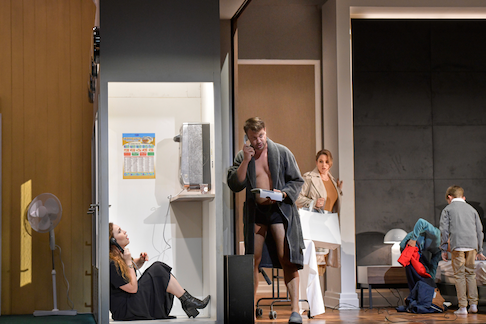 The Act 1 duet finale, Médée in a phone both far away, Jason in his hotel room, Néris and children
The Act 1 duet finale, Médée in a phone both far away, Jason in his hotel room, Néris and children
Russian soprano Elena Stikhina effectively negotiated the role of Médée as required by director Stone. It was securely sung and effectively acted without finding mythic or even theatrical stature. Italian soprano Rosa Feola sang Dircé’s complex air with assurance, her apparent vocal prowess barely tapped. Russian mezzo Alisa Kolosova made her aria of resolve to help Médée one of the evening’s high points. Neither bass Vitalij Kowaljow as Créon nor Czech tenor Pavel Ćernoch as Jason made sufficient effect. Both are estimable artists in the major repertoire on major stages, obviously not at home in early music.
The evident intention was to render Cherubini’s Médée a grand opera of dramaturgical complexity. The attempt was not successful.
Michael Milenski
Cast and production information:
Médée: Elena Stikhina; Jason: Pavel Ćernoch; Créon: Vitalij Kowaljow; Dircé: Rosa Feola; Néris: Alisa Kolosova; First attendant: Tamara Bounazow; Second attendant: Marie Andrée Bouchard-Lesieur. Concert chorus of the Vienna State Opera and Vienna Philharmonic. Conductor: Thomas Hengelbrock; Stage director: Simon Stone; Sets: Bob Cousins; Costumes: Mel Page; Lighting: Nick Schlieper; Sound design: Stephan Gregory; Dramaturgy: Christian Arseni. Grosse Festspielhaus, Salzburg Festival, August 16, 2019 (fifth of six performances).
image=http://www.operatoday.com/Medee_Salzburg1.png
image_description=Elena Stikhina as Médée [All photos copyright Salzburger Festspiele / Thomas Aurin]
product=yes
product_title=Médée at the Salzburger Festspiele
product_by=A review by Michael Milenski
product_id=Above: Elena Stikhina as Médée [All photos copyright Salzburger Festspiele / Ruth Walz]
August 19, 2019
Queen: A Royal Jewel at Glimmerglass
First, Kelley Rourke has effectively condensed Pushkin’s story by taking the most indispensible musical highlights in the tuneful score, shedding the chorus and extraneous plot twists, and distilling the whole into 70 cogent minutes of considerable pleasure. Ms. Rourke has also crafted a quite poetic, very singable translation of utmost clarity and has been ably abetted in this pursuit by composer Nicolas Lell Benavides who has imaginatively re-scored the lush orchestration for just five players.
But what players they are! Although not credited in the program book, the violinist, cellist, bassist, pianist, and clarinetist (doubling on bass clarinet) performed superbly under the baton of Apprentice Conductor Michelle Rofrano. Maestra Rofrano elicited thrilling, evocative results from her exquisite chamber players and she ably supported her singers in relating the drama. And what singers they were!
The seasoned soprano Patricia Schuman’s Countess was a Masters Class in refined singing and concentrated stage comportment. Ms. Schuman can merely raise an eyebrow and communicate volumes in her laser focused characterization. Moreover, many years into a successful international career, she is singing wonderfully, her substantial instrument still fresh and powerful. That this treasurable artist was matched in quality by the remaining cast of Apprentice Singers is a testament to that training program, helmed by Allen Perriello.
The demanding roles of Hermann and Lise challenge even the starriest of singers in the operatic firmament. On the basis of their performances here, I can predict you will hear much much more of tenor Maxwell Levy and soprano Julia Wolcott.
Mr. Levy is that rare, somewhat dark voiced tenor who not only has the stentorian delivery needed to fill any hall, but also the ability to scale it back with gorgeous results, as he imbues his vocalization with immense heart and feeling. He meticulously communicates Hermann’s ambition as well as his secondary passion for Lise. Ms. Wolcott‘s generous, warm soprano is deployed in utter service to the heroine’s plight, intrigued by Hermann, but knowing that Prince Yeletsky is the better choice. Her luminous reading of the deeply conflicted emotions that lead to her suicide was enormously touching in its wrenching delivery.
Ben Schaefer, who had been such a nonpareil Figaro in The Ghosts of Versailles two nights prior, proved an exceptional Prince Yeletsky on this occasion. Mr. Schaefer’s debonair appearance was matched by a resonant baritone that limned his famous aria with awesome legato phrases dripping with easy elegance.
Nicholas Davis was a commendable Tomsky, his rolling baritone packing theatrical bite and punch. The role of Narumov was skillfully impersonated by Christopher Carbin, whose agreeable bass had sheen and amplitude. In the triple roles of Chekalinsky, Surin, and the Servant, Spencer Hamlin’s steady tenor had a pleasant hint of shining steel.
The clever set design by James F. Rotondo III capitalized on the Pavilion space with a thrust configuration. A platform with the Countess’ imposing, imperious chair is against one side backed by fragmented, cockeyed flats with ornate trim and crimson damask wall covering, suggesting both Hermann’s instability and the opulent premises. A narrow central stage juts out into the room, with an elegant faux inlaid wooden floor painted on it. The chamber players are accommodated on the house left corner of the platform, with performers being able to enter on to the thrust through the audience, which surrounded the playing space.
Loren Shaw’s spot-on costume design gave every character just the right look to communicate their station. She also conveyed the irascibility and volatility of the old Countess with several clever looks and changes. S. Stoli Stolnack’s lighting design was of necessity simple, even, and effective, and it was no small feat to illuminate the “stage” while avoiding shining lights in the eyes of the audience that was mere feet away.
Perhaps best of all, tying the bow on the gift package was director Francesca Zambello, whose staging was a miracle of invention. Ms. Zambello excels at creating focused character relationships and the interaction of the performers was consistently credible and informed. Too, she moved the characters around the small space with the skill of a chess master, always repositioning them to favor all lines of vision, and unfolding the tale with spontaneity and inevitability. The effect of the piece relied on a well-controlled, inexorable build of tension until the big payoff, which was so well managed it electrified the room.
This reduced version of The Queen of Spades was spoken of as something of an experiment. If the sold out, cheering houses are any indication, I think the response is: More, please.
James Sohre
The Queen of Spades
Music by Pyotr Ilyich Tchaikovsky
Based on a short story by Alexander Pushkin
Musical arrangement by Nicolas Lell Benavides
New translation and adaptation by Kelley Rourke
Lise: Julia Wolcott; Hermann: Maxwell Levy; Countess: Patricia Schuman; Paul Tomsky: Nicholas Davis; Narumov: Christopher Carbin; Chekalinsky/Surin/Servant: Spencer Hamlin; Prince Yeletsky: Ben Schaefer; Conductor: Michelle Rofrano; Director: Francesca Zambello; Set Design: James F. Rotondo III; Costume Design: Loren Shaw; Lighting Design: S. Stoli Stolnack
image=http://www.operatoday.com/i-9pZm9J5-X3.png image_description=The Glimmerglass Festival's Alice Busch Opera Theater. Photo: Karli Cadel/The Glimmerglass Festival product=yes product_title=Queen: A Royal Jewel at Glimmerglass product_by=A review by James Sohre product_id=Above: The Glimmerglass Festival's Alice Busch Opera Theater. [Photo by Karli Cadel/The Glimmerglass Festival]Blue Diversifies Glimmerglass Fare
The ambitious project tackles a disturbing violent pattern ripped from the headlines, namely, the disproportionate police shooting of black men. It does not need a spoiler alert to tell you that we already know that such a tragedy will be covered in the piece. And since there is only one African-American family and one son in the show, there is little suspense in who the victim(s) will be.
The interest, therefore, resides in the character relationships, and the journey they take before and after the killing. I wished that the resulting piece had been as moving and sobering as its well-meaning intent. At this point in its development, I found Blue to be a very promising work in progress that has much more potential to be mined and refined. Certainly the creators are highly acclaimed practitioners and their expertise is everywhere evident in the project.
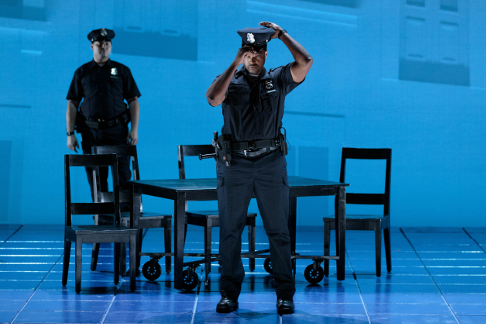 (Front) Kenneth Kellogg as The Father
(Front) Kenneth Kellogg as The Father
Tazewell’s story proceeds in pretty big chunks, albeit tinged with eloquence. The Father becomes a policeman and banters with his colleagues. The pregnant Mother chatters with her girlfriends. The Son is born and grows up (almost instantaneously) to become a rebellious teen. Father and Son argue. Tragedy strikes (during intermission). The grief stricken Father confronts the Reverend. The Son is buried as his parents weep. And the final flashback scene (or is it fast forward phantasy?) evokes the healing ending of the film Places in the Heart.
To my taste, each scene went on past the time its point was made, becoming repetitious and weakening the very real merits of the material. The character establishment was very solidly done. The character development deserves more attention.
It does not help the impact that the Mother disappears pretty much after her son’s birth in Act One, and that we only see her next at the funeral. It did not arouse my sympathies that the belligerent teenage Son is only given an argumentative scene with his Father, that is not only devoid of loving feelings, but presents the Son as quite unlikeable.
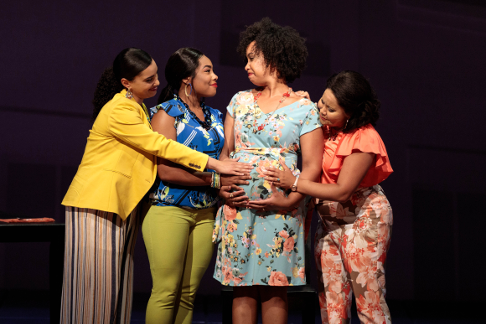 (From left) Mia Athey as Girlfriend 3, Brea Renetta Marshall as Girlfriend 2, Briana Hunter as The Mother and Ariana Wehr as Girlfriend 1
(From left) Mia Athey as Girlfriend 3, Brea Renetta Marshall as Girlfriend 2, Briana Hunter as The Mother and Ariana Wehr as Girlfriend 1
Too, there are illogical moments like the Father’s confrontation with the Reverend in which dad does not want to hear any comfort the priest offers. As he rails against the cleric for a very extended scene, I wasn’t sure why the Father was there, or why he didn’t just leave. Because we never got to experience the love this family shared for each other, the lengthy funeral, although rife with vocal beauty, was generically sad. Without ruining the surprise of the final scene, it seems its warmhearted sentiments should have been on display much earlier in Blue. There are so many rich possibilities in fine-tuning this important endeavor, that I encourage the creative duo to amplify and tighten dramatic beats and flesh out these iconic characters.
The gifted Ms. Tesori is incapable of being uninteresting and her score is often stirring and, as is her wont, certainly unique to the project at hand. There is a wondrous rising scale over an octave that is immensely appealing. The score is commendably singable, and the ensemble writing is often shimmering, with a sextet of voices intertwining to great effect at the funeral. The soloists are given wide-ranging declamations that have interesting variety. The Father has a Wheels of a Dream number that is very melodious and enjoyable, if lacking the final poignancy that might define him even further.
I very much liked Ms. Tesori’s trio of (sometimes back-up) singers, one male, one female, that recalled her fine work in Caroline or Change. She also has made judicious and exceptional use of a cinematic swell and sweep that help the concept to soar.
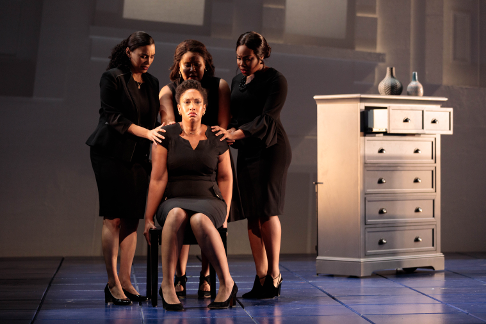 (From left) Mia Athey as Girlfriend 3, Briana Hunter as The Mother, Ariana Wehr as Girlfriend 1 and Brea Renetta Marshall as Girlfriend 2
(From left) Mia Athey as Girlfriend 3, Briana Hunter as The Mother, Ariana Wehr as Girlfriend 1 and Brea Renetta Marshall as Girlfriend 2
The production is staged simply and effectively by Tazwell Thompson himself. All of his hallmark qualities are there: Efficient use of movement, well-internalized portrayals, economy of gesture, and telling stage pictures. Donald Eastman’s unfussy set design consisted of carefully selected furniture, that gets re-arranged in front of a backdrop which is a forced perspective of white row houses. Robert Wierzel’s evocative lighting includes the ability to vary the color of the backdrop to telling effect. Jessica Jahn’s effective costumes greatly helped to establish the characters. I quite admired how Ms. Jahn went for a more stylized look at the funeral, and that Mr. Eastman subtly changed the furniture and dressing to black colors after the tragedy.
The eminent John DeMain conducted this varied composition with polish, panache and a sure hand. The style occasionally found the large orchestration getting a little rambunctious for the unamplified singers, but Maestro DeMain successfully reined his accomplished players in to provide colorful and harmonious support. The small cast acquitted themselves well.
Kenneth Kellogg gets the most stage time as the Father and he moored the production with a solid presence and a robust baritone. Mr. Kellogg had all the fire power needed for the searing outbursts, but also showed he could scale back for very affecting introspective musings. His resonant, rolling bass is a remarkably fine instrument and his powerful role assumption is the work’s chief glory.
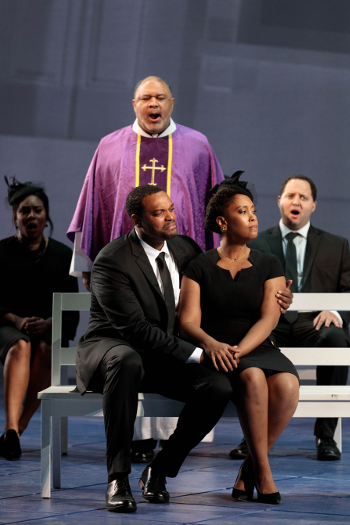 (Clockwise from top) Gordon Hawkins as The Reverend, Briana Hunter as The Mother and Kenneth Kellogg as The Father with members of the ensemble
(Clockwise from top) Gordon Hawkins as The Reverend, Briana Hunter as The Mother and Kenneth Kellogg as The Father with members of the ensemble
Briana Hunter was a wholly engaging personality as the Mother, first all girlish anticipation as she is expecting her baby, then all classic tragedienne as she keens in mourning. Her smoky, alluring mezzo is capable of playful wide-ranging deployment one scene, while also able to pour out profoundly arching grief in another. Her dramatic commitment is second to none, although on occasion she pushed a bit and a slight rasp came into her delivery. Ms. Hunter is a distinguished alumnus of the Apprentice Artist program.
Aaron Crouch was eminently convincing as the contentious teenaged Son, his youthful slouching frame housing a weighty tenor that is quite baritonal at the bottom, but brightens up as it ascends. He was challenged by a few high exposed phrases where his technique tightens, but Mr. Crouch contributed a solid impression and held his own in the heated argument with the seasoned Mr. Kellogg. As the Reverend, veteran Gordon Hawkins brings a wealth of experience to bear along with a penetrating, poised baritone of uncommon power and malleability. Mr. Hawkins’ duet scene with Mr. Kellogg crackled with tension.
Arian Wehr’s petite presence, effortless charm, and charismatic, limpid soprano earned her a nice ovation for her roles as the Nurse and Girlfriend and Congregant One. Brea Renetta Marshall’s hauntingly lovely soprano made a fine contribution as Girlfriend and Congregant Two. Mia Athey’s plush mezzo rounded out the women’s trio, and her sincere delivery was welcome, but while her top rings out quite securely, some lower passages were less steady.
On the male side, Camron Gray deployed his radiant tenor quite artfully as Policeman and Congregant One. Tenor Edward Graves’ appealing persona and honeyed, focused tone made him a perfect choice for Policeman and Congregant Two. And Nicholas Davis poured out a sonorous baritone that was consistently attractive as Policem and and Congregant Three.
I applaud Glimmerglass for including a work of such diversity in its season in an admirable outreach to attract underserved demographics. This speaks powerfully to all people, but it must especially resonate with the community depicted in the work. It was curious to note that, in spite of the company’s well-oiled marketing and audience development division, the audience was almost completely Caucasian. Nevertheless, they seemed to find great resonance in Blue and roundly cheered its many accomplishments.
James Sohre
Blue
Music by Jeanine Tesori
Libretto by Tazewell Thompson
The Father: Kenneth Kellogg; The Mother: Briana Hunter; The Son: Aaron Crouch; The Reverend: Gordon Hawkins; Girlfriend 1/Nurse/Congregant 1: Ariana Wehr; Girlfriend 2/Congregant 2: Brea Renetta Marshall; Girlfriend 3/Congregant 3: Mia Athey; Policeman 1/Congregant 1: Camron Gray; Policeman 2/Congregant 2: Edward Graves; Policeman 3/Congregant 3: Nicholas Davis; Young Child: Jayden Kellogg; Conductor: John DeMain; Director: Tazewell Thompson; Set Design: Donald Eastman; Costume Design: Jessica Jahn; Lighting Design: Robert Wierzel; Hair and Make-up Design: Samantha M. Wootten
image=http://www.operatoday.com/KarliCadel-GGF19-Blue-StageOrch-1113.png image_description=(From left) Kenneth Kellogg as The Father, Aaron Crouch as The Son and Briana Hunter as The Mother [Photo by Karli Cadel/The Glimmerglass Festival] product=yes product_title= product_by=A review by James Sohre product_id=Above: (From left) Kenneth Kellogg as The Father, Aaron Crouch as The Son and Briana Hunter as The MotherAll photos by Karli Cadel/The Glimmerglass Festival
Vibrant Versailles Dazzles In Upstate New York
Composer John Corigliano and librettist William H. Hoffman have crafted a richly multi-layered existential dynamic that intertwines the ghosts of the title (the ruling class of the court of Louis XVI), with an opera staged by the playwright Beaumarchais based on his La Mère coupable, with characters from his first two Figaro plays.
Beaumarchais seems to be more rooted in the present as facilitator of the action, who is trying to cheer up the ghost of Marie Antoinette, not at all happy that she has been beheaded. In the opera-within-an-opera, Count Almaviva is a Spanish Ambassador, in Paris with his servant Figaro, who are both being used by Beaumarchais, (in love with Marie), to rewrite history and save her from the French Revolution. As things go astray, Beaumarchais writes himself into the opera and attempts to rescue the queen with help from Figaro and Susanna.
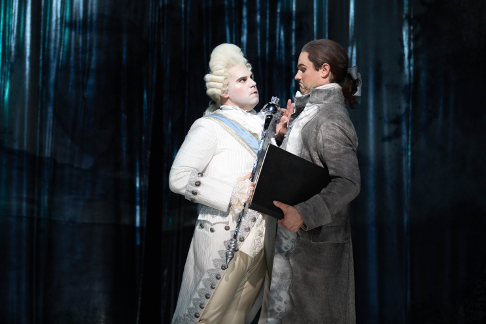 Peter Morgan as King Louis XVI and Jonathan Bryan as Beaumarchais
Peter Morgan as King Louis XVI and Jonathan Bryan as Beaumarchais
If this sounds structurally complex, it is, but richly so. While the libretto contains a few improbabilities, Mr. Hoffman’s witty, fascinating writing is endlessly engaging and often, effortlessly funny. Mr. Corigliano’s score meanders through atonality to neo-romanticism to neo-classicism to loving pastiche with a fluid abandon. The juxtaposition and definition of the players in the “opera” and the spirits hoping to be released from their boring nether world is marked by clarity of tonal palette and precision of scripting.
The physical production does much to ground the concept. James Noone’s superlative set design at once defines the evening’s premise. A show(er) curtain of floor to ceiling strips of cloth at first slightly obscures the black and white and grey concave walls upstage, which are decorated with misty wallpaper effects and liberally dotted with sconces that match the elaborate chandeliers overhead.
It turns out that the curtain has a complementary design projected on it that breaks up as actors pass front and back through it, mirroring the unsettling music that sets the mood. The curtain flies out revealing lethargic ghosts, languishing in purgatory, preferring lasting death to eternal waiting. The muted walls glide effortlessly to meet in the middle and close off the upstage to allow for the placement of ever changing set pieces for Beaumarchais' opera, which are then revealed in colorful contrast to the gloomy, moody spirit world.
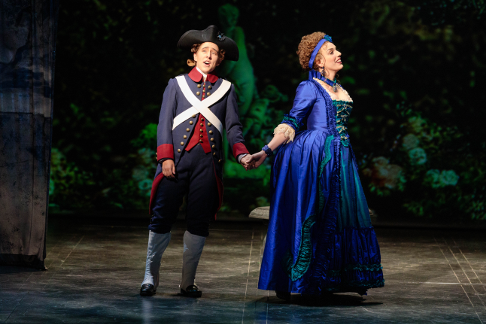 Katherine Maysek as Cherubino and Joanna Latini as Rosina
Katherine Maysek as Cherubino and Joanna Latini as Rosina
Nancy Leary’s stupendous costume design is almost beyond praise. The white, and off-white period attire for the ghosts communicates elegant despair, and the jewel-toned costumes for the players in the “opera” are eye-popping in their characterful allure. Samantha M. Wootten has contributed a magical make-up design that deftly balances a beautifully bewigged pallor for the spirits with the theatrical punch for the opera singers. Robert Wierzel’s multi-layered lighting design manages the same feat, colorfully and brilliantly illuminating the “opera performance” while deploying shimmering effects in the ghostly world that suggest the vanishing sheen of royalty.
Glimmerglass “in the day” would have cast the principal roles with established singers, and the features with Apprentice Artists. Over the past few years, more and more leading parts have been peopled by Apprentices, usually to good effect. I have noticed a definite, calculated, incremental rise in the overall quality of the young singers in the Apprentice program, marked by discerning casting and recruitment under the leadership of Allen Perriello.
With Versailles, the company took its biggest leap of faith yet, with only Marie Antoinette taken by a non-Apprentice singer, the luminous Ukrainian-American soprano Yelena Dyachek. The lovely Ms. Dyachek commanded the stage with a highly sympathetic portrayal, her creamy, poised vocalizing never tiring in this long role. Her melting and theatrically vivid performance of the aria Once There Was a Golden Bird was a ravishing highlight of the evening. By the time we got to Marie’s touching finale, as she embraces death, we had been treated to a role traversal that was as well-voiced as it was profoundly moving.
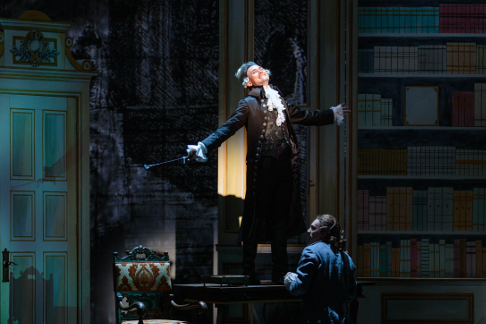 (Center) Christian Sanders as Bégearss and Tucker Reed Breder as Wilhelm
(Center) Christian Sanders as Bégearss and Tucker Reed Breder as Wilhelm
Jonathan Bryan was a potent partner as Beaumarchais. His handsome, lanky physique cut an elegant figure and his singing matched the look, with smooth, arching phrases, good punch and presence, and buzzy high notes. Mr. Bryan’s substantial sound had no problem filling the house, and he could also scale back his delivery to engaging pensive effects.
Ben Schaefer’s no-holds-barred Figaro threatens to steal every scene he is in, if not the whole damn’ show. Another tall, lean, attractive performer, Mr. Schaefer's inspired antics threatened to shame the Energizer Bunny for slacking. He prances, he dances, he climbs, he wiggles, and oh yes, he sings, too! And indeed, he sings extremely stylishly, with an evenly produced, abundantly appealing baritone of considerable refinement.
The villainous Patrick Honoré Bégearss is served up with obvious relish, with a side of scenery to chew on, by Christian Sanders. Mr. Sanders’ clarion, bright-toned tenor sailed through the treacherous Aria of the Worm with nary a problem, undaunted by the tessitura or imposing orchestration. As much as I admired his steely generosity, I actually found his instrument even more attractive and interesting when he lightened up.
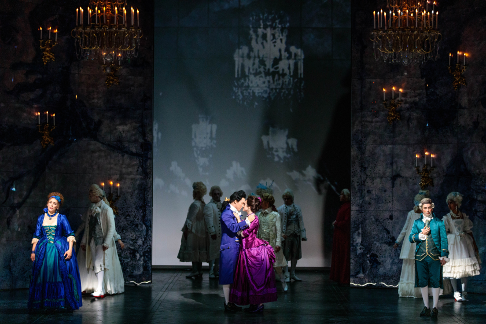 (Front from left) Joanna Latini as Rosina, Spencer Britten as Léon, Emily Mirsch as Florestine and Brian Wallin as Count Almaviva
(Front from left) Joanna Latini as Rosina, Spencer Britten as Léon, Emily Mirsch as Florestine and Brian Wallin as Count Almaviva
Brian Wallin proved another gifted tenor, whose wiry Count Almaviva took the stage with flair and commitment. He sold the part with meaty, pliable singing that had ample personality and flair. Joanna Latini’s Rosina was well served by a generous, excellently colored soprano that was exceptionally communicative and appealing. Emily Misch was radiant as Florestine, her smooth, silvery soprano showing fine presence in all volumes and registers. Tenor Spencer Britten imbued his impersonation of Leon with bright toned delivery and a loveable puppy dog deportment. Katherine Maysek’s substantial, throbbing mezzo served the role of Cherubino well, and she paired luminously with Ms. Latini in a fetching duet.
Gretchen Krupp was a firebrand of a Samira, a wholly gratuitous role that was written as a star turn for the indomitable Marilyn Horne when the work premiered at the Met. It is to Ms. Krupp’s great credit that she makes the role work beautifully on her own terms. Hers is a mezzo capable of searing delivery, powerful and ripe, but capable of nuance and yes, humor. Of course, no one has the barrel-toned chest tones that were Ms. Horn’s calling card, but Gretchen impresses with her stage savvy, comic timing, and just plain evident joy in singing for us.
The large cast includes even more wonderfully rendered cameos and exceptional featured moments, that they are too numerous too mention. It is worth noting that Peter Morgan’s shining, resonant bass-baritone was a fine match for the role of Louis XVI; that Wm. Clay Thompson’s suave, secure bass made a great impression as Suleyman Pasha; and that Charles H. Eaton’s solid baritone made the most of his brief appearance as the English Ambassador. Please read the cast list below and know that each and every one deserves a bravo.
In the pit, Joseph Colaneri kept the proceedings percolating with admirable unity of purpose and dramatic investment. Maestro Colaneri conducted with aplomb and obvious command of the ever-shifting musical genres. The accomplished orchestra responded with a cornucopia of impressive effects, including radiant string passages, tasty wind solos, snarling brass licks, and telling percussive punctuations. He also partnered beautifully with his singers to present a mellifluous ensemble effort, beautifully judged in its dramatic fruition. Katherine Kozak’s well-schooled chorus was the icing on the gâteau.
Jay Lesenger’s stage direction was a bit of a mixed bag. On the one hand, individual character relationships seemed well explored. The overall arc of the piece was achieved and there was good clarity in the storytelling. On the other hand, the group scenes were often diffuse, frenetic, and/or looked over-populated. The big crowd scenes needed some attention to focus them up, and to impose some variety on the proceedings. The big chase scene (of Figaro) at the end of Act One was especially repetitive and unbelievable.
The original production for the Metropolitan Opera was decidedly over-the-top “grand” and called for massive musical forces. I was privileged to see the reduced version at Opera Theatre of Saint Louis (which also went to Wexford). This new smaller-scale mounting at Glimmerglass loses nothing of the punch of the original, and even gains in impact in this smaller theatre.
While Corigliano and Hoffman made some substantial cuts since the world premiere, there are still a (very) few longueurs in the piece. Figaro’s aria, the Worm Aria, the finale of Act I among others, go on perhaps 32 bars longer than needed to make their effect. But, small matter. The Ghosts of Versailles is an utterly fascinating piece of lyric theatre, one that deserves many further productions.
As for the accomplished casting, the assemblage of prodigiously talented Apprentice Artists promised much. Happy to report: Promises made. Promises kept.
James Sohre
The Ghosts of Versailles
Music by John Corigliano
Libretto by William H. Hoffman
GHOSTS: Marie Antoinette: Yelena Dyachek; Beaumarchais: Jonathan Bryan; Louis XVI: Peter Morgan; Marquis/Page: Zachary Rioux; Ghost Quartet: Bryn Holdsworth, Lindsay Metzger, Maxwell Levy, Christopher Carbin; Gossip 1: Teresa Perrotta; Gossip 2: Abigail Paschke; Gossip 3: Simran Claire; Woman with Hat/Duchess: Noragh Devlin
PLAYERS IN THE OPERA: Figaro: Ben Schaefer; Susanna: Kayla Siembieda; Rosina: Joanna Latini: Count Almaviva: Brian Wallin; Patrick Honoré Bégearss: Christian Sanders; Florestine: Emily Misch; Léon: Spencer Britten; Cherubino: Katherine Maysek; Samira: Gretchen Krupp; Suleyman Pasha: Wm. Clay Thompson; Wilhelm: Tucker Reed Breder; Pursuer/Revolutionary: Tanyaradzwa A. Tawengwa; English Ambassador: Charles H. Eaton; Living Marie Antoinette: Rachel Kay; Bishop/Swordsman: Jawan Cliff-Morris; Dancers: Shanel Bailey, Rachel Kay, Joshua Kring, Jorrell Lawyer-Jefferson
PRODUCTION: Conductor: Joseph Colaneri; Director: Jay Lesenger; Set Design: James Noone; Costume Design: Nancy Leary; Lighting Design: Robert Wierzel; Choreographer: Eric Sean Fogel; Hair and Make-up Design: Samantha M. Wootten; Chorus Master: Katherine Kozak
image=http://www.operatoday.com/KarliCadel-GGF19-GhostsVersailles-GenDress-2778.png image_description=Yelena Dyachek as Marie Antoinette [Photo: Karli Cadel/The Glimmerglass Festival] product=yes product_title=The Ghosts of Versailles at Glimmerglass product_by=A review by James Sohre product_id=Above: Yelena Dyachek as Marie AntoinetteAll photos by Karli Cadel/The Glimmerglass Festival
Gilda: “G for glorious”
Imagine our relief, then, when Lindy Hume’s remount of her 2012 New Zealand staging proved to be a brisk, colorful, and unskewed production.
Designer Richard Roberts’ quasi-contemporary design for act one promised a show in itself. It did not disappoint, rising, folding, and rotating, from full stage to intimate scenes and back again.
It was particularly felicitous in making sense of the notoriously hard-to-stage nocturnal episode outside the Ceprano Palace and Rigoletto’s humble flat. It was good to have Roberts’ set to keep us interested, because the performance it framed was curiously inert.
As the lights came up and the well-dressed all-boy chorus began to yap with anticipation of booze and flooze to come, the mopy white-jacketed gent we’d glimpsed during the overture all but vanished in the melée.
This had to be Rigoletto, though he looked like an aged busboy wearing a Groucho mask. But as the action unfolded, the living threat the jester has to generate to dominate a stageful of enemies never emerged.
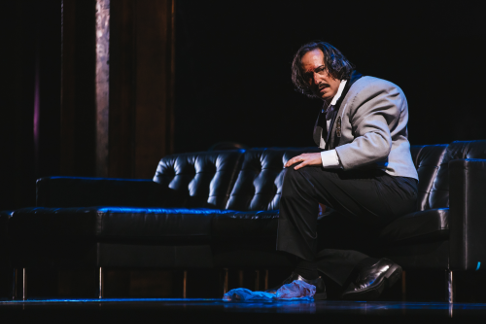 Giuseppe Altomare as Rigoletto [Photo by Sunny Martini]
Giuseppe Altomare as Rigoletto [Photo by Sunny Martini]
Rigoletto as a nebbish: not even a waspish Groucho, more a whining Woody Allen. Giuseppe Altomare has a sizable dark bass-baritone, but with very little range of color and no heat. He’s just miscast in a role that demands sweetness one moment and lava the next.
His boss and nemesis, the playboy Duke, played beige to his charcoal. Yongzhao Yu is a big boyish lad; he has all of the notes and none of the flair the role requires: no humor, no malice, no passion: zip.
It is up to the Gilda of Soraya Mafi to shoulder the weight of this production, and she very nearly manages to get it off the ground. When she is on stage, her tiny post-adolescent figure and adorably open face fix our attention utterly, and when she sings we rise with her. I have never heard a more perfectly phrased “Caro nome,” but her every note and moment are equally simple, moving and right.
Slavic singers seem to have a corner on the role of Sparafucile: Croatian Ante Jerkunica has exactly what the role requires: an inky bass that’s naturally scary, a shaved dome and loose, lanky body that’s made to wear a dark hoodie and scuffed tennis shoes, and a kind of brutal innocence that’s more creepy than overt menace.
It’s too bad that Jonathan Dean’s supertitles stick him with a revolver (that doesn’t go off) instead of a dagger, confusing the drama of Gilda’s fatal wounding. (It’s even more distracting when Dean forgets a moment later and the word “knife” appears on the screen.)
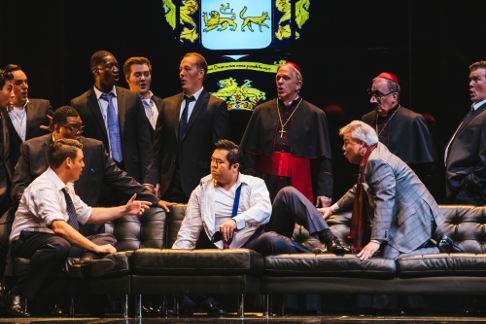 Yongzgao Yu as the Duke of Mantua [Photo by Sunny Martini]
Yongzgao Yu as the Duke of Mantua [Photo by Sunny Martini]
In a way that’s characteristic of this Rigoletto: always interesting to look at, it’s dotted with little details that that don’t come off : the Duke’s sleepy-mask while he laments the loss of Gilda; the two bishops in full regalia who take part in her abduction: the Duke pretending to hide behind an armchair in Rigoletto’s kitchen, like an oversized Cherubino; Monterone turning up in a dressy new costume in the Duke’s morning-room on his way to execution…
And except for Gilda and her assassin, just not very movingly sung. Carlo Montanaro is an essentially lyric conductor, who drifts toward moderato whatever the tempo marking to moderate tempos and favors a suave sound over anything harsh or edgy.
I suspect he’s what is known in the trade as “a singers’ friend.” But what makes singers comfortable may let the passion seep away.
Roger Downey
Cast and production information:
The Duke of Mantua – Yongzhao Yu; Rigoletto – Giuseppe Altomare; Gilda – Soraya Mafi; Sparafucile – Ante Jerkuniča; Maddalena – Emily Fons; Borsa – Bernard Holcomb; Marullo – Barry Johnson; Count Ceprano – Jonathan Silvia; Countess Ceprano – Meghan Folkerts; Count Monterone – Clayton Brainerd; Giovanna – Nerys Jones; Page – Ivy Zhou. Direction – Lindy Hume (associate Daniel Pelzig); Design – Richard Roberts; Lighting – Jason Morphett; Supertitles – Joinathan Dean; Fight director: Geoffrey Alm. Seattle Opera Male Chorus (chorusmaster – John Keene). Members of the Seattle Symphony Orchestra. Carlo Montanaro, conductor.
image=http://www.operatoday.com/190806_Rigoletto_DR_1437.png image_description=Soraya Mafi as Gilda in Rigoletto [Photo by Philip Newton] product=yes product_title=Rigoletto at Seattle product_by=A review by Roger Downey product_id=Above: Soraya Mafi as Gilda in Rigoletto [Photo by Philip Newton]All photos courtesy of Seattle Opera
August 18, 2019
Simon Boccanegra in Salzburg
The evening belonged to conductor Valery Gergiev, a gift to him by veteran Berlin Volksbūhne stage director Andreas Kriegenburg and set designer Harald B. Thor who placed a huge black Steinway concert piano as the sole dressing of the huge expanse of white marble that was the stage. The production was indeed not about locale (though in fact the feel was pure Genoese architect Renzo Piano), it was about lyricism.
There was only the piano except for the small black chair in which at the end Simone died and into which fell a confused Adorno as he was proclaimed the city’s new doge. Had it not been brilliant theater it would have been a concert staging.
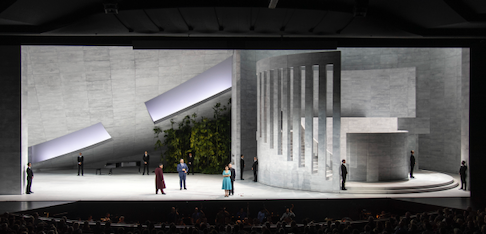 The full stage unit set, Amelia in blue front and center
The full stage unit set, Amelia in blue front and center
Much happened in between Boccanegra's election and his death. Moment after moment recalled the great Verdi and presaged his most profound gestures — the indelible tonalities of Traviata, the male bonding in Otello, and most moving of all, the Don Carlo minor second weeping of Fiesco in his duet of reconciliation with the dying Boccanegra.
If no stylistically defining moments emerge from Simon Boccanegra it is not from a lack of splendid arias and duets in moments of extreme duress and of ecstatic resolve. Simon Boccanegra is a sprawling tale of splintered focus, no one character assumes an immensity of theatrical presence — Simone is overwhelmed by affairs of family and of state, the villain Paulo has confused motives, the grandfather Fiesco suffers a complicated history, Adorno appears out of nowhere and Amelia will not be upfront with anyone.
Still there is lots to sing about, maybe too much. Stage director Kriegenburg got the telephones put away early on, costumer Tanja Hofmann gave everyone a discreet identifying color in ordinary contemporary dress and conductor Gergiev took over and made the most of it. Initially we thought maybe we had stumbled into a Boris Godunov —. René Pape’s Fiesco lamented and shamelessly wept like a Russian bass in his famed prayer “Il lacerato spirito.” We did however quickly adjuste to conductor Valery Gergiev’s unidiomatic Italian, his orchestra participating with the singers in moods and colors rather than in Italianate operatic gestures.
Twenty-five years lapse between the prologue and the events that lead to the murder of Boccanegra. The filmy curtain that covered the architecture vanished after the prologue. His daughter Amelia appeared through some sort of silly digital magic that we had to overlook to deliver her luminous “come in quest ora bruna sorridon gli astri e il mare!” Adorno arrived. He sat momentarily at the piano, the harp accompanying his ecstatic greeting that became a love duet. Mo. Gergiev made time stand still in an absolute lyricism of young love.
Gergiev made the lyricism of Verdi’s Boccanegra the central focus of "his" production, insisting that we feel each of Verdi’s characters. And that we did in its arias and duets — the warmth of the love of Boccanegra for his daughter, the loyalty of Amelia for her father, the selfish, ugly rage of Paolo, the jealousy that consumed Adorno and dissolved into desperate need. Above all else we felt Boccanegra’s dying cry to the sea.
The senators, the conspirators and the populace were dressed in undifferentiated dark color. They were construed graphically on the marble expanse of the stage, a part of which was a monumental circular structure that moved of and within itself. This complex mechanism served as a metaphor of the size, power and pride of a city that has.called itself “la Superba,” and against which the actors of this civic and familial tragedy reacted. It was an evening of lyrical moments laid gloriously bare by conductor Gergiev and a splendid cast of singers.
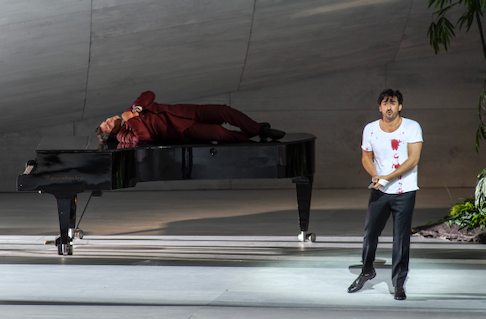 The piano as a tomb (the first, failed poisoning of Boccanegra), with Adorno
The piano as a tomb (the first, failed poisoning of Boccanegra), with Adorno
In keeping with the scope of the production Italian baritone Luca Salsi was a very feeling father and a sensitive patriot and statesman in warm and strong voice. Latvian soprano Marina Rebeka has the purity of voice to project the innocence of Amelia and the strength of voice to support her resolve. German bass René Pape found satisfying resonance of voice to meld patrician pride with surprising personal integrity. American tenor Charles Castronovo offered a perfectly sculpted Adorno that gave young Gabriele convincing sincerity as a lover and as a rebel. French baritone André Heyboer as Paolo poisoned the water drunk by Boccanegra with the evil resolve of a despicable baritone, assisted by bass Antonio Di Matteo as Pietro.
Simon Boccanegra was performed in the 2200 seat Grosses Festspielhaus, its vast proscenium width allowing both the monumental tower and a vast slit through which a brilliant blue sea shone at Boccanegra’s death. Completing the exemplary artistic resources employed for this production was the Vienna Philharmonic.
Michael Milenski
Production information:
The Vienna Philharmonic, the Summer Academy of the Vienna Philharmonic (stage band), the Concert Choir of the Vienna Staatsoper. Conductor: Vallery Gergiev; Stage Director: Andreas Kriegenburg; Set Design: Harald B. Thor; Costumes: Tanja Hofmann; Lighting: Andreas Grüter; Video: Peter Venus; Dramaturg: Julia Weinreich. Grosses Festspielhaus, Salzburger Festspiele, August 15, 2019 (first of six performances).
image=http://www.operatoday.com/Boccanegra_Salzburg1.png
image_description=Adorno, Fiesco, Boccanegra, Amelia at Boccanegra's death [All photos copyright Salzburger Festspiele / Ruth Walz]
product=yes
product_title=Simon Boccanegra at the Salzburger Festspiele
product_by=A review by Michael Milenski
product_id=Above: Adorno, Fiesco, Boccanegra, Amelia at Boccanegra's death [All photos copyright Salzburger Festspiele / Ruth Walz]
August 17, 2019
Rigoletto at Macerata Opera Festival
Consider first the setting. Macerata is a lovely small city on a hill in Le Marche, a Central Italian region with mountains, coastline, old abbeys, ancient towns, excellent local food and wine, and most other things one finds in heavily touristed Umbria and Toscana to the West. Yet here the audience of over 2000 consists overwhelmingly of Italians, many of them local, along with a small handful of German-speakers vacationing on the Adriatic. As with much that is the best in Italy, one senses that the opera festival is in many respects a regional tradition.
Performances take place in the Sferisterio, an outdoor arena with a curved neo-classical façade of over 50 double columns facing a high wall almost 100 meters long. This unique space was constructed hundreds of years ago for matches of bracciale, an extinct game (a bit like team jai alai) that was then the most popular sport in Italy.
For the last century, the Sferisterio has hosted summer opera. While the repertoire tends to be conservative and predominantly Italian – this year, under the rubric “Red Desire” including Macbeth, Rigoletto and Carmen – the productions make innovative use of the space. From the middle of the arena, at least, the experience is at once aurally and acoustically intimate, because one is never more than 15 rows from the stage, and cinematic, because the field of vision and sound is so broad.
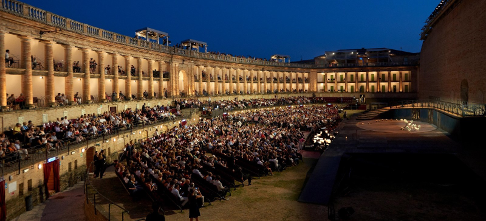
The festival encourages directors to exploit these opportunities to the fullest. Federico Grazzini’s production of Rigoletto, revived from 2015, was marketed as “pulp fiction.” He places the action in a seedy street before the entrance of a dilapidated amusement park from generations past (“Luna Park”). Despite this archaic touch, dim streetlights, park benches, run-down trailers, and soliciting prostitutes, as well as the costumes, suggest an urban misery that is convincingly contemporary.
Yet the staging is also strangely beautiful: the cityscape on stage merges seamlessly with the plain stones of the arena’s back wall and the dark sky above – reminding spectators them that, but for one indoor scene, Rigoletto is one of the few operas to take place entirely in the gloom of night. (The promotional video, shot with the 2015 cast, gives an accurate impression of the production: https://www.youtube.com/watch?v=GBuzKmKpJU0 .)
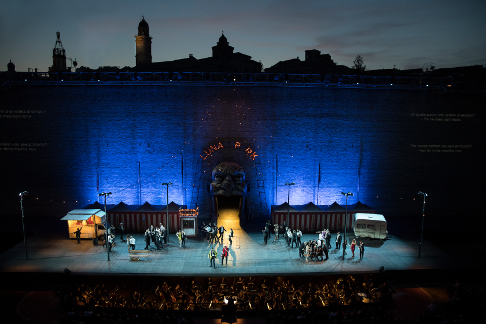
Verdi and Piave’s characters fit right into this bleak reality: Rigoletto is a small-time clown, the Duke a shady gang boss, Sparafucile and Maddalena street criminals working out of a food truck, and Gilda a young country girl facing big-city temptations for the first time. And what production has ever made so much of the cameo role of Giovanna, Gilda’s nanny, whose actions make more sense when she is just trying to scam for a few bucks, like everyone around her?
The musical team also shows contemporary Italy at its best. To be sure, here one does not hear the established global superstars that sometimes perform at Salzburg, Munich, Glyndebourne or even Verona. Yet one can sample a new generation of rising Italian vocal stars, carefully curated and rehearsed by some of the country’s most dynamic young conductors. While Italy is not the singer- and conductor-exporting country it once was, the festival illustrates how rich with talent it remains.
Perhaps most impressive, on the final night of the production, was the leadership of conductor Giampaolo Bisanti. Bisanti is one of a talented and dynamic group of young Italian orchestra directors, with recent credits in Wien, Berlin, and München to his credit. His approach to Rigoletto is old-school in the best sense. Smooth forward momentum, inspired alterations of tempo and tautly idiomatic touches blow away the lethargic caution, leaden tempi and symphonic weight that deaden so much international Verdi conducting today. The regional Orchestra Filarmonica Marchigiana responded solidly, even though the space evidently challenges singers and orchestral musicians alike, who reportedly cannot hear one another at times. Bisanti is a Verdi conductor to watch.
At the head of an impressive cast of young singers stood the commanding presence of Amartuvshin Enkhbat, a 33-year old Mongolian baritone who won the Operalia Competition in 2012 and has been pursuing a career, largely in Italy, ever since.
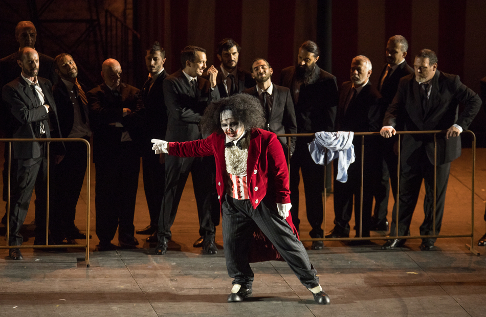
Enkhbat possesses the rarest of all natural gifts in today’s opera world: a real Verdi baritone voice of commanding weight. Even more striking is what he does with it. While he makes a visceral impact at climactic moments, few sing the softer and higher passages of this role with more beauty of tone and emotional impact. Moreover, he sings Italian – a language I am reliably told he hardly speaks – more intelligibly and idiomatically than many native speakers. It all added up to a sympathetic and compelling musical-dramatic characterization: one feels his malice, triumph and pain. Since voices of this type generally do not darken and mature fully until around the age of 40, Enkhbat may well squeeze even more out of the role in future years, particularly at the high points.
Also impressive was the Gilda of Claudia Pavone, a young singer trained in the classic Italian manner: first in the Vicenza children’s choir, then at two nearby conservatories in the Veneto. She broke into the Italian scene with a 2012 competition victory, and since has sung widely – especially as Violetta. Her Gilda was impressively secure from a technical standpoint, each note of coloratura perfectly placed and evenly executed, without strain – especially in the big aria. (The interpolated high note in Act IV was a fine touch as well.) Though she convincingly portrayed innocence lost, it all might have had more impact with a sweeter vocal timbre and a more distinctly personal characterization in the ensembles.
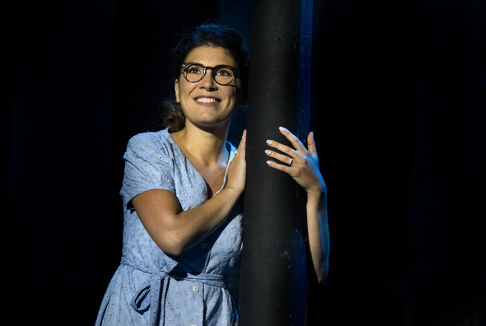
On less than 24 hours’ notice, American Matthew Ryan Vickers, who was performing Don José in Carmen, stepped in to replace the tenor originally schedule to sing the Duke of Mantua. After a rocky start, he performed creditably under the circumstances, though in unidiomatic Italian and with strain at the top of the voice and weakness at the bottom – perhaps a function of having moved on to heavier Puccini since last performing this role.
Young Italian mezzo Martina Belli – raised in Reggio Emilia and trained at Santa Cecilia in Rome, and now moving up from smaller roles in Italian theaters to an international career – does not possess the cavernous voice some expect in the role of Maddalena. Hers is a smaller and more slender sound, more sharply etched with a hint of metal: an instrument with which she creates a believable character. And no Maddalena in my experience has more convincingly looked the role.
As her brother, the professional assassin Sparafucile, Menorca-born bass Simón Orfila adopted a similar approach, singing with graceful bel canto legato, if lacking (at least in this venue) the stentorian depth and menace some bring to the role. Other young Italian singers added solid performances, while the chorus, also local, made the most of its moments, as when it sang and danced through a spirited “Zitti, zitti” that perfectly balanced wit and menace.
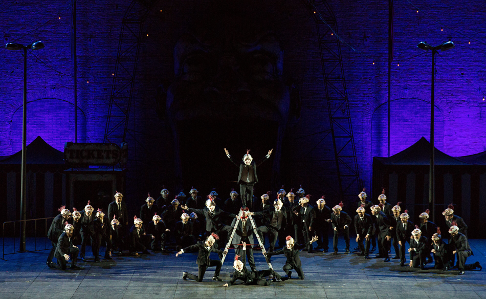
Overall, Macerata’s magical mixture of evocative atmosphere and musical excellence created one the most enjoyable operatic evenings I have experienced in recent years. With new tunnels and highways, Macerata is far easier to reach than it was just a few years ago. I recommend all opera lovers who may be in Italy to consider attending the next summer season, which will highlight Il trovatore, Tosca and Don Giovanni.
Andrew Moravcsik
Cast and production information:
Amartuvshin Enkhbat (Rigoletto); Matthew Ryan Vickers (Il Duca di Mantova); Claudia Pavone (Gilda) ; Simón Orfila (Sparafucile); Martina Belli (Maddalena); Alessandra Della Croce (Giovanna); Seung-Gi Jung (Il Conte di Monterone); Matteo Ferrara (Marullo); Vasyl Solodkyy (Matteo Borsa); Cesare Kwon (Il Conte di Ceprano); Gianni Paci (Usciere di corte); Raffaella Palumbo (Un Paggio della Duchessa). Giampaolo Bisanti (conductor). Orchestra Filarmonica Marchigiana. Coro Lirico Marchigiano “Vincenzo Bellini”. Federico Grazzini (Production Director).
image=http://www.operatoday.com/xOpere-per-Vivaticket_def-03-406x406.jpg.pagespeed.ic.fKdX7YipOg.jpg image_description=Image courtesy of Macerata Opera Festival - Sferisterio Macerata product=yes product_title=Rigoletto at Macerata Opera Festival product_by=A review by Andrew Moravcsik product_id=Above image courtesy of Macerata Opera Festival – Sferisterio MacerataBBC Prom 37: A transcendent L’enfance du Christ at the Albert Hall
In addition, there was eloquent choral singing and much to admire from the baton-less French conductor Maxime Pascal whose sinuous movements conjured a giant flying invertebrate seemingly from another planet. But his skeletal frame and exaggerated gestures - hands and arms frequently elongated and swooping over the front strings - brought so much life to this charming and original score.
In an anniversary year when one might have expected to hear La damnation de Faust or even the Grande Messe des morts, both works matching the magnitude of the Albert Hall, L’enfance du Christ was an interesting choice, and one not performed at a Prom since 2003. Given the pastoralism and restraint of L’enfance du Christ, its imaginative elaboration of Christ’s childhood could have disappeared from view in this cavernous venue had everything not been so convincingly and vividly projected. Pascale and his forces fashioned a compelling and mostly hall-stilling atmosphere, the spirit of Berlioz’s boldly conceived music conveyed with such care and affection that my quibble regarding the inclusion of an interval soon vanished.
Of course, Berlioz’s theatrical instincts in this ‘sacred trilogy’ are understated in a work that largely occupies a devotional mood, its dramas gently but tellingly evoked in a series of tableaux where delineation of character is stylised ‘in the manner of old illuminated missals’. Domestic and political resonances are discreetly outlined, yet its few dramatic moments such as Herod’s scene with the fanatical soothsayers and Joseph’s attempts to find shelter create an operatic dimension that simultaneously blurs distinctions of genre.
Regardless of such formal divisions, this performance unfolded from its strange woodwind sonorities with an absolute sureness of touch, the Hallé frequently subdued yet always captivating and providing much of the work’s cinematic detail. Pianissimo strings (placed antiphonally and underpinned by six double basses behind them) brought a haunting intensity to Herod’s restlessness in the ‘Nocturnal March’ and the cabalistic dance was carried off with aplomb. The Overture to Part Two was beautifully shaped, woodwind sparkled in the domestic preparations by a welcoming Ishmaelite family in Sais and a restful Trio for harp (Marie Leenhardt) and two flutes (Amy Yule and Sarah Bennett) brought exceptional musicianship.
Much was enjoyed too from Roderick Williams - always an engaging presence on the platform - doubling as a warm-toned Polydorus and Joseph. His was a well-matched partnership with Julie Boulianne, a French-Canadian mezzo blessed with radiant tones, ideally cast as Mary. It’s a shame Berlioz doesn’t provide her with more vocal opportunities, but the stable duet was a delight, shaped with effortless control and tenderness. Allan Clayton impressed too as Narrator and Centurion, singing with polished tone that seemed gripped by a quasi-religious fervour in the Epilogue. His traversal of Christ’s early years and return to Bethlehem was sung with bewitching tenderness, almost heart-breaking at the lines, ‘O my soul, what remains for you to do but shatter your pride before so great a mystery?’ Equally compelling was Neal Davies as Herod and Father of the Family, delivering every ounce of emotion in the troubled dream sequence; upper notes purring nicely and with just enough security at the bottom of the stave. Whether malevolent or munificent, Davies taps into the core of the role and commands our attention.
The combined singers of Britten Sinfonia Voices and Genesis Sixteen caught the ear as Ishmaelites, soothsayers and shepherds, although the much-loved leaving taking of the Holy family didn’t quite have me gasping for breath, wondering how any choir can sing so quietly. A shame that the quadruple piano marking in the third verse was ignored and the love of the shepherds for the Christ child not as moving as it might have been. Whatever shortcomings there, compensation arrived with an angelic chorus offstage, and the work’s ethereal apotheosis could not have been better judged - the chorus transcendent.
David Truslove
Julie Boulianne (mezzo-soprano), Allan Clayton (tenor), Roderick Williams (baritone), Neal Davies (bass), Maxime Pascal (conductor), Genesis Sixteen, Britten Sinfonia Voices, Hallé
Royal Albert Hall, London; Wednesday 14th August 2019.
Image=http://www.operatoday.com/Prom%2037%20Berlioz.jpg image_description= product=yes product_title=Prom 39: L’enfance du Christ - Maxime Pascale conducts the Hallé product_by=A review by David Truslove product_id=Above: Roderick Williams, Julie Boulianne, Allan Clayton and Neal DaviesPhoto credit: BBC/Chris Christodoulou
Tannhäuser at Bayreuth
Elisabeth had killed herself in the back of a sort of wrecked love bus after seducing Wolfram who, a bit stunned, then sang his hymn to the evening star. Tannhäuser found his way back from Rome, and to Wolfram’s horror tore up the script for the tale’s implicit outcome.
Through all of this (and much, much more) conductor Thielemann insisted on the purity of Wagnerian love, and it prevailed perhaps as never before, a triumph of dramaturgical manipulation that needed the sanctity of the Festspielhaus and its magical acoustic to succeed.
In fact director Kratzer pit the artistically fearsome resources of Wagner’s Festspielhaus against the raw art of a vintage love bus crowned by a performance artist Marina Abramović rabbbit inhabited by the famed (infamous) black drag queen Le Gateau Chocolat, a dwarf named Oscar, and a mezzo soprano named Venus dressed in a sort of circus ringmaster leotard. Not to overlook a clown named Tannhäuser.
Director Kratzer moved seamlessly between a huge filmic world and a particular, theatrical, actors’ world, at first the massive proscenium opening of the Festspielhaus filled with the fleeting hills and trees of Bavaria’s Franconia, hurdling over Wartburg castle, Wagner’s resplendent overture majestically completing the awesome travelogue.
There was then the full stage as theater, only to be filled above with video magnification of the stage below – the massive, magical sounds from the Festspielhaus’ hidden pit uniting the images as one.
Director Kratzer’s conceptual world is fluid. We then find ourselves in front of the Festspielhaus where, among other things there is inherently always a sort of singing contest, not to mention the pilgrims that pass by headed to this temple of art.
There is a crisis. Not only is Tannhäuser homesick for Venusberg but Venus, Chocolate Cake and Oscar invade the Festspielhaus and find their way to the contest to rescue him. Stage management (video projection above stage set) calls the Bayreuth cops who arrive at the Festspielhaus (video above stage set), find the ladder up to the famous façade balcony, crash onto the stage and would have squashed the melée if Elizabeth had not got things under control.
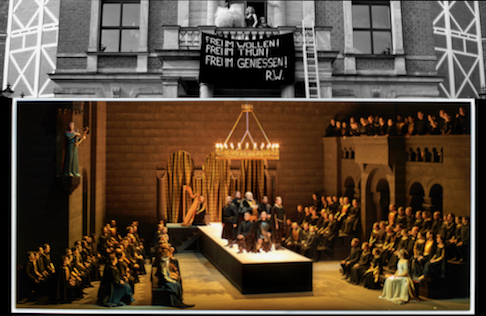 The Act II singers’ contest (lower) while Venus enters Festspielhaus (simultaneous video but incomplete image)
The Act II singers’ contest (lower) while Venus enters Festspielhaus (simultaneous video but incomplete image)
You may think this is comedy. It was not. Conductor Thielemann pit the forces of woodwind purity against strident, screaming violins in unimaginable fortissimos. We knew someone had to call the cops. We needed the ensuing hour long break to catch our breath.
Back then to the now wrecked Venusberg, and director Kratzer’s coup de théâtre – the conceptual wreckage of Elizabeth and Wolfram. But finally there was salvation. Not only for the hero and heroine (both for once), but also of stage director Kratzer who squeaked by with the implicit compliance of Wagner (and a very smart dramaturg) and the total commitment of Maestro Thielemann to the extremes of the score and to the production. Left unknown to me, sadly, is how maestro Gergiev can have dealt with all this in the other performances.
With Richard Wagner we confronted the chaos of creation and the struggle to reconcile raw art with refined art, and we attempted to reconcile the boundless urges of the human spirit with the civilizing force of community and the restraints imposed by love. For a moment at the end we may have succeeded, the pope’s staff finding, maybe, a green leaf or two.
The production was brilliantly cast. Larger than life American heldentenor Stephen Gould made a convincing clown and sang in high Wagnerian style, easily winning the singing contest. Larger than life Norwegian dramatic soprano Lise Davidson countered the tenor in vocal prowess, finding convincing and moving delicacy in her scene of deliverance with Oscar the dwarf, and her seduction of Wolfram.
Russian mezzo Elena Zhidkova was the scene stealing Venus, finding beautiful tone and style when called upon to sing and not to simply drive the love bus and disrupt the stage. German baritone Marcus Escher was deprived of portraying the usual sympathetic Wolfram, sacrificing himself to a far more complex character who needed far more than a pretty voice.
Director Kratzer’s splendid production is site specific to Franconia, Bayreuth and the resources of the Festspielhaus. Make your way there!
Michael Milenski
Cast and production information:
Landgraf Hermann: Stephen Milling; Tannhäuser: Stephen Gould; Wolfram von Eschenbach: Markus Eiche; Walther von der Vogelweide: Daniel Behle; Biterolf: Kay Stiefermann; Heinrich der Schreiber: Jorge Rodríguez-Norton; Reinmar von Zweter: Wilhelm Schwinghammer; Elisabeth, Nichte des Landgrafen: Lise Davidsen; Venus: Elena Zhidkova; Ein junger Hirt: Katharina Konradi; Le Gateau Chocolat: Le Gateau Chocolat; Oskar: Manni Laudenbach. Chorus and Orchestra of the Bayreuth Festival. Conductor: Christian Thielemann; Stage Director:Tobias Kratzer; Stage design:Rainer Sellmaier; Costumes: Rainer Sellmaier; Lighting: Reinhard Traub; Video: Manuel Braun; Dramaturgy: Konrad Kuhn. Bayreuther Festspiele, August 13, 2019.
image=http://www.operatoday.com/Tannhauser_Bayreuth1.png image_description=Tannhäuser and Venus in love bus [Photo © Bayreuther Festspiele / Enrico Nawrath] product=yes product_title=Tannhäuser at the Bayreuther Festspiele product_by=A review by Michael Milenski product_id=Above: Tannhäuser and Venus in love busAll photos © Bayreuther Festspiele / Enrico Nawrath
Opera in the Quarry: Die Zauberflöte at St Margarethen near Eisenstadt, Austria
The quarry is huge, the historic part dates back to the Roman period and houses a 4,780-seater theatre and a 2,500-seater one, and the more modern part still provides stone for St Stephen's Cathedral in Vienna. Access is through a handsome modern building on the edge, followed by a long walk down an elegant ramp which gives superb views and makes you realise that this is no ordinary experience. The site had admirable catering facilities, so visitors vary from those who arrive to picnic, through those sitting at the beer garden like tables for refreshment to those being entertained with wine and canapes in the Lounge. All in all, a complete experience.
Carolin Pienkos and Cornelius Obonya's production of Mozart's Die Zauberflöte opened on 10 July 2019, and we caught the performance on 15 August, towards the very end of the run. Sarastro was the Australian baritone Luke Stoker, the Queen of the Night was Danae Kontora, who studied in Munich, Pamina was Kateryna Kasper, who is a member of the ensemble at Frankfurt, Tamino was the American tenor Michael Porter (making his Oper im Steinbruch debut) and Papageno was Uwe Schenke Primus. Stage design was by Raimund Bauer with costumes by Gianluca Falaschi. Karsten Januschke conducted the Orchester der Budapester Philharmonischen Gesellschaft and the Philharmonia Chor Wien.
The stage is huge (seven times that of the Vienna State Opera), but nothing is permanent (no concrete allowed in the historic quarry) so there is no stage machinery. Instead Bauer's massive set created a series of effective and striking acting areas enlivened by Friedrich Rom's lighting. At the centre was the 'cloud portal' a huge styrofoam structure of balls with a central 'eye' and staircase, through which Tamino and many other characters made their entries. This was also Sarastro's domain, and video projected onto it created different atmospheric effects, from Tamino's serpent, to the heavens themselves. Stage right was a huge black globe which housed a darker domain and on top of which the Queen of the Night made her Act Two appearance. Stage left was a stone portal above which was a huge nest from which Papageno was engaged in stealing birds’ eggs when we first meet him. Far above all this, on the edge of the quarry itself was a series of bird structures taking the 'set' out to the very edge.
A quarry is not a 'dead space' in which to perform opera; there are all sorts of sound reflections from the stone, yet Volker Werner's sound design was some of the best I have come across. No, it was not realistic, but then this was not a typical theatre opera. Instead, we had vivid and immediate sound, with a good sense of direction so you knew who was singing and the off-stage orchestra (with the conductor controlling things via a huge video of himself at the back of the auditorium) was well blended in. Unlike some other outdoor (or semi-outdoor) opera experiences I have had, here I forgot about the amplification and sound design and simply enjoyed the production.
For there was indeed much to enjoy. Most of the roles are double and triple cast, but there was no sense of coming across the second or third cast at the end of a run. Musically, this was a performance most opera houses would have been proud to present. In one respect, I did not see what audiences would see most evenings. To echo the fact that the opera's librettist, Emmanuel Schikaneder (an actor), was the first Papageno, the German actor Max Simonischek was cast in the role. I attended one of the performances at which he did not sing and so saw a trained opera singer.
Pienkos and Obonya had adjusted and modernised the libretto somewhat. As far as I could tell making it more accessible and less arcane, but also altering the balance of relationships so that Pamina was somewhat less passive. Act One ended with her attempting to follow the men into the temple and being stopped, whilst Act Two seemed more about Sarastro's intention to put both Tamino and Pamina to trial. And at the end, the Queen of the Night and her Ladies were not banished or destroyed, but accepted back and the Queen and Sarastro gestured to each other showing a measure of peace and acceptance. During the second act, the words from the United Nations declaration were projected upon the cloud portal. So, whilst modernised, this still had a philosophical bent.
Theirs was modern fairy-tale too. Think Game of Thrones or Stargate. Falaschi's costumes were great fun: the Queen of the Night's head-dress made her look like a giant insect whilst Sarastro and his men wore huge animal heads, very striking indeed. Monostatos' head-dress was a huge spiky thing - no wonder Papageno was surprised! The result looked terrific and gave each group a distinct identity. The three boys, in modernised Knightly armour, got around on Segways and clearly were well trained, singing admirably whilst whizzing round the stage in formation!
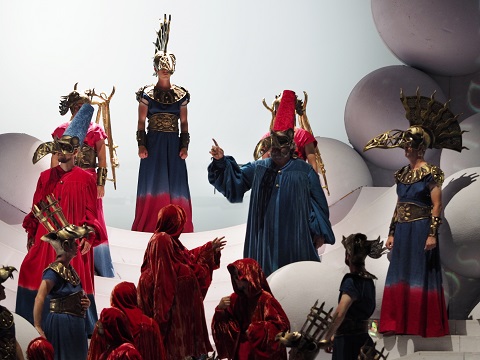 Photo credit: Armin Bardel.
Photo credit: Armin Bardel.
Unlike some outdoor events, the opera was not cut (the dialogue was trimmed) and there was a proper interval (with catering), and to crown the ending there were fireworks!
Kateryna Kasper was a terrific Pamina, one that I would love to encounter in a more intimate production. There was a creaminess to her lyric voice, and a lovely evenness of production which counts for a lot in Mozart along with fine phrasing. She was a spunky Pamina, too, yet tugged the heartstrings (as Pamina must) in 'Ach, ich fühl's'. Michael Porter made an equally fine Tamino, singing with a vibrant lyric tone and engaging naivety. This Tamino was perhaps a bit passive, but both Kasper and Porter succeeded in the tricky task of making us care what happened to these two.
Luke Stoker was an impressive Sarastro, looking and sounding terrific complete with the low notes and a nice ease at the top. He made each of Sarastro's arias a strong musical statement, but there was less sense of Sarastro as a character: he was a bit more of a cypher or symbol who appeared and disappeared. The only element of personality came out in the 'O Isis and Osiris' scene when it became clear that Sarastro wanted to include Pamina in the trials. Danae Kontora's Queen of the Night was similarly symbolic or cypher-like, but perhaps something more sophisticated might be difficult on this scale. But, Oh what a voice she has: both arias were finely sung and Kontora managed to bring the right degree of heft to the coloratura (you don't really want the Queen to sound too much like one of Donizetti's 16 year old heroines) whilst having admirable facility, the ability to colour the notes and make the F in alt seem part of the rest of her voice!
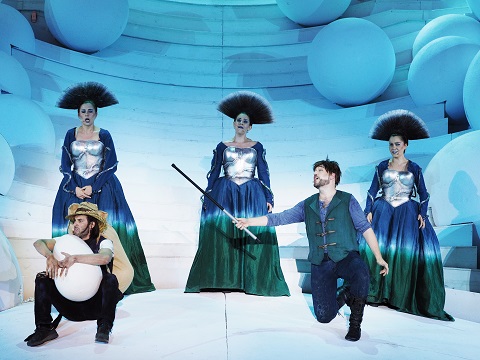 Photo credit: Armin Bardel.
Photo credit: Armin Bardel.
As if to make up for this, the three Ladies (Reka Kristof, Judith Beifuss, Marie-Luise Dressen) had bags of character. They made a strong and vivid trio, projecting character through their music and through action. Much of what they did was choreographed, but each singer brought a nice personal character to her particular Lady. They were comic, yet scary too.
I don't know how much of Papageno was the production concept and how much was Uwe Schenker Primus, and I don't really care. The result was wonderfully enjoyable and engaging. Schenker Primus managed to be full of personality and project his comic character on a large scale. He was a very human Papageno, not half-bird, half-man, but an ordinary man caught up in extraordinary events. And I enjoyed the role musically too; both his opening aria and the duet with Pamina made you care about him. This was a larger-than-life portrayal which worked well on this stage. His Papagena was the delightful Theresa Dax, an equally anarchic character the two duetted engagingly at the end and during the stately finally, they skittered around the stage chasing each other, adding a human element.
Benedikt Nawrath managed to be scary as Monastatos without veering into objectionable caricature, and in Act Two when he approached Pamina and took his helmet off you almost felt sorry for him! Gunter Haumer and Tamas Taranyi did multiple duties as Speaker, Priest and the two Armed Men, and did so admirably. Again, the production made them more symbols than characters, and it was musically that we appreciated them most. The Three Boys were all from the St Florianer Sangerknaben, and Christian Ziemski, Moritz Strutzenberger and Lorenz Laus made the Boys visually and vocally most enjoyable.
The hard-working chorus contributed much to the production both in terms of firm choral tone and stage discipline, and the 55-strong orchestra though hidden away gave much to enjoy too. Conductor Karsten Januschke did an admirable job keeping his disparate forces together and managed to create real music too so that moments like the overture were enjoyable.
This production did not try emulating a smaller scale stage production; instead it re-worked the opera to suit the quarry stage. In so doing, Pienkos and Obonya managed to preserve many of the qualities of Mozart's opera that we love.
Next year, Oper im Steinbruch will be staging another operatic fairy-tale, Puccini's Turandot (8 July to 15 August 2020) with Martina Serafin sharing the title role.
Robert Hugill
Mozart: Die Zauberflöte
Sarastro - Luke Stoker, Queen of the Night - Danae Kontora, Tamino - Michael Porter. Pamina - Kateryna Kasper, Papageno - Uwe Schenker Primus, Papagena - Theresa Dax, Three Ladies - Reka Kristof/Judith Beifuss/Marie-Luise Dressen, Monostatos - Benedikt Nawrath, Speaker/2nd Armed Man - Gunter Haumer, Priest/1st Armed Man - Tamas Tarjanyi, Three Boys - Christian Ziemski/ Moritz Sterutzenberger/ Lorenz Lus (St Florianer Sangerknaben); Musical director - Karsten Januschke, Direction and video - Carolin Pienkos/Corneluis Obonya, Stage design - Raimund Bauer, Costumes - Gianluca Falaschi, Choreography - Kati Farkas, Chorus master - Walter Zeh, Lighting - Friedrich Rom/Veronika Ubermeier, Video - Meida Apparat, Sound design - Volker Werner.
Oper im Steinbruch, St Margarethen in Burgenland, Austria; Thursday 15 th August 2019.
image=http://www.operatoday.com/B%C3%BChnenbild_Wasserprobe_Zauberfl%C3%B6te_c_Raimund_Bauer_B%C3%BChenbild_Media_Apparat_mitCredit.jpg image_description= product=yes product_title= Die Zauberflöte at St Margarethen near Eisenstadt, Austria product_by=A review by Robert Hugill product_id=Above:Photo credit: Raimund Bauer
BBC Prom 39: Sea Pictures from the BBC National Orchestra of Wales
This was a neatly devised programme, and it was conducted with meticulous care and attentiveness to coloristic detail by Elim Chan, making her Proms debut, though the music was sometimes lacking in the freedom and flexibility which is inherent in the broad-breathed sweep of its melodic and formal structures.
Morison, also making her Proms debut, has a dignity and composure on stage which confirms that her relative youth in no way hinders the impression communicated to the (on this occasion, near capacity) audience that this is a ‘star singer’ before them. She took her time to appreciate and acknowledge the warm, extended applause which greeted her arrival on the Royal Albert Hall stage and was evidently both delighted and grateful to be performing with her fellow musicians in the Hall.
Morison’s performance of Elgar’s Sea Pictures was characterised by a certain reserve and perhaps even understatement at times, the lyricism and feeling being conveyed more by clarity of conception and precision of delivery than by emotive effort. She has a wonderfully even and steady voice, which stretches down and upwards with equal ease and smoothness: Morison did not recourse to the ‘alternative’, higher, vocal line that Elgar occasionally offers the non-contralto singer, but exhibited a strong lower register as the sea ‘murmurs her slumber song on the shadowy sand’ (Sea Slumber-Song). However, the RAH is not kind to solo vocalists, and despite Chan’s best efforts the balance was not ideal, with Morison’s mezzo sometimes seeming embedded within the orchestral texture. I’d have liked more sense of the ‘pull’ of the tide, too, from the BBCNOW. The string tenutos in the Tranquillo section of ‘Sea Slumber-Song’ heaved and laboured rather than ebbed and flowed. Morison’s excellent diction countered the RAH’s challenging acoustic though, and there was a magical quality about the repeated ‘good nights’ that rove through hinterland harmonies before finding a comforting resolution.
‘In Haven’ had a beguiling lilt, and Chan exploited the delicate tenderness of Elgar’s orchestration, though perhaps Morison’s approach was a little too forthright, lacking in nostalgic dreaminess. ‘Sabbath Morning at Sea’ had an engaging intensity, with Chan providing a volatile instrumental backdrop, now gentle, now grandiose, with celli and basses evoking the sea’s deep and undeniable strength with urgency and ominous intimation. But, the vocal rise of the final stanza gave us the first real opportunity to relish Morison’s focused and luxuriant upper register, which she used to communicate the ecstasy of the text: “And, on that sea commixed with fire,/ Oft drop their eyelids raised too long/To the full Godhead’s burning!”
‘Where Corals Lie’ was sinuous and permitted flashes of shine and sparkle, with Chan once again creating a transparent instrumental texture, and following the vocal rubatos assiduously. ‘The Swimmer’ evoked both the thrill and the danger of the ocean, pressing forward, the orchestral crests surging ebulliently, the frequent stepwise bass lines brisk and light. The lustre of Morison’s final phrases won deserved cheers from the Prommers’, for this was a performance of considerable control and equanimity.
Morison returned after the interval for the world premiere of Errollyn Wallen’s THIS FRAME IS PART OF THE PAINTING, a BBC commission which was composed specifically for the Scottish mezzo-soprano. Wallen’s career to date has been both eclectic and illustrious: her prolific output includes seventeen operas and she has been the recipient of, among other accolades, the Ivor Novello Award for Classical Music and a British Composer Award. The inspiration for THIS FRAME IS PART OF THE PAINTING is the work of Howard Hodgkin, whose paintings left Wallen (in her own words) “knocked sideways by their emotional force” and intensely moved by their “superior technical mastery of colour, shape and form”. Wallen explains that initially she intended to set poems that were “beloved by Hodgkin. He particularly admired the works of Stevie Smith and James Fenton and his paintings quote their titles”, but in the event “found that my own scribbled words most aptly expressed what I needed for the text”, and used these alongside “a few phrases from Howard Hodgkin himself” and “the tiniest snippets of music he was listening to while painting”.
There’s a lot ‘going on’ in this work, perhaps too much: birth, death, sunrise, sunset; the counterpoint of Byrd’s Mass for Four Voices and strains of Raga Ramkali. As for the text, I think I’d have preferred Stevie Smith to assorted fragments, such as (in the second section ‘Solitude’) “Clock/clock ticks/clock ticks/Solitude/Alone/Clock ticks … ticks … Oh time … Note to self … Note to self- … don’t be lazy”, or (in the section titled ‘Portrait of the Artist Listening to Music’) “Oh ‘with/maximum feeling’/‘with maximum feeling’/‘with maximum feeling’/‘with maximum feeling’”. Wallen is either being mystical or insouciant, ‘meaningful’ or ironic, perhaps all of these things: I wasn’t sure.
With the concluding ‘Sunrise Over Hopkins’, the text turns to matters painterly: “Permanent Green Light/Cadmium Yellow Deep/Permanent Sap Green/Bright Green Lake.” “These are paintings that move and dance with life,” Wallen says, and her own composition does no less, constantly shifting, evolving and burgeoning through myriad colours and textures. Listening to the explosion of energy at start of central movement, ‘Certainty’, I was reminded of Wallen’s dance training by the Stravinskian cross-rhythms, syncopations and driving ostinato fragments, and by the athletic strength of the vocal line which meanders, then, leaps, pushing ever higher: “I fly.” Wallen has articulated the movement and form that is generated by Hodgkin’s colours, and the power of the artist’s palette is translated into a kinetic soundscape.
At the opening of ‘Innocence’, the first of five movements which form a continuous whole, mutating gestures suggest the dipping of a painter’s brush into a swirling pool of colour: harp ripples, woodwind undulations, swelling horns and the constant string flow suggest discovery, a Ravel-like enchantment. The ‘magic’ is enhanced by the melismatic entry of the voice, an extended, ecstatic ‘Ah’ which finds form in the first textual phrase, “A little child”. Morison sang with immense tenderness and poise, “I wish I could sing like my mother’s does”; then the lullaby lilt rocked with increasing passion, before bursting into silence. THIS FRAME IS PART OF THE PAINTING is never still, even in the silences, though there is a notable spaciousness for the voice, aiding the clarity of diction and giving time for Morison to establish a particular sensibility through the weight and colour of her mezzo-soprano. At times, though, I felt almost overwhelmed by the plethora of ideas and moods: thick brass dissonances and hefty percussion evoked a philosophical aura at the start of ‘Portrait of the Artist Listening to Music’, but this was immediately swept aside by Morison’s simply, direct address: “Let me tell you a story.” The ‘interruption’ of Byrd’s Mass at the opening of ‘Sunrise over Hopkins’ was similarly disconcerting: the brass counterpoint was taken up by the woodwind, the strings deepened the texture, then harp, organ, thundering percussion were added, building to a fiery orchestral climax which exploded to leave Morison’s soaring “Love” alone, shimmering around the vast auditorium. Impressive stuff, but quite exhausting too.
Elim Chan, who was the first woman to win the Donatella Flick Conducting Competition, in 2014, dispensed with a baton in the two vocal works, using expressive hand gestures to sculpt the orchestral sound, responding sensitively to Morison’s vocal phrasing. Chan’s technique in the opening work, Mendelssohn’s Hebrides Overture, was by contrast taut and detailed. This was a restrained performance: the tempo was steady and the shadows deep - this sea was swathed in mist, so much so that I struggled to feel the tilt of the waves, the rocking of the wind. Similarly, the sun which warmed the water during the easeful second theme of the cellos and bassoons was a weak light. I felt that there was a loss of tension in the development section and though Chan kept an iron grip on the rhythm arguments this imposed a ‘Classicism’ on music that felt as if it wanted to slip its leash and run headlong into Romantic freedom: where was the driving wind and the lashing spray? Where was the exhilaration, the adventure?
Mussorgksy’s Pictures at an Exhibition (as arranged for orchestra by Ravel) completed the programme. The tempo of the opening ‘Promenade’ was stately, the theme noble, a little pompous perhaps. Again, I missed the flexibility - even imbalance - that is inherent in Mussorgsky’s metrical juxtapositions. ‘Gnomus’, which was inspired by a drawing of a deformed gnome, was threatening, but almost too precise to suggest the restless nerviness of the midget with malformed legs. Beautiful saxophone, horn, bassoon and oboes solos in ‘Il Vecchio Castello’, captured the soulfulness of troubadour’s unrequited love, but the pizzicatos and spiccatos of ‘Tuileries’, though deft, were not particularly spiteful, and the ‘Ballet of the Chicks in Their Shells’ was frenetic rather than flighty. The ‘lumbering ox’ in ‘Bydlo’ - a fine tuba solo - seemed to be striding forth rather than staggering, while the strings did seem as if they might fall over their own feet in the unison episode at the start of ‘Samuel Goldenberg and Schmuÿle’.
The BBCNOW did conjure a fitting edgy liveliness in ‘Marketplace at Limoges’, threatening to erupt into chaos until rudely interrupted by terrifically menacing brass chords at the start of ‘Catacombs’, the eeriness of which Chan transformed into melancholia in the following ‘Cum mortuis in lingua mortua’. By turns fierce and gruesome, ‘Baba Yaga’ was followed by the concluding ‘Great Gate of Kiev’, which was grandiose rather than glorious or triumphant. Fortunately, we had had Catriona Morison - and Elgar and Wallen - to guide us to emotional and expressive heights.
Claire Seymour
BBC Prom 39: Catriona Morison (mezzo-soprano), Elim Chan (conductor), BBC National Orchestra of Wales
Mendelssohn - Overture, ‘The Hebrides’ (‘Fingal’s Cave’); Elgar - Sea Pictures Op.37; Errollyn Wallen - THIS FRAME IS PART OF THE PAINTING (BBC commission, world premiere); Mussorgsky - Pictures at an Exhibition (orch. Ravel)
Royal Albert Hall, London; Thursday 15th August 2019.
image=http://www.operatoday.com/Errollyn%20Wallen%2C%20Catriona%20Morison%20and%20Elim%20Chan.jpg image_description= product=yes product_title=Prom 39: BBC National Orchestra of Wales conducted by Elim Chan product_by=A review by Claire Seymour product_id=Above: Errollyn Wallen, Catriona Morison and Elim ChanPhoto credit: BBC/Chris Christodoulou
August 16, 2019
Odyssey Opera Resurrects Henry VIII
This kick-starts the company’s 2019-20 season featuring concert and staged operas about the great English dynasty of the 16th century: the Tudors. With libretto by Léonce Détroyat and Armand Silvestre, Henry VIII brings to life one of history’s most infamous love triangles featuring baritone Michael Chioldi as King Henry, soprano Ellie Dehn as Henry’s first wife, Catherine of Aragon, and mezzo-soprano Hilary Ginther as Henry’s second wife, Anne Boleyn.
Dedicated to performing neglected works, Odyssey Opera resurrects this little known and intensely powerful work. It premiered in 1883 and received its North American premiere 100 years later in 1983. “ Henry VIII has all the ingredients of a spectacular grand opera,” says Gil Rose, Odyssey Opera’s Artistic and General Director. “It has a sensational historical subject and sweeping vocal melodies and rich orchestral writing. As often happens, much of the real meat of the opera was cut during the initial production. We are thrilled to be working with renowned Saint-Saëns scholar, Hugh MacDonald, to recreate Henry VIII as the composer intended. This is a performance that, for all intents and purposes, represents the world premiere!”
As Saint-Saëns’s fifth of 11 operas, Henry VIII focuses on the earlier phases of the monarch’s troubles with his wives and Rome. Henry is determined to divorce Catherine of Aragon in favor of the beautiful, ambitious Anne Boleyn. The opera contrasts this Great Affair of the English monarch against the public spectacle of the English court. Saint-Saens’s score brilliantly invokes an early Renaissance sensibility replete with period English melodies and Elizabethan court music while remaining firmly rooted in the French grand opera tradition.
Performing the title role of the second Tudor king, Henry VIII, is baritone Michael Chioldi. No stranger to Odyssey Opera, Chioldimade his company debut in the 2014 production of Verdi’s Un Giorno di Regno. According to Opera News, “ Michael Chioldi stood firmly at the center of the evening as Belfiore, the counterfeit king, possessing a powerful and gorgeously rich baritone voice ideally suited to Verdi.” He returned in 2015 for Odyssey’s productions of Vaughan Williams’s Sir John in Love and Jules Massenet’s Le Cid.Playing Catherine of Aragon is Ellie Dehn — her “melting yet clear soprano” impressed The New York Times when she portrayed Catherine with “eloquence and power” at Bard SummerScape 2012. Hilary Ginther brings her “substantial and richly colored instrument (Opera Now )” to the stage as the ill-fatedAnne Boleyn. Ginther was profiled in Opera Now (May 2016) as one of the Top 10 young American singers intent on taking the opera world by storm.
Following the season-opening concert, Odyssey Opera’s 2019-20 season continues with the fully-staged production of Maria, Regina d’Inghilterra (1843) by Giovanni Pacini (November 1 and 3, 2019). Odyssey ushers in 2020 with the world premiere of Arnold Rosner’s The Chronicle of Nine, a semi-staged co-production with the Boston Modern Orchestra Project (February 1, 2020) followed by the fully-staged production of Elisabetta, Regina d’Inghilterra (1815) by Rossini Neapolitan (March 13 and 15, 2020). The season ends with two operas from the 20th century: Gloriana (1953) by Benjamin Britten (April 11, 2020) and Merrie England (1902) by Edward German (June 5 and 7, 2020).
About Odyssey Opera
Founded in 2013 by artistic director/conductor Gil Rose, Odyssey Opera presents adventurous and eclectic works that affirm opera as a powerful expression of the human experience. Its world-class artists perform the operatic repertoire from its historic beginnings through lesser-known masterpieces to contemporary new works and commissions in varied formats and venues. Odyssey Opera sets standards of high musical and theatrical excellence and innovative programming to advance the operatic genre beyond the familiar and into undiscovered territory. Odyssey Opera takes its audience on a journey to places they’ve never been before. odysseyopera.org
image=http://www.operatoday.com/Workshop_of_Hans_Holbein_the_Younger_-_Portrait_of_Henry_VIII_-_Google_Art_Project.png image_description=Portrait of Henry VIII after Hans Holbein the Younger, c. 1537-1547 [Source: Wikipedia] product=yes product_title=Odyssey Opera Resurrects Henry VIII product_by=Press release by Odyssey Opera product_id=Above: Portrait of Henry VIII after Hans Holbein the Younger, c. 1537-1547 [Source: Wikipedia]BBC Prom 32: DiDonato spellbinds in Berlioz and the NYO of the USA magnificently scales Strauss
Reading the booklet before the National Youth Orchestra of the USA’s Prom, I was struck by something written by the young American composer, Benjamin Beckman, in his notes for his work, Occidentalis (2019). In the space of two sentences, he manages to mention human rights, freedom, xenophobia, voting patterns, poverty, religious persecution and immigration. The photograph accompanying his text is headlined ‘Chasing the American Dream’, and the very concept of westward migration into America is a central theme of Beckman’s piece. Today, all of these ideals are under threat - and Beckman’s Occidentalis, a composition written on the basis of what it means to be American, questions all of this.
Of course, the notion a nineteen-year old American composer should have a social conscience isn’t surprising, especially when contextualised through the prism of the century in which he was born and the politics which have shaped it. What is unusual is both the confidence with which he expresses it and the musical direction it takes. The very choice of the word he has used to title his short work, of which this was the European premiere, is rich with allusion: To the nautical maps used, the specific westward direction and even its Latinate origins which takes us through centuries of history. Migration is the bedrock on which American society was founded, which links it to western Europe, but which also gives it unlimited possibilities.
Musically, Occidentalis, if slight in length, is clever. If it most obviously evokes Copland in its opening, it’s strikingly forceful in alluding to one of the most notable émigré composers to take the journey westwards to the United States, Stravinsky. The brass writing for Occidentalis (Beckman is a horn player) is bright in the fragmented fanfares which suggest something of the New World; elsewhere, the impression is that horns and trombones are the confident link on which much of the threads of the work are held together. Strings can be rich in their depth, and woodwind are like kaleidoscopic fractals. Beckman - at least in this piece - is a composer who doesn’t look to the style of Adams or Glass, but backwards towards Howard Hanson.
The size of the orchestra for Occidentalis is vast; Berlioz, in his Les nuits d’été, uses a much smaller sized one. It’s clearly the case that the National Youth Orchestra of the USA can play supremely well at either end of this of orchestral spectrum - though the brilliance of their playing during the Berlioz songs was often quite extraordinary, even ravishing. In fact, the whole performance was so rich, so intense it was almost too much to bear at 11am on a Sunday morning. Much of this had to do with the mezzo-soprano, Joyce DiDonato, a singer who really takes us on a journey not necessarily into, but completely through, the music she sings. She forces audiences (much as Haitink could sometimes do with the Adagio of Mahler’s Third) to hear with such rapt silence, to draw thousands of people into a performance as if they were a single listener that the effect is little short of magical. Often during these songs you could hear a pin drop - the spell only broken by a smattering of unwelcome applause between them.
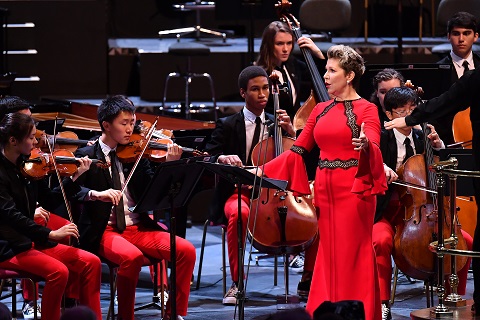 Joyce DiDonato. Photo credit: BBC/Chris Christodoulou.
Joyce DiDonato. Photo credit: BBC/Chris Christodoulou.
If there is one theme which unites this wonderful cycle it is the loss of love, and an aching loneliness. DiDonato is perhaps a little more melancholic than most singers; and almost everything is in anticipation towards the emotional fulcrum of the cycle, ‘Absence’, where the grief and pain are expressed with little sense of resolution. Her lower register is to die for - the words almost loop and spiral around her voice like a dark shadow; it was beautifully tenebrous here. It’s often suggested that the first song in the cycle, ‘Villanelle’ works less well with the mezzo voice - but DiDonato has sufficient freshness and buoyancy in her tone to make it sound zesty and bubbly as it celebrates springtime for the lovers. But even here, there is a suggestion of pensiveness and desolation, of that to come. It works, because when she comes to the ‘Le spectre de la rose’ the phrases are haunted, like half-broken limbs on withered trees moving in a shallow breeze. There was a spectral quality to her voice, perhaps made even more breath-takingly colourful by an orchestra which seemed to play like phantoms against it.
If ‘Sur les lagunes’ is one of the most melancholic of the cycle it is also one of the most evocative, especially through the orchestra. DiDonato brought all the breadth - and depth - of Purcellian lament to Gautier’s poem; Pappano drew the sound of waves washing against the edges of her voice. In ‘Au cimetière’ those ghostly apparitions, the bereavement among the tombs, took wing through the mezzo’s darkened timbre. If DiDonato felt pale, gently reposed and singing through the orchestra rather than over it simply added to the impression that both were walking through the cemetery in shimmering veils. With L’île inconnue’ we return to the more sparkling, feverish intensity of the first song, though with the theme that love is both unattainable and eternal. DiDonato sung it ripe with hope, the upper register of the voice teetering on the edge of a glimmering scintilla of newly discovered freshness - but the careful phrasing suggested otherwise.
This was a performance which in some ways looked indisputably towards Mahler and his song cycles. DiDonata’s voice has all the range, from the bottom to the top, of an organic instrument; in many ways it is a paradox. It can be Romantic - but its horizon goes beyond this into expressionism. Antonio Pappano drew hugely descriptive, lovingly phrased playing from the strings and woodwind of the scaled-down orchestra. By any standards, this was a magnificent performance.
Richard Strauss’s Eine Alpensinfonie saw the National Youth Orchestra of the USA back at full strength for a performance of this mountain-climbing tone poem which was very much - rather appropriately as it happened - a young person’s hike up and down its craggy Alpine summit. Antonio Pappano doesn’t linger in this score, dashing it off in a little over forty minutes. It didn’t always feel this fast, with the opening and closing ‘Night’ sections having a brassy breadth to them which sometimes challenged the orchestra. But at its best, at its most precarious, this was a thrilling and dangerous performance which had the orchestra sliding on the ice, almost losing balance on the glacier and never bothering to take cover from a thunderstorm of earth-shaking intensity.
The Royal Albert Hall is almost made for Strauss’s epic Tone Poems. The wash of sound Alpensinfonie gives off is unforgettable - perhaps no more so than in the twelve off-stage horns, and pairs of trombones and trumpets, here played superbly from the galley by the brass of the National Youth Orchestra of Great Britain - but it’s also a work which reveals much through its inner details. Clearly the conductor matters here, or at least his ear does. I remember Giuseppe Sinopoli’s last Prom (given with the Philharmonia Orchestra in August 1990) of Strauss’s Ein Heldenleben where the detail from the orchestra was simply magnificent. Pappano didn’t really worry about such things; ‘Vision’ really was a mess of musical hieroglyphics and occluded textures, harps pretty much inaudible (they really don’t need to be - and they were on my side of the platform).
But who is ever going to forget the ‘Thunderstorm’ unleashed by these players? There is no more vivid representation of a storm in all music, and this was one of the best played performances of it I have heard. It was shockingly good. A wind machine one could actually hear, incisive timpani playing - the whole thing was just wild and tremendous fun. Amid all this virtuosity, this was also a performance which was not short on taste. Here is an orchestra, not massively over-compensated for in strength of numbers as some youth orchestras tend to be, which has beautiful tonal, and even, weight in the strings and a blended, golden woodwind section. This was an impressive, triumphant performance, to close a memorable Prom.
This concert will be broadcast on BBC Four on Friday 16th August 2019 and is available on BBC iPlayer for 30 days.
Marc Bridle
Joyce DiDonato (mezzo-soprano), Antonio Pappano, (conductor)
Brass of the National Youth Orchestra of Great Britain, National Youth Orchestra of the USA.
Royal Albert Hall, 11th August 2019.
image=http://www.operatoday.com/US%20NYO%20Prom%2032Chris%20Christodoulou_%20%20%289%29%20%282%29.jpg image_description= product=yes product_title=Prom 32: Brass of the National Youth Orchestra of Great Britain, National Youth Orchestra of the USA conducted by Sir Antonio Pappano product_by=A review by Marc Bridle product_id=Above: National Youth Orchestra of the USA conducted by Sir Antonio PappanoPhoto credit: BBC/Chris Christodoulou
August 11, 2019
The Last Opera: The Rake’s Progress in the Life of Stravinsky and Sung Drama
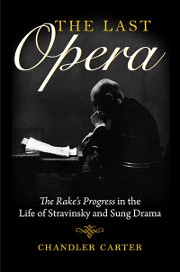 From the fall of 1947 through the summer of 1951 composer Igor Stravinsky and poet W. H. Auden collaborated on the opera The Rake’s Progress. At the time, their self-consciously conventional work seemed to appeal only to conservative audiences. Few perceived that Stravinsky and Auden were confronting the central crisis of the Modern age, for their story of a hapless eighteenth-century Everyman dramatizes the very limits of human will, a theme Auden insists underlies all opera. In The Last Opera, Chandler Carter weaves together three interlocking stories. The central and most detailed story explores the libretto and music of The Rake’s Progress. The second positions the opera as a focal point in Stravinsky’s artistic journey and those who helped him realize it—his librettists, Auden and Chester Kallman; his protégé Robert Craft; and his compatriot, fellow composer, and close friend Nicolas Nabokov. By exploring the ominous cultural landscape in which these fascinating individuals lived and worked, the book captures a pivotal twenty-five-year span (from approximately 1945 to 1970) during which modernists like Stravinsky and Auden confronted a tectonic disruption to their artistic worldview. Ultimately, Carter reveals how these stories fit into a larger third narrative, the 400-year history of opera. This richly and lovingly contextualized study of The Rake’s Progress sheds new light on why, despite the hundreds of musical dramas and theater pieces that have been written since its premier in 1951, this work is still considered the “the last opera.”
From the fall of 1947 through the summer of 1951 composer Igor Stravinsky and poet W. H. Auden collaborated on the opera The Rake’s Progress. At the time, their self-consciously conventional work seemed to appeal only to conservative audiences. Few perceived that Stravinsky and Auden were confronting the central crisis of the Modern age, for their story of a hapless eighteenth-century Everyman dramatizes the very limits of human will, a theme Auden insists underlies all opera. In The Last Opera, Chandler Carter weaves together three interlocking stories. The central and most detailed story explores the libretto and music of The Rake’s Progress. The second positions the opera as a focal point in Stravinsky’s artistic journey and those who helped him realize it—his librettists, Auden and Chester Kallman; his protégé Robert Craft; and his compatriot, fellow composer, and close friend Nicolas Nabokov. By exploring the ominous cultural landscape in which these fascinating individuals lived and worked, the book captures a pivotal twenty-five-year span (from approximately 1945 to 1970) during which modernists like Stravinsky and Auden confronted a tectonic disruption to their artistic worldview. Ultimately, Carter reveals how these stories fit into a larger third narrative, the 400-year history of opera. This richly and lovingly contextualized study of The Rake’s Progress sheds new light on why, despite the hundreds of musical dramas and theater pieces that have been written since its premier in 1951, this work is still considered the “the last opera.”
Get Into Opera with this charming, rural L'elisir
Raghu’s production of Donizetti’s nineteenth-century comic gem, L’elisir d’amore, which set the action in rural Norfolk during World War 1, nestled naturally into the 17th-century barn - built c.1700 as a non-conformist Methodist meeting chapel - and the vibrant singing and playing of an esteemed cast, the talented Into Opera Youth Company and the Istante Collective, led by the galvanising baton of John Andrews, swelled euphoniously into the octagonal vaulted roof of the central atrium.
With the farmers and field-labourers having departed to play their patriotic part in WW1, it falls upon the women to ditch their dresses, don the dungarees and trade the parlour for the pitchfork and plough. When Adina learns of her father’s death, she is roused from her grief by her duty to keep the fields tilled and the harvest reaped. The womenfolk valiantly pull on their wellies, dig up potatoes and hoist milk churns. Having stepped up to the mark and rallied the home front troops, Adina’s not that eager to relinquish her command when Sergeant Belcore arrives on the farm. Nemorino - the loyal, lovelorn farmhand who’s stayed at home to help his beloved Adina - is equally disconcerted by his rival’s military swagger. But, help is at hand in the form of the nattily dressed Dulcamara, a travelling salesman whose magical medicines promise the gullible rustics health, wealth and happiness …
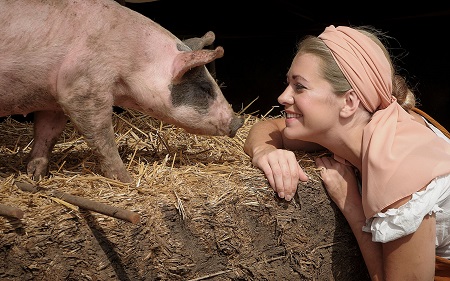 Fleur de Bray (Adina).
Fleur de Bray (Adina).
Designer Lorenzo Russo Rainaldi has a ready-made set at his disposal. All that’s needed to fully immerse us in life on the farm are some dangling horseshoes, a few agricultural accoutrements and wooden crates bursting with ripe apples and verdant carrots. The verisimilitude is aided by Ben Ormerod’s discrete lighting and, especially, Jasmine Ricketts’ imaginatively devised choreography which neatly and slickly conjures the busyness and bustle of farm life within the confines of the fairly small stage. Raghu makes the most of the dimensions of the venue to suggest a wider expanse and her attention to detail is notable. She establishes and sustains a narrative with a consistency and credibility which is sadly all too rare in more familiar, ‘conventional’ opera houses.
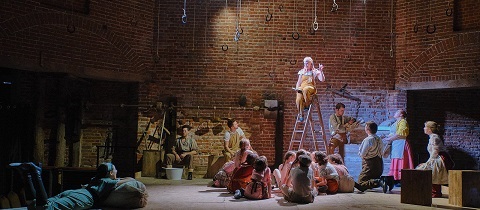 Fleur de Bray (Adina) and ensemble.
Fleur de Bray (Adina) and ensemble.
Raghu’s direction of the Into Opera Youth Company is exemplary. The children burst vigorously and joyfully onto the stage straight from the fields, clutching bunches of freshly harvested carrots, and confidently find their places at the foot of the stepladder upon which Adina is perched, reading a book. They listen avidly to her tales of Tristan and Isolde, grabbing the book to gobble up the amorous adventures, then snatch it from each other, eager for saucy snippets. When Nemorino ventures a peek, an insouciant young hand turns the tome up the correct way. Raghu involves the young singers throughout: they provide Belcore with a sunflower with which to woo Adina, spy on the romantic rivalries and form a hearty-voiced, readymade rural troupe of bridesmaids and page boys dressed, of course, as bunnies, chicks and piglets.
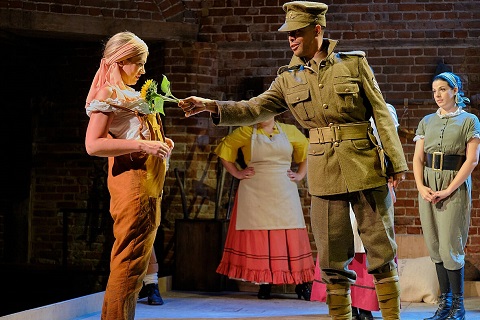 Fleur de Bray (Adina) and Themba Mvula (Belcore).
Fleur de Bray (Adina) and Themba Mvula (Belcore).
The adult chorus - Emily Kirby-Ashmore (soprano), Lara Rebekah Harvey (mezzo-soprano), Gareth Edmunds and James Beddoe (tenor), and Jevan McAuley (baritone) - are managed with no less aplomb (although I wasn’t sure about Raghu’s occasional use of theatrical devices which seemed at odds with the general naturalism). They move fluently around the stage area, working and gossiping, and they dance a nifty nuptial contradance, ducking and diving under the festive bunting. When Adina rejects Belcore’s hasty advances, it’s the confident catching of the apple which the chorus have tossed teasingly amongst themselves that seals her superiority over the Sergeant.
On opening night, the cast gave a strong and consistent performance. Given the challenges presented by the open nature of the performance space, and with the conductor and instrumentalists placed to the left of the stage, the singers’ intonation and ensemble were both impressively accurate.
Fleur de Bray has an attractive but fairly light soprano and in the ensembles her Adina sometimes failed to soar with quite enough gleam and brightness. But, de Bray took immense care over her characterisation and the vocal phrasing. This Adina was determined rather than feisty, and her affection for Nemorino was apparent from the first. ‘Prendi, per me sei libero’ throbbed with heartfelt feeling. I’ve enjoyed Thomas Elwin’s performances with Classical Opera, though looking back it’s interesting to see that I thought that in Haydn’s Applausus at Cadogan Hall in March 2018 he ‘did not always make the extended melodic gestures cohere, but his tone was appealing’, for I’d suggest that the same was true here. Elwin has a sure technique, acts astutely, and can make an individual phrase tell; but ‘Una furtiva lagrima’, though focused and at times affecting, did not convince me that Elwin has yet mastered the art of building the individual units into a cohesive expressive unity. But, I’m probably being unfairly ‘picky’; Elwin’s Nemorino was beguiling and all in the Barn were clearly delighted when the honest lad got his girl.
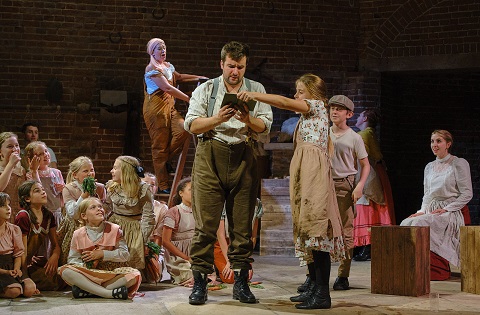 Thomas Elwin (Nemorino).
Thomas Elwin (Nemorino).
Sofia Troncoso made an impressive mark as Giannetta: her mezzo has real punch, clarity and brightness and - in common with all the cast - she acted attentively. As Dulcamara, Andrew Slater blustered a bit at times - more speech than song - though the climaxes and cadences always hit the target with panache. But, he was a genial charlatan, keen to make a quick buck from his vats of vodka and cider aka elixirs, and not unduly manipulative. It was a neat idea to have Dulcamara’s phlegmatic sidekick - a touch of Leporello here, delivered with style by a member of the Youth Chorus - provide the horn player with a sheet of music indicating the required entrance fanfare.
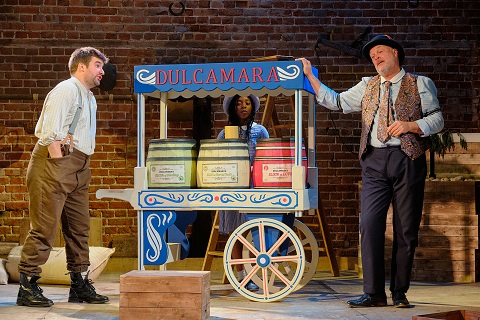 Thomas Elwin (Nemorino) and Andrew Slater (Dulcamara).
Thomas Elwin (Nemorino) and Andrew Slater (Dulcamara).
I had been impressed by Themba Mvula’s 2017 performance in the premiere of Louis Mander’s The Life to Come , with Surrey Opera, and that he so swiftly settled into the shoes of the braggart Belcore says much for the range of his acting. Mvula worked hard - perhaps the effort was a little too evident at times, though admittedly we were seated very close to the stage - and balanced boldness and blunderbuss effectively. ‘Come Parido vezzoso’ was rather plodding; hopefully the tempo picked up for subsequent performances. There’s a fine singing actor here, though, and we’ll undoubtedly be seeing more of Mvula.
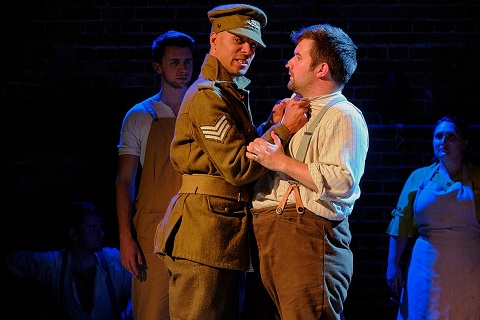 Themba Mvula (Belcore) and Thomas Elwin (Nemorino).
Themba Mvula (Belcore) and Thomas Elwin (Nemorino).
Into Opera were lucky to have conductor John Andrews at the helm: unfussy but meticulous, encouraging but also demanding of high standards, he conducted a fluent performance which sailed forth confidently, the busy finales making absolute musical and dramatic ‘sense’.
Into Opera was launched in September 2017 with the aim of getting ‘more and more people into opera’. Their first project, A King’s Ransom, involved a collaboration with composer Patrick Hawes and hundreds of primary school children across Norfolk. This production ofL’elisir marked the inaugural season of the Norfolk Into Opera Festival. The opening night was preceded by a hog roast in the grounds of The Octagon Park, and followed by a Gala Concert, Opera Unwrapped, with a selection of acclaimed opera singers, including tenor Christopher Turner and soprano Sofia Troncoso, and two further matinee performances of L’elisir. Raghu confidently declares:
“We will create high quality opera experiences which are affordable and don’t break the bank. We are starting a creative revolution to overturn this negative stigma and instead, enthuse communities about the potential of this art form. We want to convince you about the ability of opera to bring people together, to tell compelling stories and to make us think about questions that are relevant and important to the society and world in which we live today.”
I’m pretty sure that anyone who drank the Elixir of Opera in Norwich last week will need no persuading.
Claire Seymour
Adina - Fleur de Bray, Nemorino - Thomas Elwin, Belcore - Themba Mvula, Dulcamara - Andrew Slater, Giannetta - Sofia Troncoso; Director - Genevieve Raghu, Conductor - John Andrews, Designer - Lorenzo Russo Rainaldi, Lighting Designer - Ben Ormerod, Movement Director - Jasmine Ricketts, Into Opera Chorus and Youth Chorus, Istante Collective.
The Octagon Barn, Little Plumstead, Norwich; Thursday 8th August 2019.
image=http://www.operatoday.com/Octagon%20Barn%20title.jpg image_description= product=yes product_title=Norwich Into Opera Festival: L’elisir d’amore product_by=A review by Claire Seymour product_id=Above: Andrew Slater (Dulcamara)All images © Peter Marsh at ashmorevisuals
August 9, 2019
A disappointing Prom from Nathalie Stutzmann and BBCNOW
The key to this came early in Brahms’s Tragic Overture. Stutzmann is disinclined to take a grand, even Romantic, view of what she conducts - tempi start out with such visceral, blazing fire to them they quickly become extinguished. A Stutzmann performance is often in reverse intensity - a quite odd experience, which even over quite short works causes the mind to wander. It’s certainly true that the opening to this overture had energy, almost too much of it - but the impact of the first subject didn’t feel compellingly dramatic because of that. The development, if beautifully shaped, just felt like burning embers and there was really nothing left to ignite a coda that limped towards an undramatic end.
The Prelude and Liebestod from Tristan und Isolde fared somewhat better, though I had completely forgotten this piece was on the program so memories of Sir Colin Davis and the LSO in their Philips recording (even if we try to erase Jessye Norman) were still fresh in my mind from the previous day. Stutzmann doesn’t linger in this music - at all. Bar rests are very brief, almost as if they are non-existent. But on the upside, she whips up a storm of passion which is very powerful. She is riveting to watch, however. Her baton hand exerts formidable control over the orchestra; and yet her left hand literally pulls the sound out of the players. One could quibble with a few things in this performance: The cellos didn’t really sound haunting enough (despite a lot of vibrato to suggest otherwise) and some of the woodwind felt a little lacklustre. But the climax was mighty, built up with extraordinary skill with a lovely glow to the basses that resonated (they very often don’t). I’m not sure the Liebestod itself matched the intensity of the Prelude; those incredible waves of sound that should be there sounded a little short on height, and low on shattering power.
Mozart’s Requiem, which ended this concert, proved most controversial of all. The last two performances of this work I have heard - one in Tokyo (given two weeks after Fukushima), the other in London - have been given for non-secular reasons, and they proved to be overwhelming musical experiences. In every sense, Stutzmann led a performance of the Requiem which felt every inch as if it was a concert. But it was worse than that: It sounded experimental in form and structure, it was often sung poorly and it really didn’t feel much like a requiem at all.
Despite the orchestration of this work, this did not come across as a particularly dark performance. The orchestra, which had given quite beautiful tonal weight in the Brahms and Wagner, here sounded undernourished. But what orchestra could ever find any blend or depth of sound when its conductor takes the opening of the ‘Dies irae’ at such a blistering speed? I’m not sure I have ever heard it taken this fast; the ‘Confutatis’ would suffer a similar fate. Quite what Stutzmann was aiming for here left me genuinely perplexed. The sense it might be the horror, fear or sheer dread of death itself felt distinctly unconvincing especially when more conventionally driven performances of this work convey it so much more powerfully at more metrically precise tempi. But any hope she might draw some radiance or light in the more sepulchral sections of the requiem proved wishful thinking. ‘Lacrimosa’ simply underwhelmed.
As did much of the singing. Given Stutzmann’s own background as a contralto one might have expected a little more attention to the vocal detail; but apparently not. Balance between orchestra and chorus was largely skilfully done. I was less certain placing the soloists behind the orchestra was a benefit, especially since their projection seemed over-amplified. If the singing of the BBC National Chorus of Wales was either coherent or precise one really struggled to tell; pronunciation often came across as opaque, and you rarely got a sense of the voices fusing well. The quartet of soloists were very uneven. The tenor, Sunnyboy Dladla, has the most penetrating upper register - and not in the best way. I really found his upper range difficult to tolerate for any stretch of time; too often his high notes just fractured like broken glass. Oddly, the lower range of his voice is quite beautiful - but it’s just such an uneven tenor. David Shipley’s bass is overly monochromatic for my tastes, and rather unbalanced with it. I didn’t particularly notice much in the way of dynamic nuances in much of what he sang - it all sounded at one level. Fatma Said’s soprano, if rather on the small side, is exquisite, firm at the top and rich in the middle. Kathryn Rudge sometimes struggled to power her mezzo-soprano sufficiently but when she did the richness of her sound is compelling to hear.
Not the most overwhelming of Proms, I’m afraid.
Marc Bridle
This Prom will be broadcast on BBC Four on Sunday 11th August at 7pm. It is also available on BBC iPlayer for 30 days.
Fatma Said - soprano, Kathryn Rudge - mezzo-soprano, Sunnyboy Dladla - tenor, David Shipley - bass, Nathalie Stutzmann - conductor, BBC National Chorus of Wales, BBC National Orchestra of Wales
Royal Albert Hall, London 7th August 2019
image=http://www.operatoday.com/PROM%2026%20Stutzmann%20BBCNOW.jpg image_description= product=yes product_title=Prom 26: Nathalie Stutzmann conducts the BBC National Chorus and National Orchestra of Wales product_by=A review by Marc Bridle product_id=Above: Fatma Said (soprano), Kathryn Rudge (mezzo-soprano), Sunnyboy Dladla (tenor) and David Shipley (bass)Photo credit: BBC/Chris Christodoulou
August 6, 2019
Sandrine Piau: Si j’ai aimé
Sponsored by Palazetto Bru Zane, Alpha Classics produced the ground breaking Saint-Saëns Mélodies avec orchestre with Yann Beuron and Tassis Christoyannis (please read more) which has been described as the “opening of a Pandora’s box ......(on) dozens, if not hundreds, of mélodies sublimely arrayed in sparkling orchestral colours (which) were slumbering on library shelves”.
These mélodies reflect the renaissance of French poetry in the Romantic period, and of contemporary poets like Hugo, Gautier, Banville, Régnier and Verlaine. The enhancement of verse by music created a new genre, taking art song from the confines of private salons to the concert hall. Although grand opéra took centre stage, many composers found, in mélodie an expression of more subtle sensibility. Given the predominance of grand opéra and of singers trained in that tradition, the vocal parts are more elaborate than they would be in a more inward form like German Lieder but are exquisitely refined. These settings focus on voice, eschewing brass and percussion. “But how many nuances these composers could obtain from this palette”, writes Hélène Cao in her notes. “There is no oboe in Aimons-nous (Saint-Saëns) or Ce que dit le silence (Guilmant)…the arpeggios of Saint-Saëns’ Extase are provided by the harp, thus preserving the lightness of a pianistic texture that would have been weighed down by the use of bowed strings”. Indeed, the harp is a distinctive feature in many of these mélodies, more lustrous and liquid, closer to the human voice, and particularly to the female voice.
The delicacy of Piau’s timbre in Saint-Saëns’ Extase (Victor Hugo) is exquisite, almost trembling with ecstasy, the moment of intimacy in the text living vividly on in memory. Her voice is agile, capturing the fluttering fragility in Papillons (Renée de Léché) where a pair of flutes duet, darker winds and strings adding texture. the song ends abruptly, for butterflies die, once the summer is over. In Charles Bordes’s Promenade matinale (Paul Verlaine), the pace is leisurely, evoking a stroll in the morning sunshine. A horn is heard, illustrating “un chemin de gazonque bordant devieux aulnes”, introducing shade, for the dreamer has lost the one he or she had loved. This connects neatly with the well-known Berlioz Au cimetière from Les nuits d’été. In Jules Massenet’s Le Poète et Le Fantôme, to an anonymous text, the vocal line stretches languidly, as the poet addresses a phantom, the soul of the poet’s smiles, ie a memory of the past. The voice of the harp mirroring the voice of the singer. The poem is strophic, its repeating patterns suggesting there will be no resolution. Gabriel Pierné’s Chanson d’autrefois, for chamber ensemble, is like a folk air, being based on the composer’s set of children’s pieces Album pour mes petits amis. Théodore Dubois’ Si j’ai parlé....si j’ai aimé (Henri de Régnier) is poised, “c’est ton ombre que je cherche”.
The upbeat rhythms of Berlioz’s Villanelle from Les nuits d’été mark a transition from songs of lost love to songs of desire and seduction. Théodore Dubois’ Promenade à l’etang (Albert Semain) alternates restraint with exuberant outbursts, intensifying the tension of passion, the pond representing, perhaps, hidden depths. More butterflies in Louis Vierne’s Beaux papillons blancs from Trois Mélodies op 11, this time fluttering happily in warm breezes, the vocal line circulating smoothly as the strings dance and sparkle. In contrast, the sensuous promise of Henry Duparc’s Aux étoiles where violin and flute soar over a background of dark timbred strings. In Alexandre Guilmant’s Ce que dit le silence (Charles Barthélemy), the contrast lies between the sweeping vocal part and the understated orchestral line with its quiet interjections. “Sans bruit, nous permet d’écouter ce que dit le silence”.
The repose of Saint-Saëns’ Aimons-nous (Théodore de Banville) merges into the serenity of Massenet’s Valse très lente, originally for piano, here scored for lyrical winds and strings. Saint-Saëns’ L’Enlèvement (Hugo) was written when the composer was only 13 years of age, but the woodwind melody has finesse. The grave movement from Benjamin Godard’s Symphonie gothique op 23 is followed by the famous Plaisir d’amour, in a transcription by Hector Berlioz after a romance from the 1780’s by Jean-Paul-Ègide Martini.
Anne Ozorio
Click here for the booklet accompanying this recording.
image=http://www.operatoday.com/Sandrine_Piau1.png image_description=Sandrine Piau: Si j’ai aimé product=yes product_title=Sandrine Piau: Si j’ai aimé product_by=Sandrine Piau, Le concert de la loge, Julien Chauvin product_id=Alpha 445 [CD] price=$15.23 product_url=https://amzn.to/33eDqJUMerola’s Striking If I Were You
The piece was the first commission by San Francisco Opera’s esteemed Merola Opera Program that trains promising young artists. If the high quality of the writing and the riveting performance is any indication, opera does indeed have a bright future.
The creators have based their intriguing Faustian tale on the novel Si j’étais vous by Julien Green. Mr. Scheer has unleashed on us a libretto of wickedness, wit, and wisdom that has more disarming twists and turns than a rural Alpine highway. Mr. Heggie has crammed the fantastical score with his usual cornucopia of melodious invention that runs the gamut from jarring confrontations to seductive exhortations to creepy chants to soaring outpourings above the staff that send a chill down the spine in their forceful beauty. If there is anyone writing more knowledgably and gratefully for the singing voice these days than Jake, I don’t know who it is.
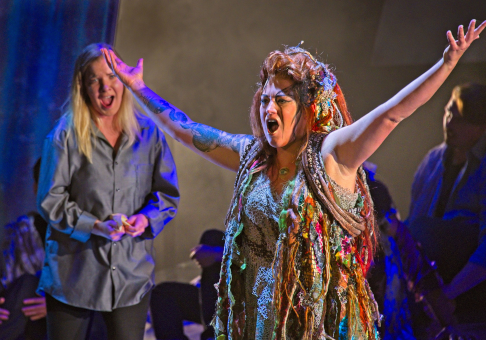 Anne-Marie MacIntosh (left) as Diana and Brennan Blankenship (right) as Brittomara
Anne-Marie MacIntosh (left) as Diana and Brennan Blankenship (right) as Brittomara
The story is really a journey about finding one’s identity. The writer Fabian has been in a fatal car accident, but in the opening scene in the ambulance, the devil in disguise as an EMT zaps him back to life and makes a bargain. He may sing his soul into other people and live forever by assuming their lives or choose to die by living as himself.
The devil in this opus is the beautiful, nefarious, shape-shifting temptress Brittomara, who revels in her destructive misdeeds in the guise of an auto mechanic, a bartender, a hairdresser, a spectral apparition, and the afore-mentioned ambulance attendant. She is omnipresent and the neat trick is that while the audience always knows she is the manipulative devil, the characters on stage do not.
Fabian meets Diana at the auto shop where she is picking up her car and his wrecked auto is on display. Although he met her at college some years earlier, Diana did not remember him or know that he had an interest in her. Fabian finds his journal in his wrecked car, and in it has been added an ancient Hindu phrase that, if he chants it while placing his hands on another person, transfers his soul into that unsuspecting host.
Infatuated with Diana, Fabian wants to find an identity that she could love. In any case, per his bargain with Brittomara, should he ever return to his original body she would take everything from him. We learn very quickly how things will go down with his boss, Mr. Putnam; then with a handsome punk Paul, who he encounters in a bar; then with a strapping policeman who responds to a crime scene; and with others unnamed and too numerous to mention.
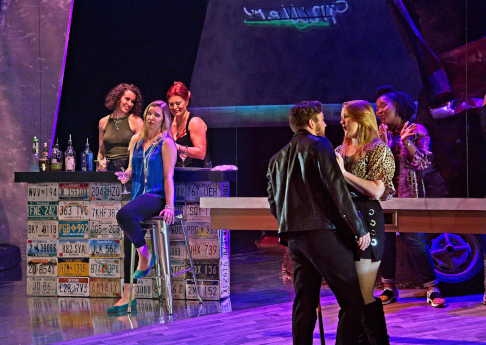
Diana has been commiserating with her bestie Selena, and slowly figures out that she has been coming in contact with Fabian in his various incarnations. The discarded bodies of the other characters collect in a sort of zombie world until something or someone might free them. The opera culminates when Fabian must decide to continue to be someone he is not, or die being himself.
As complicated as this may sound, the script, score, and production elements combine effortlessly to keep the complicated interactions careening along at a breakneck pace of dramatic intrigue and aural pleasure. The composer has pulled off a great effect as each character that gets “taken over,” subsequently assumes a different musical personality once Fabian inhabits them.
While Mr. Heggie composed the score with the young Merola artists in mind, he did not write down to them, nor did he need to. Jake stated that he wanted to challenge them and wanted this piece to be of a richness and sophistication that it will be taken up by other opera companies.
There is a great joy in hearing talented, fresh-voice singers present themselves in new roles. When we see standard repertoire with a long performance history, we still have Leontyne and Placido and Dolora and Jonas in our ears. Anyone assuming such roles is challenged to meet expectations. With a premiere piece like this, singers are liberated to impress us on their own merits, and well, hey not only impressed, they dazzled.
The character of Diana takes the story’s greatest journey, starting out at sea in her life, looking for a good (or good enough) time, and after a wrenching self-discovery, ending up prepared to sacrifice herself to save her friends. From her first naive conversational lines to the chilling simplicity of her final phrases, soprano Anne-Marie Macintosh was engaging and proved to be every bit the anchor of the opera. Ms. Macintosh has a seamless technique, attractive lyric timbre, and an admirable evenness through her extensive range.
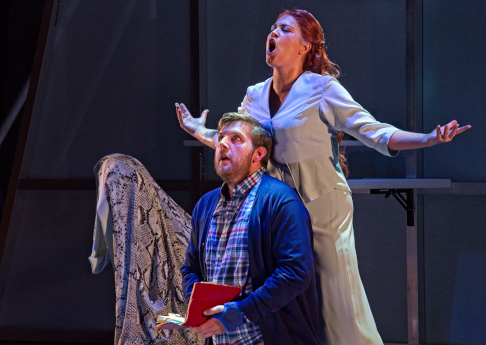 Fabian (Nicholas Huff) is an aspiring writer who becomes ensnared by Brittomara (Brennan Blankenship)
Fabian (Nicholas Huff) is an aspiring writer who becomes ensnared by Brittomara (Brennan Blankenship)
When the tension gets churning, and the orchestra ramps up the stakes, this accomplished singer can ride the moment with ease, hurling out ever ascending phrases of spine-chilling power and beauty. There is nothing in this role that eludes her; and her attractive, easy stage deportment makes it totally believable that Fabian would be smitten with her.
Brennan Blankenship was a marvel of a Brittomara. The role asks her to be manly, womanly, seductive, evil, alluring, funny, multi-accented, and overpowering, often within the space of a few bars. Ms. Blankenship delivered all the dramatic goods in spades, from dead panning one liners to nerve shattering domination. And she sings, too! The mezzo has an arresting arsenal of vocal effects at her command.
She purred worthy of a topflight chanteuse in a sultry number about a symbolic melting ice cube. She sassed and bossed with meaty mid-range dexterity as she set the inexorable rituals in motion. And then she upped the vocal ante with ever poised, arching vocal lines that were as exuberant as they were stinging. Both
Ms. Macintosh and Ms. Blankenship have defined these roles for me and have set the bar very high indeed.
As the real Fabian, tenor Nicholas Huff was suitably self-effacing and anguished in his ultimate decision to live on, whatever the cost to others. His instrument has fine presence and a warm sound, and he deploys it with conviction and musicality. There are one or two of the very highest passages that challenge him at this point in his development, but he nonetheless breezed through role with moxie and professionalism.
As his garrulous, grumpy boss Mr. Putnam, Rafael Porto blustered and bullied with power and punch. His substantial bass-baritone had sheen and allure, especially after he softened his delivery when Fabian took over. His subsequent scene in the bar, where he encounters Diana as Fabian-Putnam had enormous appeal in its gentle awkwardness.
Timothy Murray showed off a well-schooled baritone in the role of the handsome barfly Paul. His swagger and self-importance were mirrored in his solid, burnished vocal tone and mellifluous phrasing. He was also admirably at ease showing off his tattooed physique when a love scene gets interrupted at his apartment, by his drunken girlfriend, Rachel. The latter was vividly portrayed by Edith Grossman, who lavished the role with her sturdy, plummy mezzo and a loose-limbed physicality befitting an overindulgent party girl.
Edward Laurenson’s handsome baritone and engaging presence were a perfect fit for the policeman Jonathan, whose role was all too brief given the quality of Mr. Laurenson’s vocal presentation. The character Selena is Diana’s rock, and Elisa Sunshine’s steady, vibrant soprano made the most of her every moment. Ms. Sunshine also mined every bit of drama out of Selena’s revelatory final encounter with Diana.
Brandon Scott Russell brought a teddy bear lovability to the role of the world-traveling photographer, David. Mr. Russell also imbued the part with honeyed singing, sporting a free-flowing tenor of considerable beauty and accomplishment. The sopranos Chelsea Lehnea and Amber R. Monroe, chirped with characterful ease and obvious enjoyment as two women in the bar.
The chorus performed with stylish assurance, especially in the ritualistic “day of the dead” scene where they sang with riveting power and unity of purpose. Since no Chorus Master is credited, I am going to presume their excellence is owing in no small part to the opera’s conductor, Nicole Paiement.
The diminutive Maestra is a local celebrity in the opera scene and merely her ascension to the podium was cheered. She emphatically lived up to her regard, conducting a throbbing, forward-moving, musically fluid reading that was infused with theatricality. Indeed, Ms. Paiement nurtured an exquisite unity of purpose with the stage and expertly supports and partners her cast of singers. The instrumentation is richly colored and Mr. Heggie’s aural palette was well served by this talented pit band. While the superlative conductor achieved an admirable balance with the vocalists, and while the chamber orchestration is very knowingly crafted, if I had one wish it was for a proper pit in the venerable Herbst Theatre.
The staging could hardly have been bettered. Liliana Duque Piñeiro’s spare, fluid scenery was grounded in a sort of cockeyed, trapezoidal proscenium within a proscenium, and tellingly decorated with an artistic, sculpted wreck of a car on end, that strained to the heavens. An elevated platform stage right is atop a staircase that descends to stage level. All the other settings are aptly suggested by pieces that roll or fly in and the witty economy of expression was one of the strong points of the visuals.
Since the story is happening now, Alina Bokovikov’s spot on costumes look like they are pulled off today’s Outlet Mall racks. Lucas Krech has contributed a moody, jittery lighting design that is not afraid to use shadows to heighten the drama. Peter Torpey has contributed a projection design that does much to establish the sense of place and mood.
Keturah Stickman has directed the proceedings with a wealth of imagination and dexterity. Ms. Strickman has succeeded in not only clarifying the complicated premise but has also invested it with great entertainment value. Her success in creating compelling stage pictures is exceeded only by her triumphant management of complicated, multi-layered relationships. It is difficult to overpraise her achievement in bring If I Were You to triumphant realization.
It is not often that I reach an opera’s end thinking “I could sit through this again right this moment.” But that is how I felt. Such an eminently satisfying artistic event deserves to be replicated and cheered to the rafters, as it was on this occasion.
Merola has done itself proud, its young artists have done it proud, the creative team has done it proud, and as for Heggie and Scheer, they have given us a new opera to cheer and revere.
Not bad for a first commission!
James Sohre
If I Were You
Music by Jake Heggie
Libretto by Gene Scheer
Based on the novel Si j’étais vous by Julien Green
Brittomara: Brennan Blankenship; Fabian: Nicholas Huff; Diana: Anne-Marie Macintosh; Selena: Elisa Sunshine; Putnam: Rafael Porto: Paul: Timothy Murray; David: Brandon Scott Russell; Rachel: Edith Grossman; Jonathan: Edward Laurenson; Two Women: Chelsea Lehnea, Amber R. Monroe; Chorus: Salvatore Atti, Jeff Byrnes, Alice Chung, Anna Dugan, Andrew Dwan, Stefan Egerstrom, Laureano Quant, Hyeree Shin; Victor Starsky; Conductor: Nicole Paiement; Director: Keturah Stickman; Set Design: Liliana Duque Piñeiro; Costume Design: Alina Bokovikov; Lighting Design: Lucas Krech; Projection Design: Peter Torpey; Sound Design: Teddy Hulsker.
image=http://www.operatoday.com/If-I-Were-You_Emerald-Cast_Frank-Wing_2.png image_description=Diana (Anne-Marie MacIntosh) and Fabian (Nicholas Huff) [Photo by Frank Wing] product=yes product_title=Merola’s Striking If I Were You product_by=A review by James Sohre product_id=Above: Diana (Anne-Marie MacIntosh) and Fabian (Nicholas Huff)Photos by Frank Wing
August 5, 2019
The Thirteenth Child: When She Was Good…
A co-production with Odense Symphony Orchestra, this new work is alternately entertaining and stirring, with a dose of “frustrating” thrown in. Given its many strengths, this impressed me as a wonderfully promising work in progress, rather than the gripping thriller its promotion seems to wish it already were.
The opera is inspired by a little-known short story by the Brothers Grimm, “The Twelve Brothers .” The ominous plot encompasses a wide-ranging exploration of good versus evil, highlighting power plays and malevolent political machinations. As is often the case, love wins out, but not before some gripping confrontations and melodious musings. More on the story below.
Ruders has described his music for The Thirteenth Child as “ear candy with chili peppers.” In this case, the candy was a tasty enough treat, but the heat factor of the peppers is in the mild to medium range. Given the percussive, aggressively knotty aural universe of Ruders’ acclaimed dystopian opera, The Handmaid’s Tale, I was expecting something a little more prickly here, given the Gothic possibilities of the Grimm source material.
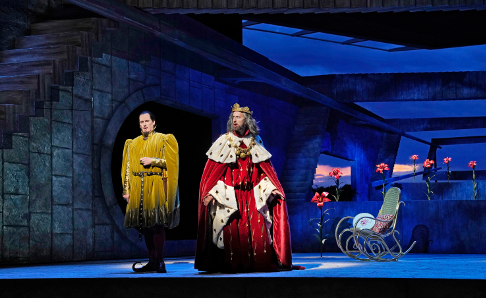 Bradley Garvin (Drokan) and David Leigh (King Hjarne)
Bradley Garvin (Drokan) and David Leigh (King Hjarne)
To be sure, there are somewhat atonal brass snaps and snarls as compelling commentary on the emotional subtext of the main characters. And the percussion section got quite a workout, manning an encyclopedic artillery of bombastic effects. But I was most struck by the prevailing melodious, tonal accessibility of much of Ruders’ writing, and the often shimmering string effects, complemented by haunting wind meanderings.
The vocal writing is characterized by uses of extreme tessiture at both ends of the range. Unlike composer Thomas Adès, who revels in sadistically making singers make ugly and/or incomprehensible sounds beyond the limits of their range, Ruders challenges his vocalists but does not plot to defeat them. His use of several falsetto effects for the two bass-baritones was more well-intended than well-realized. The recurring themes, the accommodating orchestrations, the sinuous melody lines, and the exploration of the exhaustively comprehensive uses of the human voice all combine to make for a fascinating listening experience. And what accomplished singers they are.
As Hjarne, King of Frohagord, bass David Leigh unleashed a torrent of dark, pointed snarls that conveyed powerful determination as well as pitiable self-doubt. His dramatic commitment and authoritative deportment commanded the stage. Tamara Mumford expertly co-anchored the first act as Gertrude, Queen of Frohagord. Ms. Mumford’s dusky, hauntingly rich mezzo-soprano and handsome regal bearing made her a perfect complement to her ill-intended consort. Although both singers successfully delivered affecting serpentine phrases in low-lying stretches, they also were capable of thrilling, sizzling outbursts above the staff. For reasons that eluded me, David Leigh, whose King character dies in Act I, returns to perform the miniscule role of Corbin, Eldest Prince in Act II.
This composer especially likes his singing low and dark, and bass-baritone Bradley Garvin revels in his murderous power grab musings as Drokan, Regent of the Kingdom of Hauven. Mr. Garvin is also called upon to limn rangy phrases with simmering wickedness, and his secure instrument rings out potently in the house throughout the range and at all volumes.
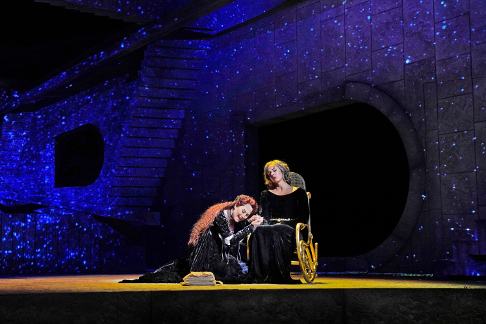 Jessica Jones (Lyra) and Tamara Mumford (Queen Gertrude)
Jessica Jones (Lyra) and Tamara Mumford (Queen Gertrude)
We have to wait until midway in Act I for the appearance of “the thirteenth child,” aka Lyra, Princess of Frohagord, but the delectable soprano Jessica E. Jones makes it decidedly worth the wait. Ms. Jones’ glistening lyric soprano is possessed of a silvery sheen and a sound technique that results in a limpid, touching vocal presentation.
Frederic, Prince of Hauven is her love interest and tenor Joshua Dennis sings the underdeveloped role with secure, honeyed tone that seems to sweeten the higher it climbs. Mr. Dennis’ voice blends enchantingly with Ms. Jones, making their dulcet duets among the evening’s lyrical highlights.
Apprentice Artist Bille Bruley finds a good match for his exuberant, substantial tenor in the relatively short, though important role of Benjamin, Youngest Prince of Frohagord. Mr. Bruley’s poised singing and likable demeanor, combined with his dramatic commitment made him an audience favorite in what is arguably the opera’s most appealing character. Fellow Apprentice Anthony Ciaramitaro showed off a strong tenor in his brief solo utterances given to the role of Toke, Second Oldest Prince. Chorus Master Susanne Sheston’s ensemble of Apprentice Artists was tutored to a fare thee well.
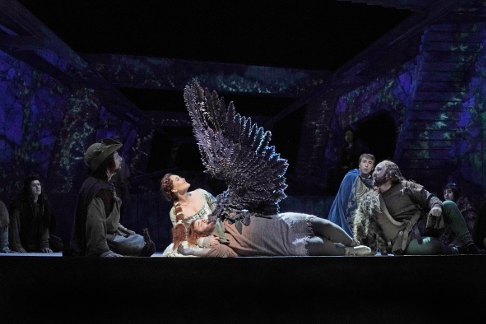 Jessica Jones (Lyra) and Bille Bruley (Benjamin)
Jessica Jones (Lyra) and Bille Bruley (Benjamin)
Although librettists David and Becky Starobin have condensed the fairy tale into manageable chunks, some holes exist in the script that seem to beg that we have filled in those blanks by having read the synopsis very thoroughly. The story in brief:
King Hjarne of Frohagord has 12 sons and has been led to believe that all of them wish him ill. His wife Gertrude is pregnant, and he tells her that if she bears a girl he will kill all the boys and let the daughter alone inherit his throne. To save them, Gertrude sends the boys out into the forest that night and gives them the magical red lilies that protect Frohagord to ensure their safety.
Flash forward 18 years: The King has died, the Queen is critically ill, and their daughter the Princess Lyra has grown to be a young lady. Frederic, a prince from a neighboring kingdom, is interested in her hand but the evil regent, Drokan, wants her for himself. Lyra tends to her dying mother who gives her 12 shirts she made for the boys and as her dying wish, sends the daughter off to look for them.
The Princess does indeed find her grown up brothers and to decorate the celebratory dinner table feast, she assembles a bouquet by cutting 12 flowers, not realizing they are the magic lilies that protected the boys. Her act unintentionally transforms her brothers into ravens (no kidding). Her mother’s spirit mysteriously appears to tell Lyra that she can redeem herself by staying mute for seven years.
Flash forward another 6 years: Frederic (remember Frederic?) finds the silent Lyra and still wants to marry her. But Drokan (remember Drokan?) still wants her too and tries to burn her on a bonfire. After Evil gets vanquished by Good in a brief struggle, all ends (mostly) happily. There is no question that there are great possibilities inherent in this fantastical tale, and many of them were successfully exploited. But there are a couple of dramatic and musical holes and transitions that I would urge the prodigiously talented creators to consider.
In an apparent effort to keep the piece lean and mean, the immediate acceptance of Princess Lyra by her brothers was a “huh?” moment. The men supposedly have a festering resentment of the sister they never met, since her birth caused their banishment, to the point that they commit to killing her should they ever meet her.
She encounters Benjamin first, and once he knows who she is, they immediately bond as besties. When the other brothers approach, Ben says he has to hide her or they will make good on their vow to kill her. About a page and a half later, he decides to reveal her, and the other brothers immediately accept her with no further mention of their avowed revenge.
Another leap of faith is the transformation of the boys into ravens. Only Benjamin appears on the fringes of the set with a big black wing attached to his left arm (only) that tries to show “I’m a bird now. . .get it? “The rest of the aviary is communicated in a swarming projection, one of many excellent effects by projection designer Aaron Rhyne that greatly enhanced the narrative.
The finale is the portion that needs the most redevelopment. A great tragedy befalls at the end, shaking Lyra to her core. In what should be a transition of eventual acceptance that life still must go on, and happiness can still be found, we get instead a rather abrupt dramatic shrug, a few bars of “stuff happens” sentiments, and a really unexpected flourish of a wrap up that was startlingly blunt in its brevity.
The Escher-like set certainly is a thing of atmospheric beauty. It is as though we are lying on the stone floor of an ancient castle looking up the tower in a forced perspective that ends upstage with a filigreed roof that allows us the view of the spectacular sunset beyond. Two long staircases, perhaps to nowhere, flank the structure stage left and right.
Complementing Mr. Rhyne’s masterful projections, York Kennedy has contributed a largely effective, brooding lighting design. Rita Ryack’s diverse costume design runs the fantasy gamut from humble peasants to picture book perfect royal lovebirds, to villainously regal powerbrokers. Ms. Ryack has greatly assisted in conveying the essence of each character, most especially with her lavish, layered attire for Queen Gertrude.
Darko Tresnjak directed the proceedings with a competent hand, although the stage pictures were often predictable, and characters did not always interact with each other as meaningfully as they might have. At a number of key junctures, soloists were singing to the back wall of the balcony rather than the person on stage they were addressing.
Too, there were a few underwhelming moments that could have been more imaginatively realized. The lighting of a (supposed) menacing pyre, the climactic (clumsily performed) swordfight that results in two deaths, the aforementioned (meant to be) ominous bird transformation, all seemed to go for less than they should have. Label them “opportunities missed.”
Saving the very best for last, the top notch SFO orchestra was in sublime form all evening long. Paul Daniel was in firm command of his forces and they responded with playing that was by turns luminous, wrenching, ethereal, chilling, and always dripping with theatrical fervor. Maestro Daniel made as impressive a case as possible for Mr. Ruders’ unique sound palette.
It is tricky to give a new work legs and highly laudable that Santa Fe Opera continues to champion these world premieres. There was so much to enjoy in this first run of The Thirteenth Child, that I hope its creators continue to develop it into the fully-realized, engrossing work it might become.
James Sohre
The Thirteenth Child
Music by Poul Ruders
Libretto by Becky and David Starobin
Hjarne, King of Frohagord: David Leigh; Drokan, Regent of the Kingdom of Hauven: Bradley Garvin; Gertrude, Queen of Frohagord: Tamara Mumford; Frederic, Prince of Hauven: Joshua Dennis; Lyra, Princess of Frohagord: Jessica E. Jones; Benjamin, Youngest Prince of Frohagord: Bille Bruley; Corbin, Eldest Prince: David Leigh; Toke, Second Oldest Prince: Anthony Ciaramitaro; Conductor: Paul Daniel; Director: Darko Tresnjak; Set Design: Alexander Dodge; Costume Design: Rita Ryack; Lighting Design: York Kennedy: Projection Design: Aaron Rhyne; Chorus Master: Susanne Sheston.
image=http://www.operatoday.com/13Child_001.png image_description=Tamara Mumford (Queen Gertrude) [Photo by Ken Howard for the Santa Fe Opera] product=yes product_title=The Thirteenth Child: When She Was Good… product_by=A review by James Sohre product_id=Above: Tamara Mumford (Queen Gertrude)Photos by Ken Howard for the Santa Fe Opera
The Sopranos at Tanglewood
New Englanders are no different. The audience for last weekend’s concert performance of Die Walküre at the Tanglewood Festival seemed somewhat smaller than usual – filling over half the outdoor venue. Yet those present listened with rapt attention throughout and rose in an immediate standing ovation, whooping and hollering, after each act.
The adulation was deserved. This was the most emotionally moving – and, in some respects, musically satisfying – performance of this work I have witnessed in several decades. This is a tribute, above all, to the world-class cast of singers, led by three leading Wagnerian ladies.
The most memorable performance came from the youngest of the three: Oregonian Amber Wagner. Not since the great Austrian soprano Leonie Rysanek retired the role of Sieglinde thirty-five years ago have I heard anyone approach the character with such a combination of power and emotion.
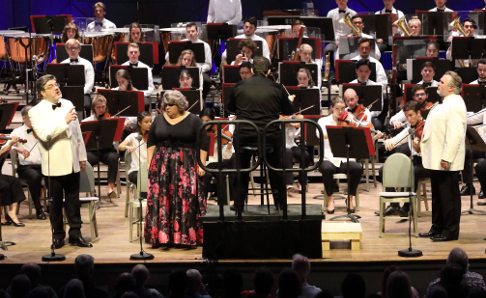 Franz-Josef Selig (Hunding), Amber Wagner (Sieglinde), Simon O’Neill (Siegmund), Nelsons, and TMCO in Act I of Die Walküre
Franz-Josef Selig (Hunding), Amber Wagner (Sieglinde), Simon O’Neill (Siegmund), Nelsons, and TMCO in Act I of Die Walküre
In this era of ever smaller dramatic voices, the astonishing size of Wagner’s voice must be experienced live to be believed. Her command ranges from a girlish yet perfectly focused tone to a massive all-enveloping forte that effortlessly surrounds thousands in a sprawling open-air venue. And, just when one thinks she has reached her limit, she expands the voice further and soars rapturously through musical climaxes.
Singing all out in this way would exhaust most singers, yet Amber Wagner has resources left over to balance power with subtle expression. Sieglinde is perhaps most passionate and sympathetic character in all Wagnerian opera: a battered woman in a forced marriage who, one night deep in the forest, unexpectedly encounters the only person in the world perfect for her. Together they experience the only moments of bliss either will ever know.
Amber Wagner inhabits the extremes of Sieglinde’s trauma and ecstasy with heartbreakingly vividness and vulnerability, yet also finds ways to animate even seemingly insignificant lines – for example, the questions she poses to Siegmund – as if her life depended on it. Throughout Wagner retains a mezzo-like warmth appropriate to this woman of flesh and blood.
One caveat: Wagner does occasionally push her voice too hard. As a result, a few high notes drift sharp and many low phrases begin with a bark akin to a vocal fry. These are odd and (apparently) unnecessary blemishes in a singer so naturally endowed with vocal heft. Banish them and she could be, incontestably, the greatest Sieglinde of the early 21st century.
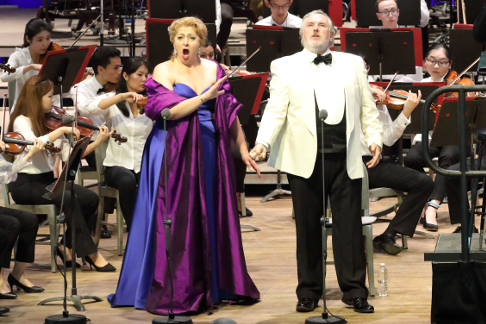 Christine Goerke (Brünnhilde) & Simon O’Neill (Siegmund) with the TMC Orchestra
Christine Goerke (Brünnhilde) & Simon O’Neill (Siegmund) with the TMC Orchestra
The other leading soprano, Christine Goerke, has emerged in the last few years as America’s go-to Brünnhilde, singing the role in Chicago, Houston and, just this spring, at the Met. Whereas Amber Wagner was born with a large and heavy voice, which she spent ten years refining from the bottom up, Goerke has a more lyric instrument, which she has been expanding in size and extending downwards. Beginning a quarter century ago, she enjoyed considerable success in Handel, Mozart and Gluck, then lost that ability as her voice deepened, and recently reemerged as a full-fledged dramatic soprano. If she still lacks the overpowering mass or the silvery edge of some Brünnhilde voices, she compensates with rock-solid technique, plush elegance, and sparklingly clear diction.
Above all, Goerke is an artist of refreshingly heartfelt emotionality. She communicates, facially and vocally, each step in Brünnhilde’s painful transformation from a naïve tomboy to a rebel willing to defy paternal authority for love. Even she seemed to wipe a few tears from her eyes as the final chord died away.
Veteran mezzo-soprano Stephanie Blyth portrayed Fricka, Wotan’s haranguing spouse. Like Amber Wagner, her penetrating voice is a physiological marvel: a massive mezzo with tenor-like low tones that approximate the (today nearly extinct) true contralto timbre. These days she is not, however, given to singing softly, gently or introspectively, so her characterization of Fricka highlights the vengeful anger of a wronged wife far more than the underlying love and loss that motivate it.
Even the famous “Ride of the Valkyries,” with its chorus of eight warrior-maidens, was luxury cast. Top emerging artists sang alongside those with long resumes in leading roles. Especially impressive in the latter category was the clarion yet musical Gerhilde of Kelly Cae Hogan, who has herself portrayed Brünnhilde at major European venues. They raised the roof.
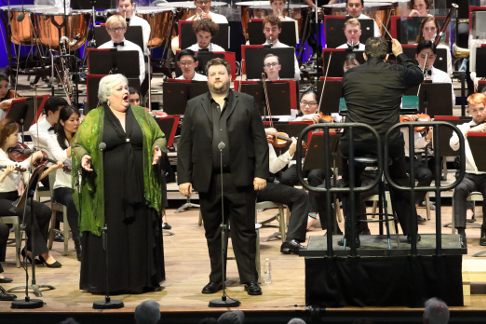 Stephanie Blythe (Fricka) and James Rutherford (Wotan) with Andris Nelsons and TMCO
Stephanie Blythe (Fricka) and James Rutherford (Wotan) with Andris Nelsons and TMCO
While not quite reaching the heights of their female counterparts, three distinguished male singers added some more fine moments. British bass-baritone James Rutherford does not command the full range of Wotan’s heroism (at the top of the voice) or gravity (at the bottom). Yet he compensated by interpreting some passages unusually softly, often to great musical and dramatic effect – as in a heartbreakingly understated account of “Wotan’s Farewell.”
New Zealand-born tenor Simon O’Neill sang Siegmund with uniformly ringing and perfectly supported tone, enthusiastically extending the high notes. His is an intrinsically lighter voice, without the baritonal tinge needed to convey the character’s loneliness and brooding introspection. While elegant and honest, the result remained slightly monochromatic.
Veteran German bass Franz-Josef Selig has sung in top venues worldwide. He presented a solid, well-enunciated Hunding, even if he failed to convey the full brutality and masculine entitlement of this hulking tribal chieftain.
The Tanglewood Music Center Orchestra, comprised of instrumental players aged under 20, played with elegance, enthusiasm and – a few brass bloopers late in the day aside – precision. Particularly lovely were the violas, cellos, clarinets and oboes. To be sure, the sound sometimes lacked the warm veneer of a top pit band. Still, it is a testament to the extraordinary wealth of instrumental talent in the world today that such an ensemble of students can play this well, even though surely few (if any) had ever encountered this challenging score.
On the podium, BSO chief conductor Andris Nelsons cued with clarity while sensitive to instrumental detail. Still, some parts of the score (Act I especially) seemed to lack a bit of overarching architectural unity – perhaps not surprising under the circumstances.
This Die Walküre was a concert performance. Wagner himself famously himself believed that his Der Ring des Nibelungen was multi-media art: he constructed the Bayreuth Festival Theater in order to support an utterly immersive staging. Yet seeing this opera in concert with a cast as expressive as this one, spaced over 24 hours, is a remarkably satisfying experience.
Stripping away the myriad distractions of sets, costumes, technological razzle-dazzle and modern directorial concepts encourages singers to act with their faces and voices, drawing the audience more into their intimate grief and joy. Even the rambunctious Valkyries have an opportunity be genuinely fun-loving sisters – an effect that usually seems a bit ridiculous on a massive stage. Moreover, individual orchestral instrumentalists, which in Wagner often express unspoken emotions, are clearly visible – something O’Neill used to particular effect, gazing at a cello or trumpet as it read his thoughts.
This reminds us that, underneath the mythological overlay of gods and magic, Die Walküre is opera on a human scale. It rests on a series of personal dialogues among family members: an incestuous sister and brother, an unfaithful husband and wife, a stepsister and brother and, at its heart, a loving but increasingly dysfunctional father and daughter. All this came through last weekend with a power and honesty one rarely experiences on the opera stage today.
Andrew Moravcsik
Cast and production information:
Amber Wagner, soprano (Sieglinde); Christine Goerke, soprano (Brünnhilde); Stephanie Blythe, mezzo-soprano (Fricka); Simon O'neill, tenor (Siegmund); James Rutherford, bass-baritone (Wotan); Franz.Josef Selig, bass (Hunding); Jessica Faselt, soprano (Helmwige); Wendy Bryn Harmer, soprano (Ortlinde); Kelly Cae Hogan, soprano (Gerhilde); Eve Gigliotti, mezzo-soprano (Siegrune); Dana Beth Miller, mezzo-soprano (Grimgerde); Ronnita Miller, mezzo-soprano (Schwertleite); Mary Phillips, mezzo-soprano (Rossweisse); Renee Tatum, mezzo-soprano (Waltraute). Andris Nelsons, conductor. Tanglewood Music Center Orchestra.
image=http://www.operatoday.com/Amber_Wagner.png image_description=Amber Wagner as Sieglinde in the first act of Wagner's Die Walküre [Photo by Hilary Scott] product=yes product_title=The Sopranos at Tanglewood product_by=A review by Andrew Moravcsik product_id=Above: Amber Wagner as Sieglinde in the first act of Wagner's Die WalkürePhotos by Hilary Scott
August 3, 2019
Agrippina at the Bavarian State Opera
That Agrippina tells us next to nothing about ancient Rome is neither here nor there. One might say the same of La clemenza di Tito (in whichever version one cares to take it). It benefits also, I think, from being one of Handel’s earliest works. The freshness of his Italian writing is often very much apparent, even though some of the music he recycles – his own, that is, though Reinhard Keiser puts in guest ‘borrowed’ appearances too – perhaps breathes more easily in its earlier manifestations. There is certainly wit in Cardinal Vincenzo Grimani’s libretto; that seems to have appealed to Barrie Kosky, who somewhat oddly speculates in the programme on the cardinal’s sexual orientation on the basis of in-jokes, as he sees them. Again, that is really neither here nor there, but Kosky, for all the intelligence with which he writes otherwise in that programme, seems unable or at least unwilling to prevent himself from inflicting acts of arbitrary silliness. They do little to clarify or to further the action, and serve instead to suggest that it is not to be taken seriously. (If not, then what is the point at all? It is certainly not an intrinsically amusing work.) Silly dancing, that plague of so much vaguely ‘modern’ opera staging, recurs with wearying regularity; likewise gratuitous over-acting, which serves, it seems, only to dare one ‘humourlessly’ to decry it. As for the bizarre transformation of Agrippina at one point into nightclub singer, the less said the better.
Alice Coote. Photo credit: W. Hoesl.There is, moreover, little or no sense of what might actually be at stake in the plot, most notably the very real danger in which Ottone, fallen foul of imperial favour, finds himself. The work’s dramaturgical difficulties are thus heightened rather than addressed, let alone resolved. Deferring an interval until the middle of the second act does not really help. The three-act structure is clear and meaningful; there is no obvious reason to present us with one-and-a-half acts at a time, other perhaps than cost-cutting. The descent of Juno to bless the final arrangement is - somewhat oddly, given the length of the evening – omitted. So too is the ballet that would follow; instead, we have an aria from L’Allegro, Il Penseroso ed Il Moderato. That all does no harm, I suppose; presumably divine intervention stood at odds with whatever the production’s prevailing sensibility of the production is held to be. (Apart from vaguely modernised silliness, I remain at a loss.) Its inclusion might well, though, have offered opportunity for more of a critical, reflective stance than ever emerges.
Ivor Bolton’s tempi were sensible enough, at least for a while. It was not long, though, before one realised that the conductor had little or no sense of harmonic rhythm, and was simply treating the score as recitative-aria-recitative-aria, ad infinitum. Given some arbitrary pulling around of certain numbers, others remaining unpleasantly hard-driven, the work’s longueurs were again heightened rather than addressed. Orchestral playing was generally excellent, the Bavarian State Orchestra’s woodwind especially delectable. If strings would have benefited from warmer tone at time, that was clearly a consequence of Bolton’s allegedly ‘period’ style. Continuo exhibitionism was largely absent, for which, in the present climate, we should all be grateful, even though what remained was often somewhat staid.
Gianluca Buratto and Elsa Benoît. Photo credit: W. Hoesl.There was much to admire in the singing, save for Franco Fagioli’s dreadful squawkathon as Nerone. His bizarre facial expressions were certainly matched by grotesque vocal production. Why anyone should wish to experience either is quite beyond me. The best that could be said was that his display was less atrocious than as Covent Garden’s Idamante a few years ago; at least he sang a few more of the right notes in Munich. Alice Coote offered a generous, beautifully shaded performance in the title role, coloratura a dramatic tool, rather than, as in Fagioli’s case, a mere object of (fallible) display. Elsa Benoît’s Poppea proved finely contrasted in tendency – Kosky’s more girlish conception of her was perhaps a little much – but possessing many of the same musical virtues. Oddly, the one aria in which accuracy of intonation left much to be desired was the one vigorously applauded by a sadly undiscerning audience. (It lapped up Fagioli too.) Iestyn Davies put Fagioli to shame in his unfailingly musical performance as Ottone. ‘Ti vuo’ giusta e non pietosa,’ which here came immediately before the interval, offered all the musical sensitivity and verbal acuity so conspicuously absent chez Nerone. There were otherwise no weak links, Gianluca Buratto’s Claudio perhaps especially impressive in his matching of style and temperament.
Ultimately, though, none of the problems seemingly inherent in performance of Handelian opera seria were solved; a good few were not even acknowledged. Handel is unquestionably a fine composer. Is it too much, though, to ask that we look more to the music – and indeed to the musical dramas – in which he stands at his greatest? Most of the oratorios – pretty much any of them, other than Messiah – remain bizarrely neglected. They offer thoughtful singers, as well as audiences, considerably greater nourishment, on the whole. And can we not at least rid ourselves of this fad with vocal exhibitionism, especially when it fails so manifestly even on its own terms? There is room for Handel and Gluck; a surfeit of the former, however, tends only to have one longing for the ‘noble simplicity’ of the latter.
Mark Berry
Handel: Agrippina
Claudio – Gianluca Buratto, Agrippina – Alice Coote, Nerone – Franco Fagioli, Poppea – Elsa Benoît, Ottone – Iestyn Davies, Pallante – Andrea Mastromi, Narciso – Eric Jurenas, Lesbo – Markus Suihkonen; Director - Barrie Kosky; Conductor – Ivor Bolton, Set Designs – Rebecca Ringst, Costumes – Klaus Bruns, Lighting – Joachim Klein, Dramaturgy – Nikolaus Stenitzer, Bavarian State Orchestra.
Prinzregententheater, Munich; Sunday 28th July 2019.
image=http://www.operatoday.com/BSO%20Agrippina.jpg image_description= product=yes product_title=Agrippina: Bavarian State Opera product_by=A review by Mark Berry product_id=Above: Agrippina: EnsembleImage courtesy of Bavarian State Opera
Prom 18: Das Lied von der Erde
For Prom 18, Edward Gardner conducted the BBC Symphony Orchestra with Leif Ove Andsnes as the soloist in Benjamin Britten’s Piano Concerto, and tenor Stuart Skelton and mezzo-soprano Claudia Mahnke as soloists in Gustav Mahler’s Das Lied von der Erde.
Sir Henry Wood commissioned Britten’s Piano Concerto in 1938 when the young composer (not yet 25) took the solo part at the work’s premiere at the Proms. It received a mixed reception, and in 1946 Britten introduced a revised version, which was that performed at tonight’s Prom. Leif Ove Andsnes made his Proms debut with the work in 1992.
The concerto is notable for the brilliance of the piano writing, and the sense of sardonic wit which flashes through the work particularly in the orchestra. Britten gave each movement a title, ‘Toccata’, ‘Waltz’, ‘Impromptu’, ‘March’.
For the ‘Toccata’ the brilliant piano part pits the soloist against the more sardonic orchestra. Edward Gardner drew some vivid playing from the BBC Symphony Orchestra and Leif Ove Andsnes countered with contained virtuosity. The balance between piano and orchestra was not always ideal, and Andsnes seemed to want to show that there was more to the concerto than mere showy pianism. The second movement ‘Waltz’ started with a haunting and haunted theme in the orchestra, whilst the piano’s initial entry seemed to veer dangerously close to the café! That said, as this movement progressed, veering between the serious and the sardonic, I felt I wanted Andsnes to have a bit more fun. The ‘Impromptu’ started with a beautifully simply piano chorale, and it was the bitter-sweet nature of this which both orchestra and soloist developed. The final ‘March’ was described in the Proms programme book as bringing a military threat, but initially Edward Gardner and the orchestra made it feel more engaging, though a creepy sense of threat came in only to be brushed away by the sparkling wit of the solo part.
Britten’s Piano Concerto is perhaps not as well-known as his Violin Concerto, but here Leif Ove Andsnes, Edward Gardner and the BBC Symphony Orchestra made a strong case for the work, though I wished Andsnes playing had had a more demonstrative sense of fun. After all, this is the work of a young man.
Following the interval, the mood changed for Mahler’s late song cycle. Completed just under 30 years before Britten’s concerto, there is a world (and a world war) between them. Mahler writes for a large orchestra, but what was noticeable about Edward Gardner’s performance was the way things easily evaporated to just a few instruments. There was a transparency and sense of fine detail in the orchestra, a feeling of control that was almost classical for all the intense moments of high emotion.
The orchestral playing in ‘Das Trinklied von Jammer der Erde’ had a brilliance to it which at times threatened to over-balance Stuart Skelton’s exuberant performance, which in later verses became wonderfully trenchant. The dark hues of Skelton’s voice suit the piece, though perhaps a brighter, more forward placed voice would have carried better over the orchestra. After a touching orchestra introduction to ‘Der Einsame in Herbst’, Claudia Mahnke had a lovely way of handling the exposed first entry. Mahnke took quite a straight, direct approach to the music, letting it speak for itself without the emotionalism of the performances I have been typically used to. Whilst she shaped the phrases expressively, her diction as somewhat occluded and we had difficulty following the words even with the printed crib. ‘Von der Jugend’ was light and perky, with Skelton taking engaging delight in the story-telling element here. There was a lively transparency in the orchestra in ‘Von der Schönheit’, though Mahnke’s performance felt a bit over careful, and in the latter sections she never quite matched the vibrancy and passion of the orchestral playing, making rather a sober interpretation. ‘Der Trunkene im Frühling’ started in lively fashion, albeit with moments of tenderness. Skelton was wonderfully involved in the story again, and we began to appreciate the sheer tirelessness of his performance. It is a long time since I have heard a tenor so apparently at east in Mahler’s often cruel tenor writing.
‘Der Abschied’ saw Mahnke finely controlled and quite straight in her phrasing, her understatement making the piece all the more moving. Gardner and the orchestra brought a lovely spaciousness to the long orchestral section before the final stanzas, though again this was not as overtly emotional as some performances. Mahnke brought moments of real intensity and a great sense of joy to the closing verses, with a touching fading away in ‘Ewig… ewig…’ This was a controlled, moving performance, but one which kept extreme emotions in check somewhat, so that it lacked the great sense of catharsis that some performers bring to the piece.
Robert Hugill
Benjamin Britten - Piano Concerto; Gustav Mahler: Das Lied von der Erde
Leif Ove Andsnes (piano), Stuart Skelton (tenor), Claudia Mahnke (mezzo-soprano) Edward Gardner (conductor), BBC Symphony Orchestra
Royal Albert Hall, London; Thursday 1st August 2019
image=http://www.operatoday.com/Claudia%20Mahnke.JPG image_description= product=yes product_title=Prom 18: BBCSO conducted by Edward Gardner product_by=A review by Robert Hugill product_id=Above: Claudia MahnkePhoto credit: Chris Christodoulou
August 1, 2019
Grimeborn 2019: Das Rheingold
For its centrepiece opera at the Grimeborn Festival this year, the Arcola Theatre presented Julia Burbach's staging of Graham Vick and Jonathan Dove's adaptation of Wagner's Das Rheingold. Peter Selwyn conducted members of the Orpheus Sinfonia, with Paul Carey Jones as Wotan, Marianne Vidal as Fricka, Seth Carico as Alberich, Kiandra Howarth as Freia, Philip Sheffield as Loge, Harriet Williams as Erda, Dingle Yandell and Andrew Tipple as Fafner and Fasolt, Kiandra Howarth, Claire Barnett-Jones, Angharad Lyddon as the Rhinemaidens. Designs were by Bettina John and lighting by Robert Price.
The adaptation reduces the opera to a swift 100 minutes, and whilst one missed some of Wagner's repetitions the result is still enormously effective and has a paciness which suited the small space. Fitting 18 instrumentalists and 11 singers into the larger studio at the Arcola Theatre is no mean feat. The orchestra was partially hidden, placed behind a curtain at the back of the stage under the balcony in a space which seemed to descend into the depths in a manner wonderfully analogous to the narrative of Wagner's poem.
A key to any performance of the Ring is the director's conception of who these people are: is this straight story telling about Germanic/Norse gods, a take down of capitalism or what? Bettina John's imaginative set linked the balcony to the main playing area by a staircase made of 'cardboard boxes', with elements of the Ring's iconography drawn on them, and on the floor. This meant that the work opened with what should have been the climax, the vision of the newly created Valhalla (drawn onto boxes piled high on the balcony). The idea of creating it out of the detritus around us, seemed to be central; Burbach's programme note says, 'the story is triggered by a man stepping into a space that looks like something one might find in a Dalston back alley'.
Thus, the opening of the opera wasn't an evocation of the Rhine, but an anonymous man (Seth Carico, who became Alberich) finding a cardboard box full of figures and a pair of headphones and being transported into the story. At the end he reappeared, still with his box of possessions. In between, the logic of this back-story was less apparent. Burbach told the story pretty straight, yet the modern updating and costumes meant that we were unsure whether Paul Carey Jones highly effective Wotan was a Norse God or a ego-maniacal capitalist in contemporary London.
Burbach drew strong and engaging performances from her cast, and performing the piece in such an intimate space with such a cast really brought the piece to life. This was a production which worked wonderfully well in terms of interaction of character on a personal level, and anyone who had never seen the opera before (and plenty of those of us who had) could not help but be drawn in. The singers' diction was excellent; it was easy to follow the German, and there were surtitles, but I thought that singing the piece in one of the good modern English translations was rather a missed opportunity (I learned the Ring in Andrew Porter's excellent translation).
Where Burbach let us down slightly was in Wagner's grander theatrical moments. She seemed to struggle a bit to articulate the rather tricky spaces of the Arcola. Whilst Harriet Williams first entry as Erda, from the audience, was a coup, too many other moments seemed to fail to respond to the music so that the descent into Nibelheim involved much walking around, and for the entry of the Gods into Valhalla there was no rainbow bridge, they simply slipped out of a side door! Similarly, Alberich's transformations relied, perhaps, too much on Seth Carico's mime skills and if you had never seen the piece before you may well have wondered what was going on.
But these are the complaints of someone whose Ring experience started with Goodall at the English National Opera, and the highly theatrical first Goetz Friedrich Ring at Covent Garden. Burbach and her cast did an excellent job of bringing Wagner's story alive and drawing us into these characters, aided by a very high level of singing and instrumental playing.
Paul Carey Jones (the extremely camp Lescaut in Opera Holland Park's recent Puccini Manon Lescaut) will be playing Wotan in the full version of the Ring at Longborough from 2021, and on this showing I can't wait to see him in the role. This was a wonderfully complete portrayal of Wotan as egomaniac, truly self-absorbed in his vision. Carey Jones found an inner strength in his voice, and in Wotan's great pronouncements were wonderfully magisterial, yet there was also a sense of his delusion and separation from the realities of what was going on around him. Carey Jones paced himself very well indeed, so that the final 'Folge mir, Frau!' was thrillingly done, giving us the musical frisson that the staging lacked. As his wife, Marianne Vidal (who is sharing the role in the run with Claire Barnett-Jones) made an elegant Fricka, yet an effective opponent to Carey Jones' Wotan. The two made a handsome couple but Vidal certainly stood up to him. Yet this was quite a warmly elegant portrayal, I have seen more sardonic Frickas (both Helge Dernesch and Rosalind Plowright were wonderful masters of the withering put down here). Physically Vidal was impressive too, negotiating the tricky 'cardboard box' staircase in tall heels!
Philip Sheffield is an experience lyric tenor with a wide range of roles, and dramatically he created a wonderful picture of Loge as the wily eternal trickster. There was less sense of him being an outsider here, Sheffield was dressed similarly to Carey Jones, with no identification with fire. Instead we had the tricksy businessman, who could be seductive too! Unfortunately, Sheffield's voice rather let him down, it had a tendency to dryness in the upper register and he sometimes rather barked the role. Loge is an heroic part (the first Loge was Heinrich Vogl who was a notable Siegmund, Siegfried and Tristan), this rather shows the trickiness in casting the role in a reduced version of the opera. Here Sheffield held our attention, thanks mainly to his dramatic skills.
Seth Carico was the lynchpin of the drama, beginning and ending it, and whilst you might quail at the identification of a homeless man with Wagner's Nibelung dwarf, Carico was impressive in the sheer physicality of his performance. Not that he threw himself around, but this was a performance which embodied Alberich both vocally and in terms of body language and expression. It was a complete performance that certainly made the character vivid in the small spaces. Carico found a strength in his voice for Alberich's curse in the first scene, but by the end he was starting to tire. Whilst Dove's orchestration means that the piece can be cast from lighter voices, they still need the stamina, even in this cut version Alberich is a long role. But Cario impressed to the end, making the most of his resources and giving us a vivid account of the role. This seems to be the first major Wagner that he has done, and if he can build on it he has the makings of a very fine Alberich indeed.
Dingle Yandell and Andrew Tipple as Fafner and Fasolt were workmen plain and simple, there was nothing giant-ish about them though Yandell certainly used his impressive height to great physical effect in the performance. Yandell aptly conveyed Fafner's growing obsession with the Ring, whilst Tipple's very human Fasolt remained enamored of Freia.
Kiandra Howarth doubled as the Rhinemaiden Woglinde and Freia (which perhaps explains why the gods entry into Valhalla was fudged, it wouldn't have been possible for Howarth to be in two places!). She made an appealing Freia, warm and maidenly. Howarth, Angharad Lyddon and Claire Barnett-Jones made a delightful trio of Rhinemaidens, rather sexy and teasing with a lovely blend in their singing.
There is no Froh in this version, but Gareth Brynmor John as Donner impressively fulfilled the dramatic requirements as Fricka's brother, standing up for his sisters' rights, and this fine performance was crowned by a truly thrilling and highly musical account of Donner's summoning of a storm (a great example of how Wagner could crown such theatrical moments with a rattling good tune). Harriet Williams was a stunning Erda, certainly living up to her striking entry standing up from the audience. This was a focused, dramatic and resonant account of Erda's warning, thrilling and commanding and I certainly wanted to hear more of her.
In the pit, largely hidden from view, the 18 members of the Orpheus Sinfonia did wonders under Peter Selwyn's expert direction. Dove's orchestration is wonderful for the way he manages to suggest the fuller version, and there were many incidental instrumental felicities once a few uncertainties had been ironed out. Selwyn was expert at keep his disparate ensemble together in a situation where few of the soloists could see him directly. The result was a pacey affair, entirely apt for the space and the audience.
This production was a terrific achievement, and I am sure it will develop and broaden as the run progresses (there are a total of eight performances until 9 August 2019). I suppose it is too much to hope for that we might get more of the tetralogy in future years!
Robert Hugill
Wagner: Das Rheingold
Wotan - Paul Carey Jones, Wellgunde - Claire Barnett-Jones, Donner - Gareth Brynmor John, Alberich - Seth Carico, Freia/Woglinde - Kiandra Howarth, Flosshilde - Angharad Lyddon, Loge - Philip Sheffield, Fasolt - Andrew Tipple, Fricka - Marianne Vidal, Erda - Harriet Williams, Fafner - Dingle Yandell; Director - Julia Burbach, Conductor - Peter Selwyn, Designer - Bettina John, Orpheus Sinfonia.
Grimeborn Festival at the Arcola Theatre, London; Wednesday 31st July 2019.
image=http://www.operatoday.com/%28c%29%20Lidia%20Crisafulli%20dasrheingold_Grimeborn-33.jpg image_description= product=yes product_title=Grimeborn 2019 at the Arcola Theatre: Das Rheingold product_by=A review by Robert Hugill product_id=Above: Das Rheingold at the Arcola TheatrePhoto credit: Lidia Crisafulli
Die Meistersinger von Nürnberg in Munich
A little more than three years after first seeing David Bösch’s (then new) production of Die Meistersinger von Nürnberg, I looked forward to making its reacquaintance. It struck me then as being, alongside Stefan Herheim’s staging (seen in both Salzburg and Paris ), one of the most significant additions to the repertory. There has not, frankly, been much in the way of competition, offerings from Barrie Kosky and Andrea Moses in particular having proved well-nigh disastrous. How did Bösch’s staging measure up now? In some ways, well. It is certainly more coherent than either of the last too named. However, a good deal of what had made it distinctive, and had decided me to include it in this essay , had disappeared, presumably a casualty of the lack of rehearsal for a brief festival revival. Two at least of its most distinguishing characteristics, the violence at the heart of a reconstructed, provincial ‘community’, and a welcome feminist conception of Eva, had respectively been toned down (more likely, perhaps, unknowingly omitted) and jettisoned. A great pity, that, though perhaps not unlikely in the circumstances: a reminder, at least, that what we see in June and July is not always so very close to what was originally envisaged (and seen).
I shall try, though, not to dwell unduly on what might have been, on what had been: anyone interested in the 2016 first performances, including Jonas Kaufmann, may consult the initial review . The importance of (multi-)media in transmission of music, art more generally, and indeed life, such as it is, more generally, continues to register, for instance in video footage of plans, instructions, flowcharts, and sketches: there is a thin line, perhaps, between the nerd and the pedant. Press coverage of the mastersong competition flicks through, also on video, when the masters first enter, an important point the centenary 1868-1968 (the first year, of course, the work’s premiere, the second year not an unimportant year in the history of the Left), in which Veit Pogner had claimed the prize. That generation has a great deal to answer for, many of us would argue; at least we were spared the sight of Antony Charles Lynton Blair et al. strutting their wares ‘just more one time’. At any rate, this contest for a bartered bride, as much sport as art, and heavily sponsored by ‘Meister Bräu’’, sums things up nicely. Sport, of course, always gets off lightly, entwining nationalism (and/or localism) and toxic masculinity, as it does. No one dare accuse it, though, given the media interests at stake. (Consider British liberals’ obsession with the appalling 2012 Olympics.) Contrast that with the laudable attempts at self-criticism of most important artistic production since the Second World War. That contrast certainly seems implicit here, although the shock violence initially administered by Beckmesser as Marker to Walther now seems ‘mere’ entertainment: a flashing of lights rather than electric shock. Perhaps, though, as everything becomes more mediated, as Trump, Johnson, and other fascists star in their own game show, impervious to political criticism and activity, there is something to be said for such a degeneration too.
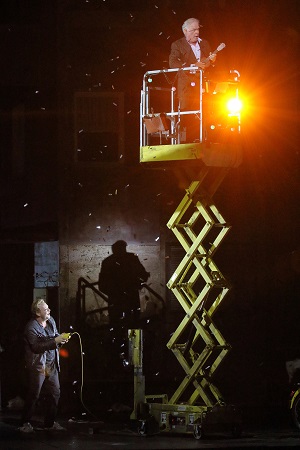
The moment of revolt - or is it further repression - comes through more fitfully in the second act than previously. Can one make a Marcusian case for the apprentices’ thuggery? Probably. Should one? Difficult to say. (One might say the same for Andreas Baader, after all, or the original, far more lethal, RAF.) But the chemistry between Sachs and Eva, the plausibility of their romance, has struck earlier on a very different note. What often seems dramaturgically unconvincing, even odd, here seems quite natural, for want of a better word. Whether that were the case in 2016, I cannot remember, although the artists, Wolfgang Koch and Sara Jakubiak, were the same. Their performances all round were outstanding. If the extremely powerful moment of Eva’s rejection - of the contest - in the third act now seemed to be missing, Jakubiak offered intelligent, vocally alluring singing, as well as accomplished acting. So too did Koch, of course, with a wisdom born of experience not only as Sachs but in many other roles.
Let us return, however, to the production, to the third act. Sachs’s neon-lit van having lost two of its letters, now sighs, in Schopenhauerian style, ‘ACH’. More might have been made of that implication, especially in light of loss of the provincial violence that initially made this act so threatening, so disconcerting. There remain hints, perhaps most notably in the apprentices’ behaviour towards David, homophobic bullying still, I think, implicit. But they are only hints, and would perhaps mostly be noticed by those who had seen the production before. Beckmesser’s return at the very close, to shoot himself, makes far less sense in the absence of such build-up. A pity, as I said, although perhaps there is something to be salvaged in reflection upon continuing degeneration into entertainment.
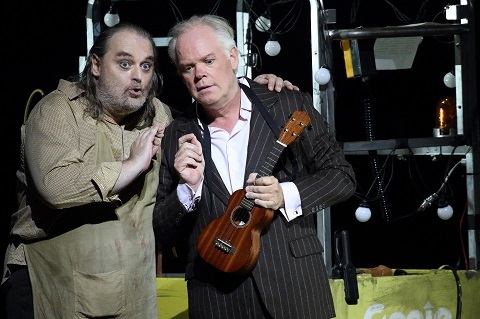
Musically, standards remained high: very high indeed in the case of Kirill Petrenko, the orchestra, and chorus. Of Wagner’s works, this seems very much Petrenko’s best, at least in my experience. Formidable technical challenges - simply marshalling those forces, in a far from simple staging - never seemed to register, however great the art in concealing that art (a Meistersinger virtue in itself). Wagner’s score flowed with all the inevitability of a mighty river. That is never, though, at the expense of detail, overt contrapuntal (and other) virtuosity in which the composer sometimes revels portrayed lovingly, comprehendingly, without degenerating into mere virtuosity itself. It was, moreover, not only in the counterpoint and chorales that Wagner’s Bachian debt was repaid. Wagner’s writing for oboes in particular, played as superlatively as it was here, gave pause to all manner of thoughts concerning connection with Bach’s sacred music too. (Now might we hear a St Matthew Passion or B minor Mass from Petrenko? Even some of the cantatas? Too much to hope? If so, it is surely a victimless crime.)
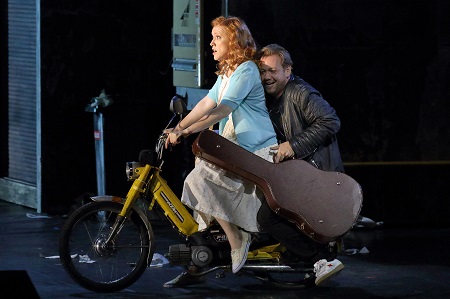
Kaufmann had withdrawn earlier in the week, replaced at very short notice as Walther by Daniel Kirch. There was considerable promise in his performance, although he tired towards the end. At his best in the second act, Kirch showed himself capable of a detailed, variegated performance, both verbally and musically. Earlier on, perhaps still finding his way around the Nationaltheater, he had a tendency to force his voice somewhat, almost as if a Siegfried. There remained, though, much to admire. Martin Gantner’s Beckmesser was first-rate: a sung Malvolio of the highest quality. Allan Clayton’s David proved equally detailed and finely sung, well matched to Okka von der Damerau’s spirited Magdalena. Christof Fischesser made for an uncommonly youthful, virile Pogner, and Milan Siljanov’s Night Watchman suggested a singer from whom we shall be hearing much more soon. More than enough, then, to be going on with until the full revival Bösch’s production unquestionably merits.
Mark Berry
Wagner: Die Meistersinger von Nürnberg
Walther von Stolzing - Daniel Kirch, Eva - Sara Jakubiak, Magdalene - Okka von der Damerau, David - Allan Clayton, Hans Sachs - Wolfgang Koch, Sixtus Beckmesser - Martin Gantner, Veit Pogner - Christof Fischesser, Fritz Kothner - Michael Kupfer-Radecky, Kunz Vogelgesang - Kevin Conners, Konrad Nachtigall - Christian Rieger, Ulrich Eißlinger - Dean Power, Hermann Ortel - Levente Páll, Balthasar Zorn - Ulrich Reß, Augustin Moser - Thorsten Scharnke, Hans Foltz - Roman Astakhov, Hans Schwarz - Peter Lobert, Night Watchman - Milan Siljanov; Director - David Bösch, Conductor - Kirill Petrenko, Set designs - Patrick Bannwart, Costumes - Meentje Nielsen, Video - Falko Herold, Lighting - Michael Bauer, Dramaturgy - Rainer Karlitschek, Revival director - Theresa Schlichtherle, Chorus, Extra Chorus, Orchestra of the Bavarian State Opera.
Nationaltheater, Munich; 27th July 2019.
image=http://www.operatoday.com/Mastersingers%20title.jpg
image_description=
product=yes
product_title=Die Meistersinger von Nürnberg:Bavarian State Opera
product_by=A review by Mark Berry
product_id=All images © Wilfried Hösl